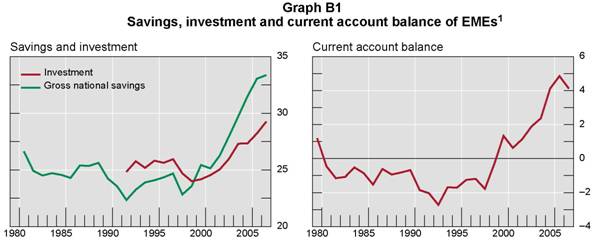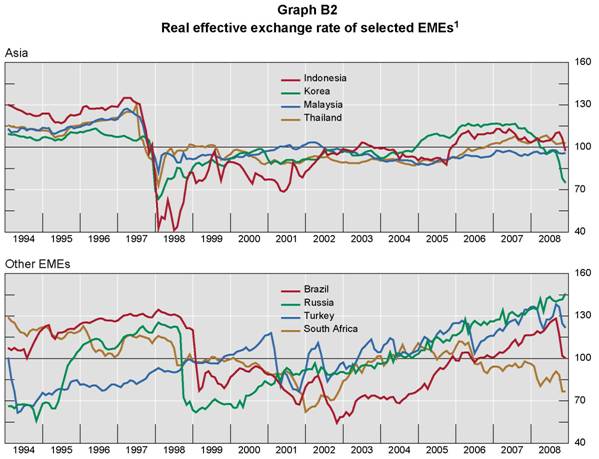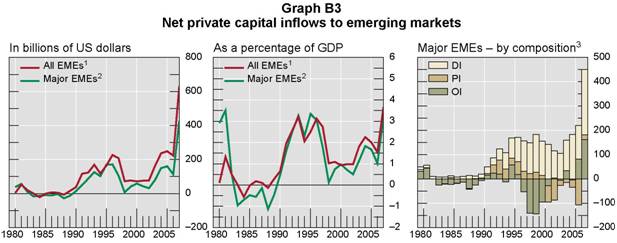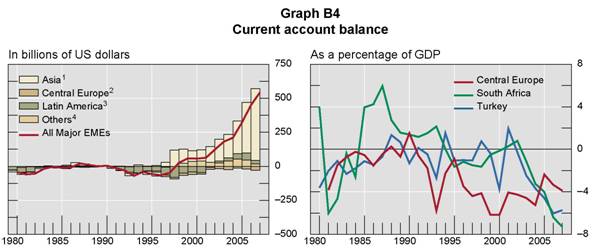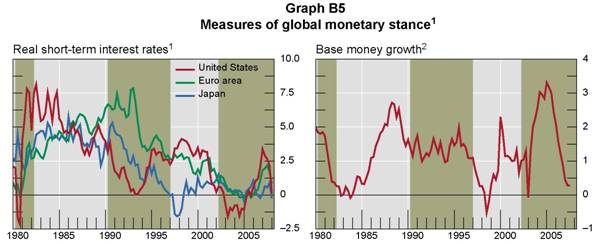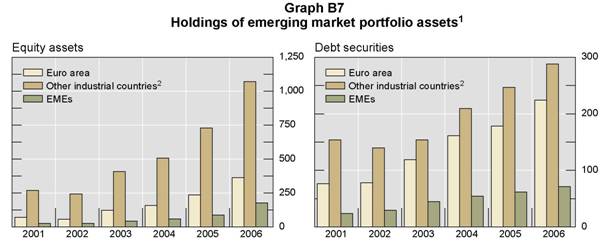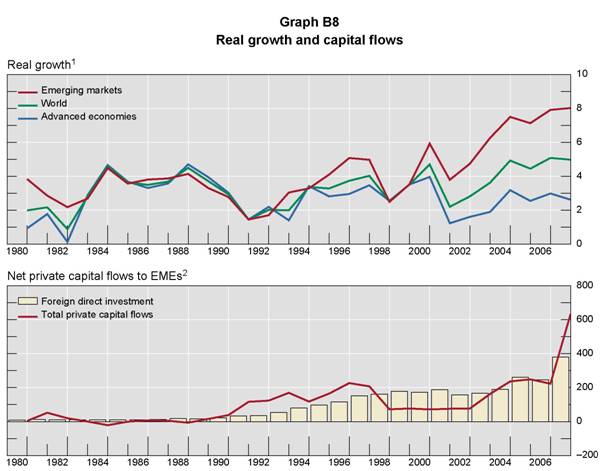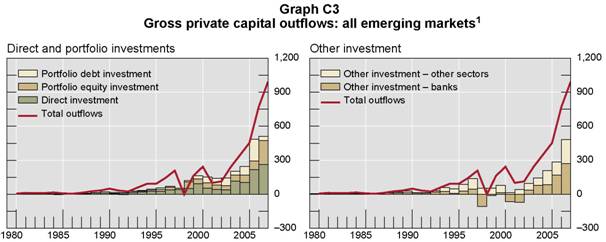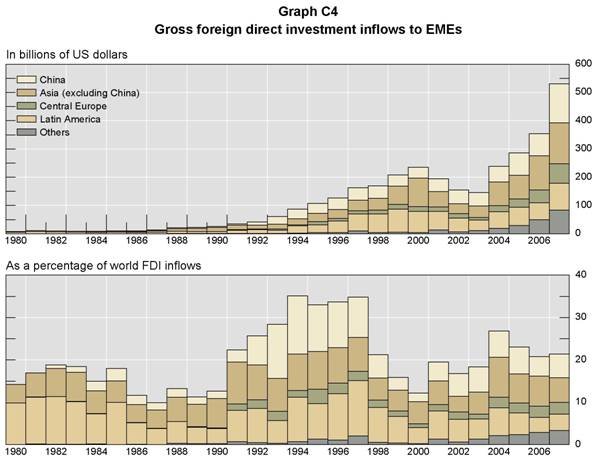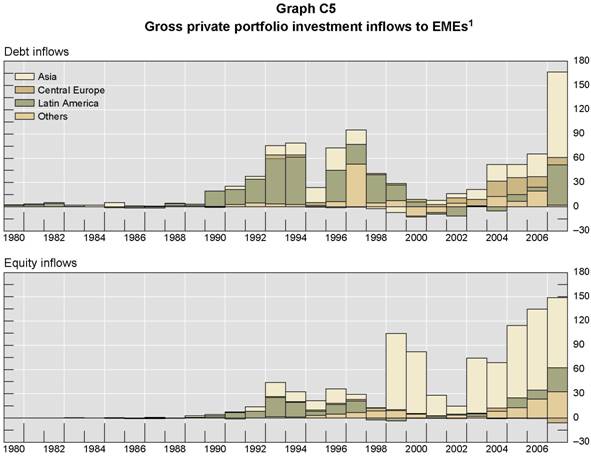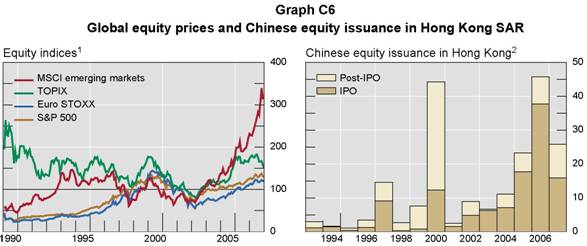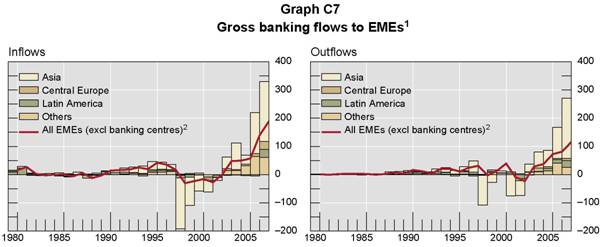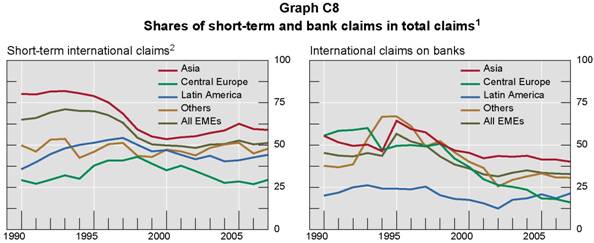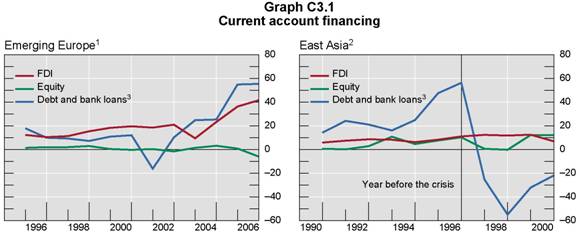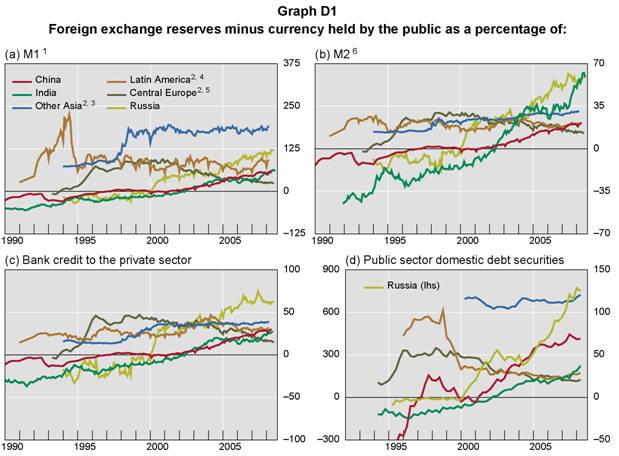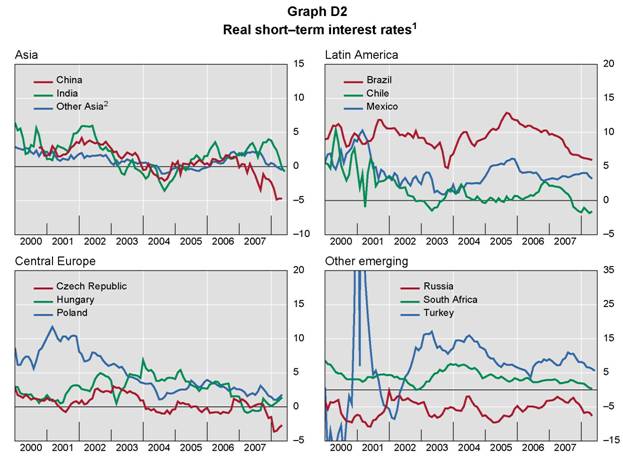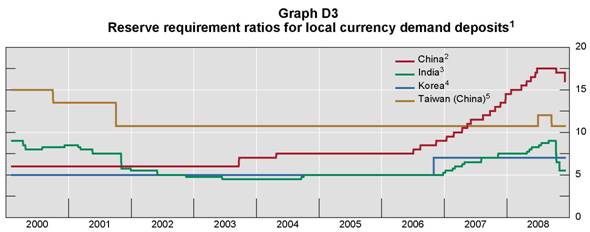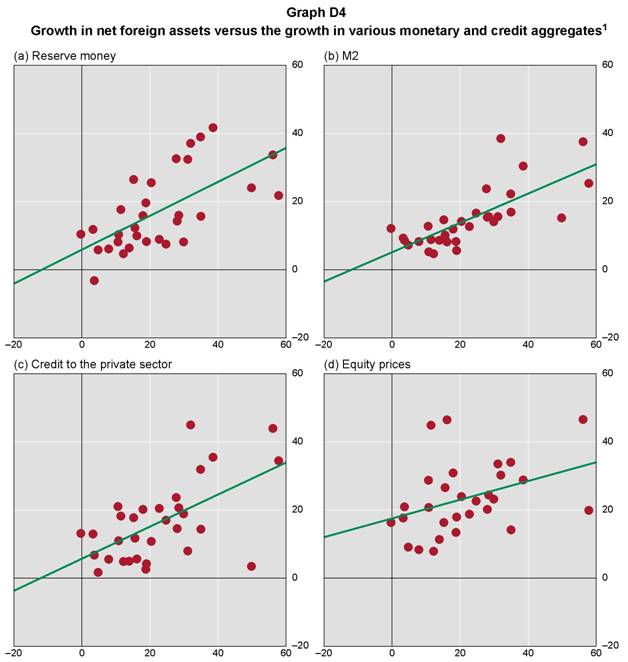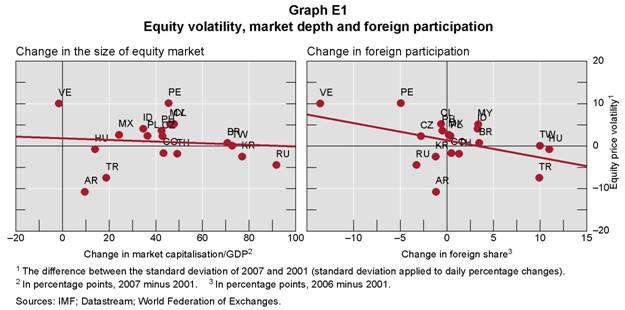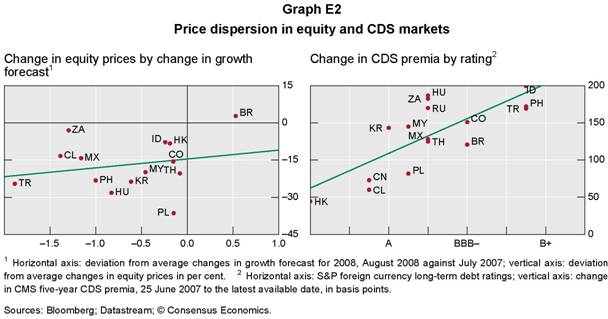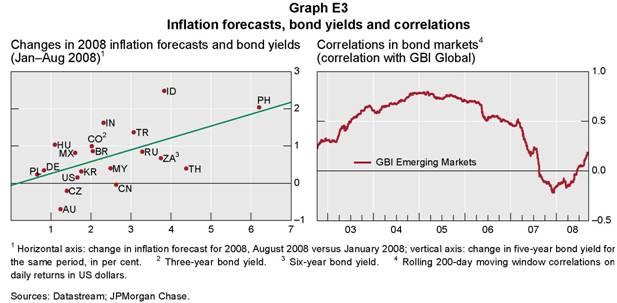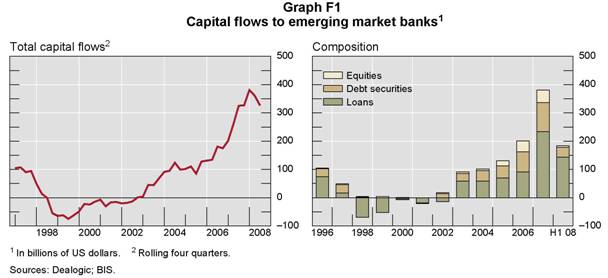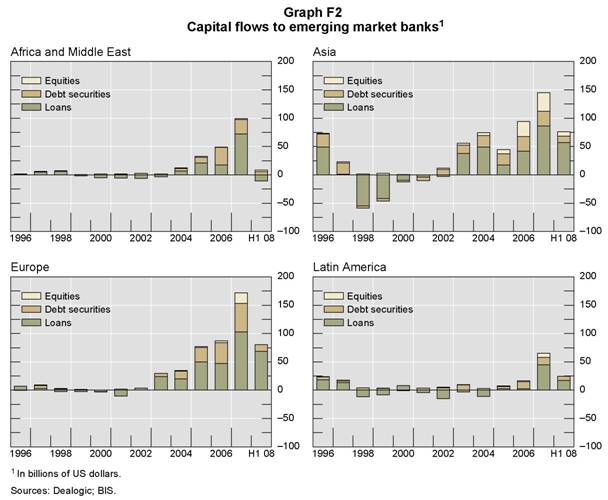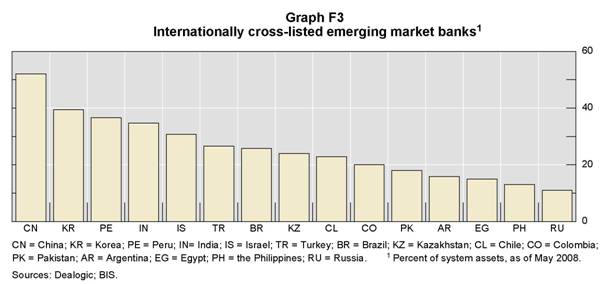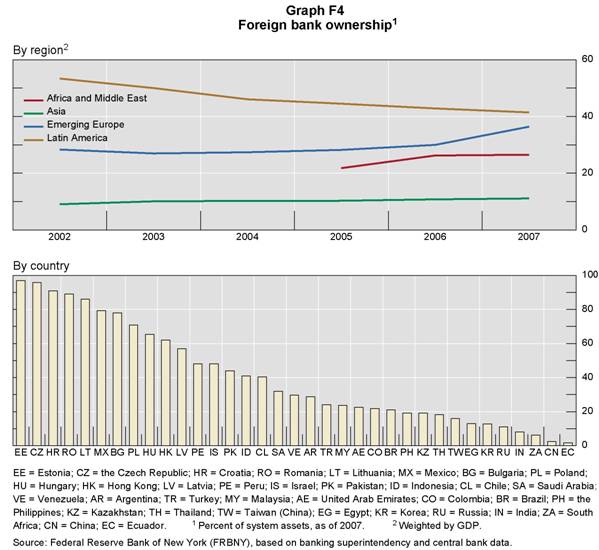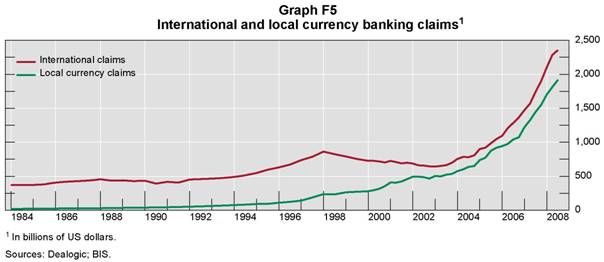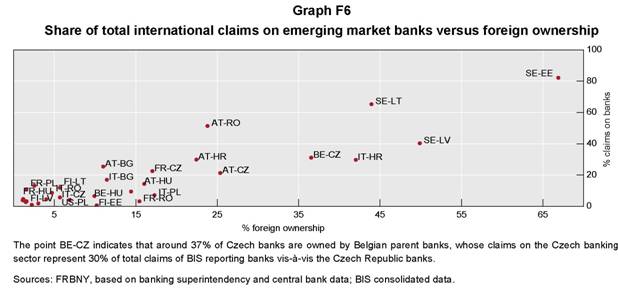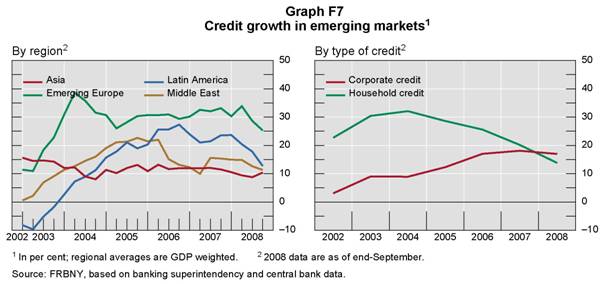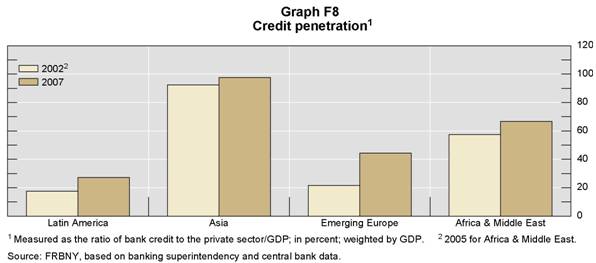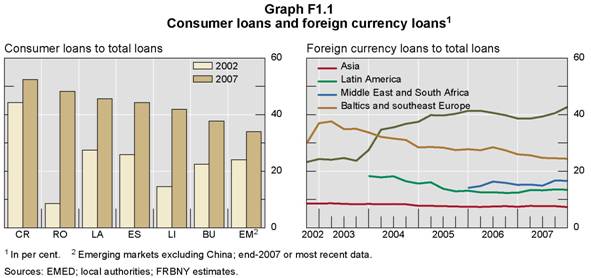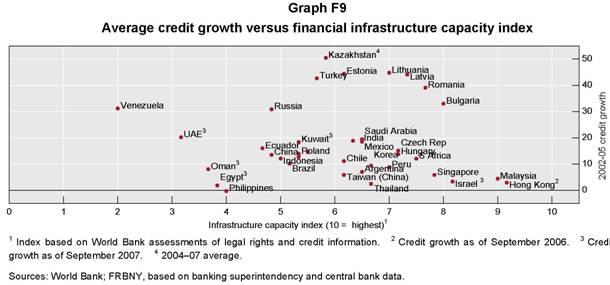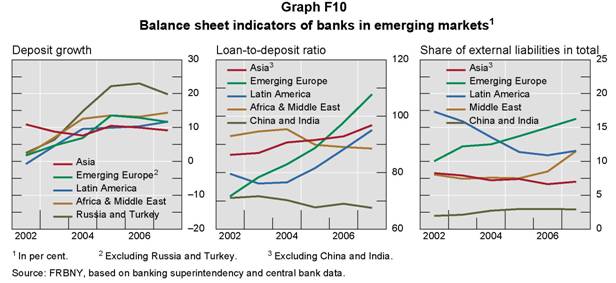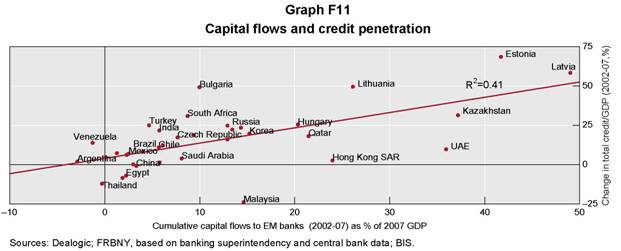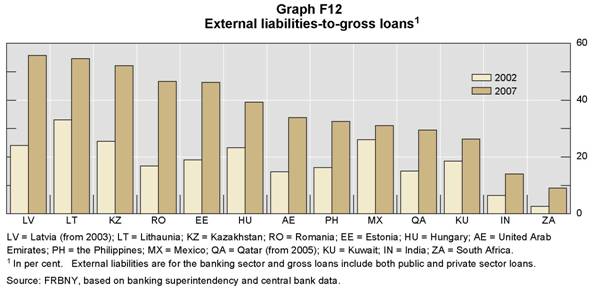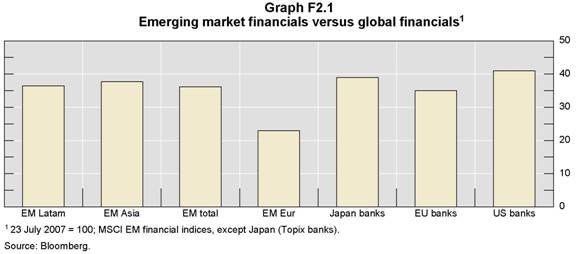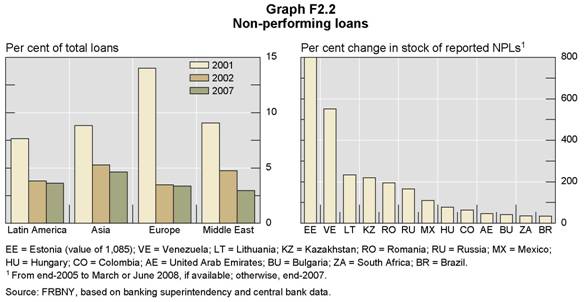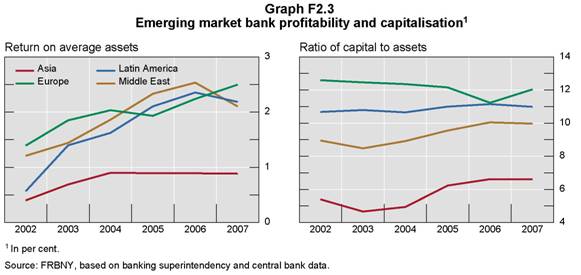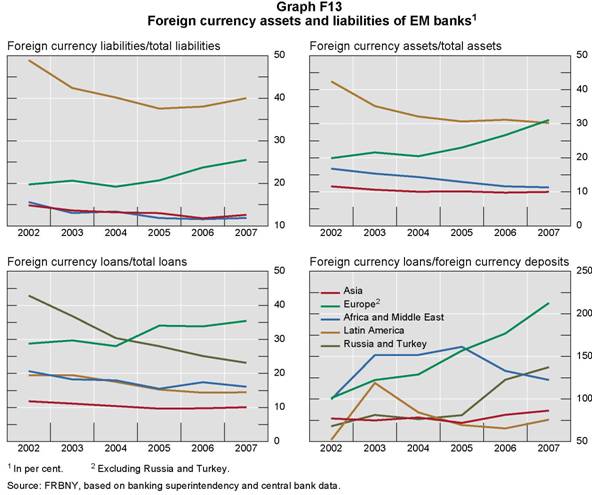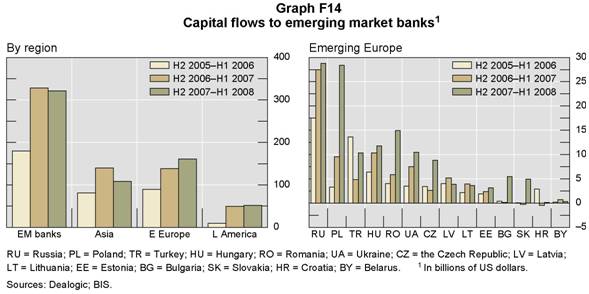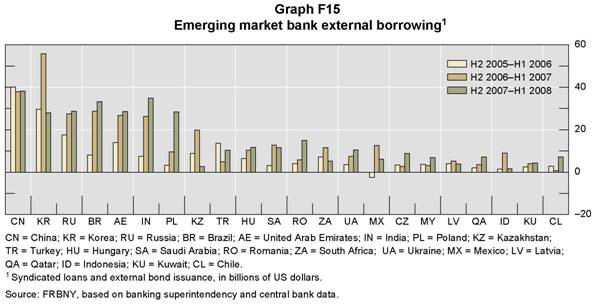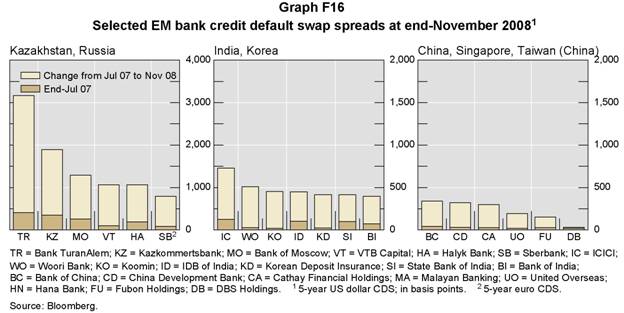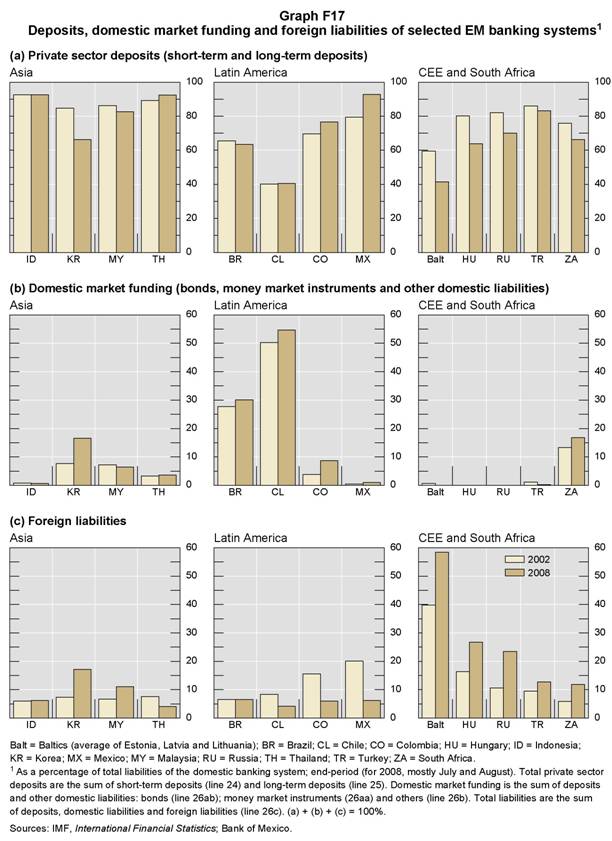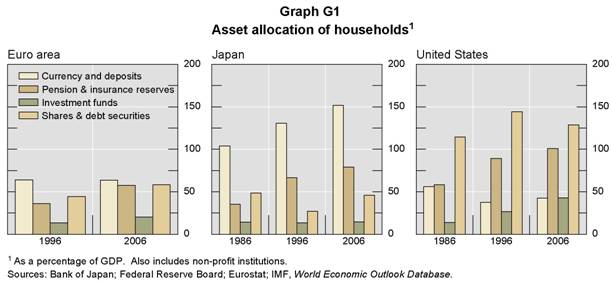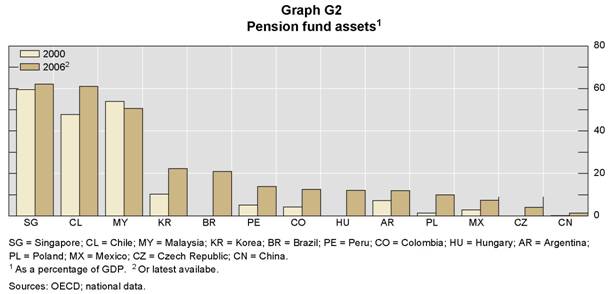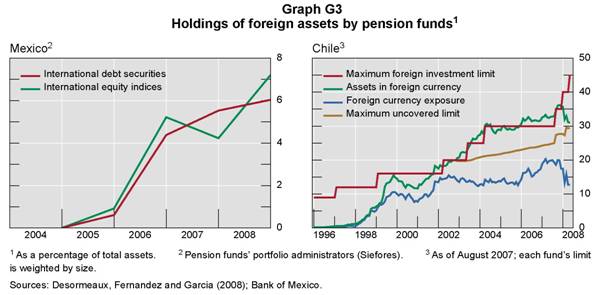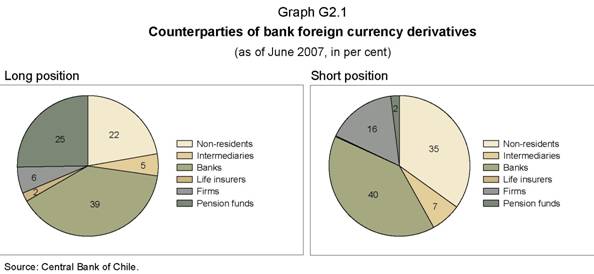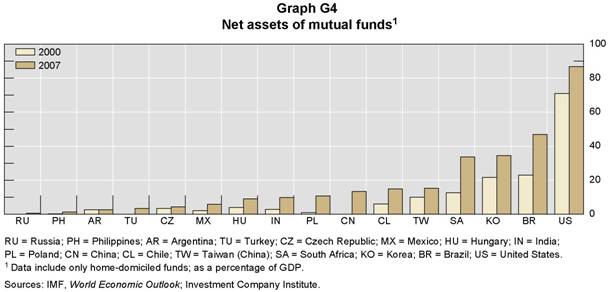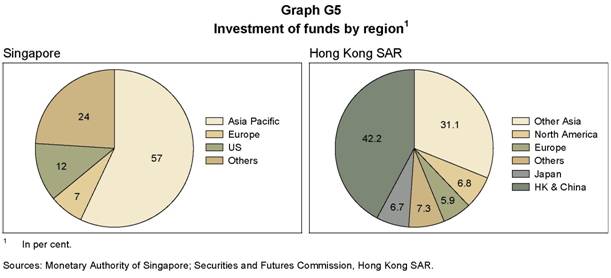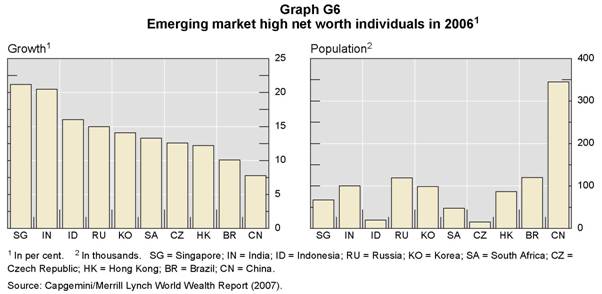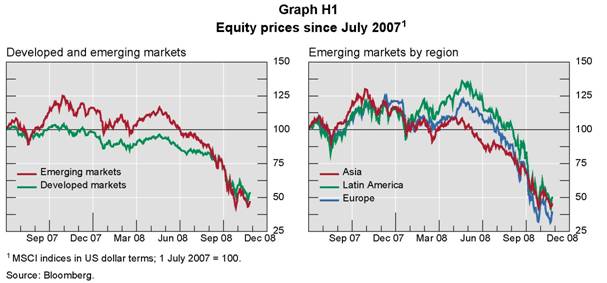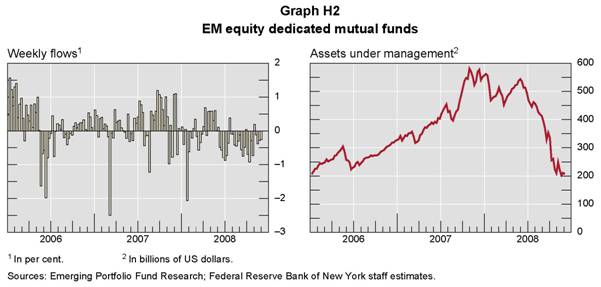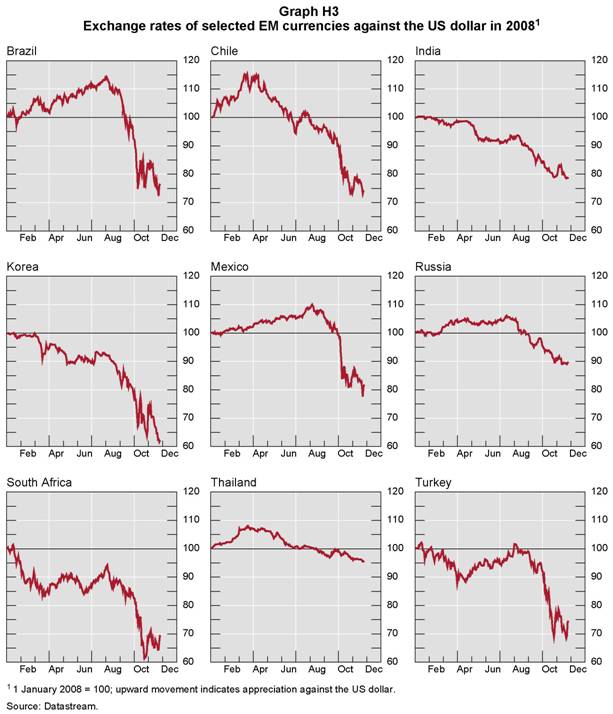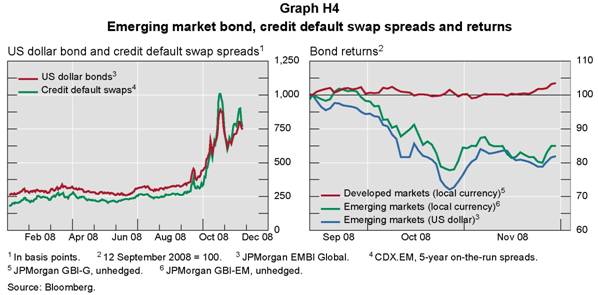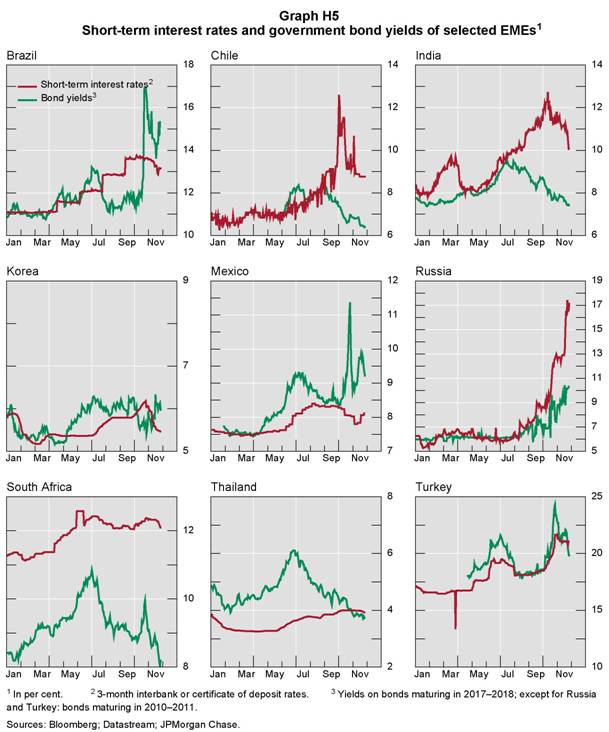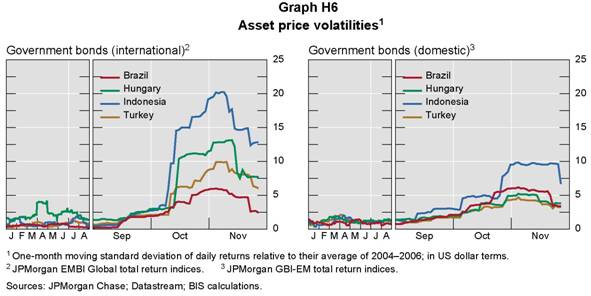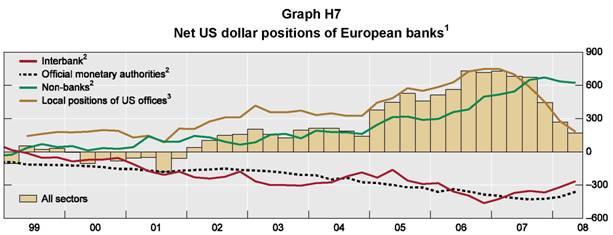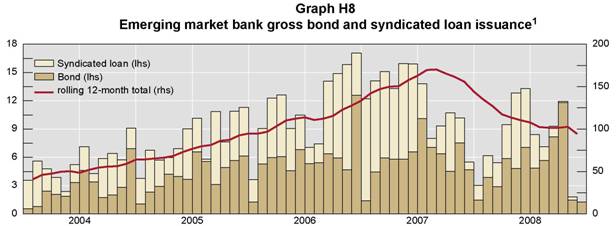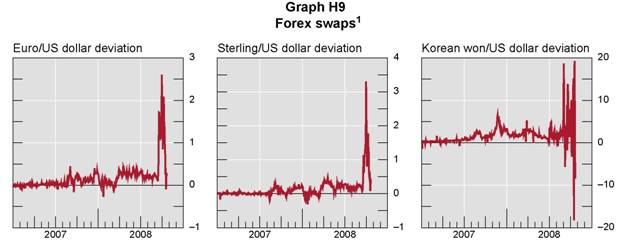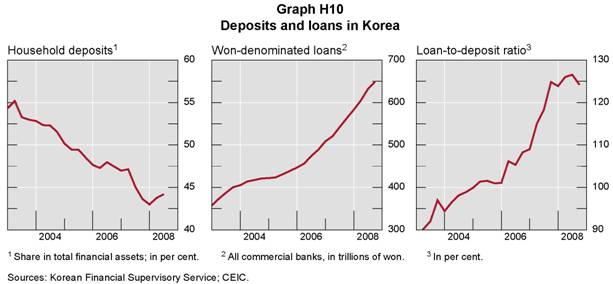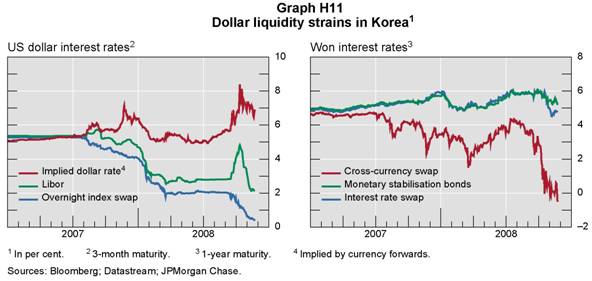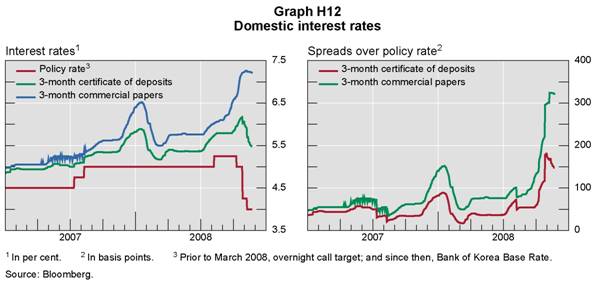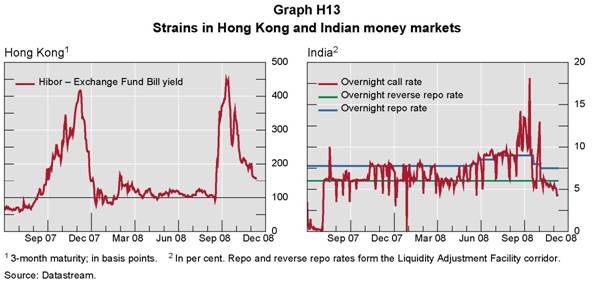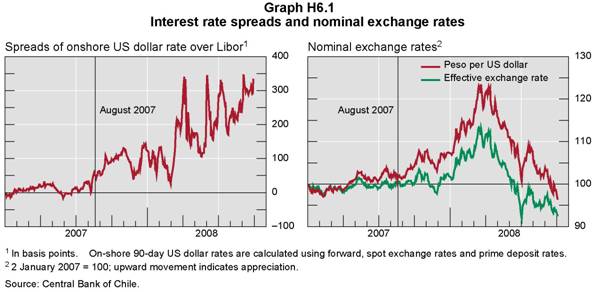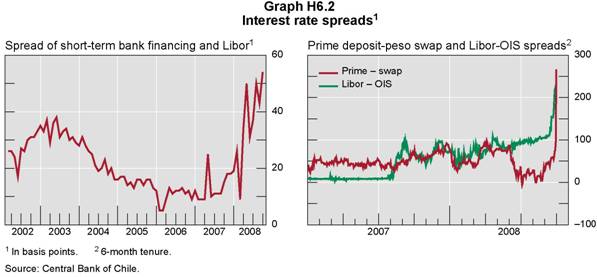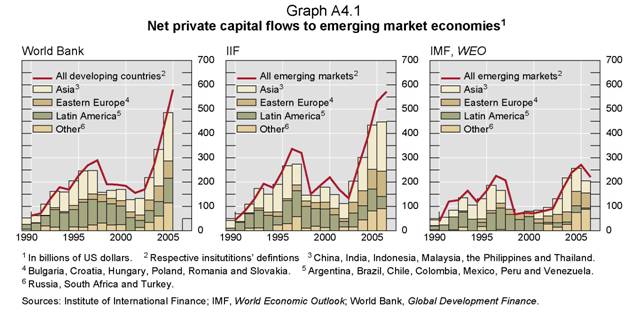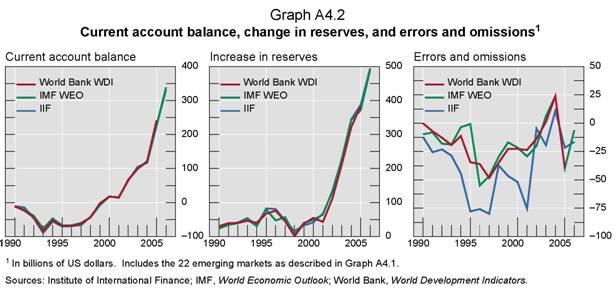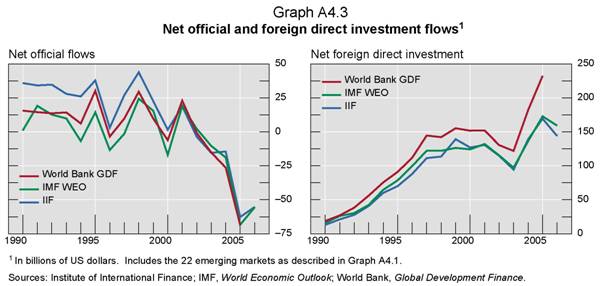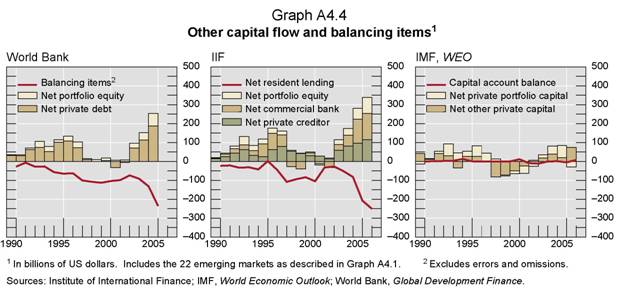|
| |
| |
Committee on the Global Financial System |
| |
CGFS Papers
No 33
Capital flows and emerging market economies |
| |
Report submitted by a Working Group established by the Committee on the Global Financial System |
| |
This Working Group was chaired by Rakesh Mohan of the Reserve Bank of India |
| |
January 2009 |
| |
JEL Classification: F21, F32, F36, G21, G23, G28 |
| |
|
| |
Copies of publications are available from:
Bank for International Settlements
Press & Communications
CH 4002 Basel, Switzerland |
| |
E mail: publications@bis.org
Fax: +41 61 280 9100 and +41 61 280 8100
This publication is available on the BIS website (www.bis.org). |
| |
© Bank for International Settlements 2009. All rights reserved. Brief excerpts may be reproduced or translated provided the source is cited. |
| |
ISBN 92-9131-786-1 (print)
ISBN 92-9197-786-1 (online) |
| |
| |
| |
A. Introduction
This Report reviews the growing integration of the major emerging market economies
(EMEs) into global financial markets. Greater financial integration is evident from the
sustained rise in both gross capital inflows (ie non-resident purchases of domestic assets)
and outflows (ie resident purchases of foreign assets) to and from the EMEs. Although the
structure of flows has become more stable, capital flows continue to be very volatile and this
has major macroeconomic implications for recipient countries. The size and the structure of
inflows are heavily conditioned by, and exert a major influence on, the state of development
of local financial markets.
The benefits and costs of capital market integration have been a controversial topic of debate
among academics and among policymakers. In principle, access to foreign savings helps a
country to lift future income streams (by undertaking investments whose prospective returns
exceed the cost of finance) and to better smooth consumption over time. In practice,
however, capital inflows – in terms of sheer size, volatility and form – have very often put
emerging market countries in major difficulty. During 2006 and 2007, the very rapid rise of
gross private capital inflows into the EMEs (now over $1 trillion a year, compared with the
previous peak of $300 billion in 1996) caused considerable strains in some countries. In
contrast, the current year (2008) to date has witnessed large equity outflows by portfolio
investors. Such large swings, over a very short period of time, complicate the conduct of
monetary policy and liquidity management in the EMEs. And many feel that the financial
stability risks have increased or at least become harder to monitor.
The next section briefly reviews the extensive academic debate on this topic. This debate,
somewhat inconclusive on the surface, yields several valuable insights on closer inspection.
The final section of this chapter outlines the plan of the Report.
The macroeconomic effects of capital account liberalisation
Economists have long debated the relationship between capital account liberalisation and
economic performance. One theoretical approach, forcefully advocated in the mid-1990s,
follows the first-best prescription of the neoclassical model (assuming, in particular, perfect
capital markets): allowing the free flow of capital across borders would lead to a more
efficient allocation of resources and be welfare-enhancing for both borrowers and lenders, in
a fashion similar to the liberalisation of trade.
An alternative view took a second-best perspective: that removing one distortion –
restrictions on capital movements – in the presence of other distortions that often exist in
emerging markets may not necessarily enhance welfare (eg Newbery and Stiglitz (1984);
and Stiglitz (2008)). This alternative view gained particular relevance after the onset of the
Asian crisis. This crisis focused attention on how incomplete or malfunctioning domestic
financial markets in recipient countries and poor risk management in capital-exporting
countries could undermine the case for capital account liberalisation.1
In the light of the debate on the macroeconomic and growth effects of capital account
liberalisation, a large empirical literature has emerged during the past decade in an attempt
to settle the issue. The Report therefore begins with a brief survey of this empirical evidence.
1 The first-best prescription is, of course, that policies can address those market failures directly – and indeed
did so after the Asian crisis.
Cross-country studies
The cross-country empirical literature on capital account liberalisation has been extensively
surveyed by several authors – Eichengreen (2001); Edison, Klein, Ricci and Sløk (2004);
Prasad, Rogoff, Wei and Kose (2003); Henry (2007); and Reinhart and Reinhart (2008). This
section draws out some key themes of selected studies.
A majority of cross-country studies on the growth effects of capital account liberalisation
follow a similar methodological approach, although some of them examine developed and
developing countries together, while others focus only on developing countries. Typically,
these studies use a proxy to measure capital account openness (eg the number of years a
country has had an open capital account), and regress a measure of economic performance
(eg average economic growth) on this proxy. Very often, the proxy measure for capital
account liberalisation (but certainly not the only one) is constructed as a binary indicator
of an “open” or “closed” capital account using information from yearly issues of the IMF’s Annual Report on Exchange Arrangements and Exchange Restrictions (AREAER).
Despite the numerous cross-country attempts to analyse the effects of capital account
liberalisation, there appears to be only limited evidence that supports the notion that
liberalisation enhances growth. This failure to find robust evidence has been interpreted by
the critics of capital account liberalisation to mean that liberalisation does not promote
growth, as the proponents of the alternative view would argue. For example, one of the earliest (and most widely cited) papers about the macroeconomic effects of capital account liberalisation is Rodrik (1998). He uses data for about 100 countries (both developed and developing) between 1975 and 1995 and regresses growth of income per capita on the IMF indicator-based binary variable mentioned above. He finds no correlation between liberalisation and per capita growth.
However, some argue that this result may be due partly to the crudeness of the binary variable that proxies for liberalisation. Quinn (1997) constructs a proxy that measures not only the presence but also the intensity of a liberalised capital account and finds that, for a sample of 66 countries between 1960 and 1989, there is a positive correlation between the change in his indicator and growth; however, Quinn uses relatively fewer low-income countries than Rodrik, which may be one source of the different results. Edwards (2001) uses Quinn’s measure and finds that liberalisation enhances growth in high-income countries but decreases it in low-income ones. This result suggests that perhaps the growth effects of capital account liberalisation are contingent on a country’s level of development.
Contingent effects and sequencing
Given the general inability to find unconditional positive growth effects of liberalisation, many studies have attempted to determine whether such effects are dependent on other conditions and policies that accompany liberalisation (“contingent effects”). For example, Kraay (1998) tests whether the growth effects of liberalisation are contingent on the quality of policy and institutions but finds no evidence, regardless of the use of the IMF-based binary proxy of Quinn’s indicator. In contrast, Klein (2005) finds evidence of a non-monotonic interaction between institutional quality and the effect of capital account openness on growth. Using panel data for 71 countries, a measure of capital account openness similar to the approach in Rodrik (1998), and the average of five variables to proxy for institutional quality (bureaucratic quality, control of corruption in government, risks of expropriation, repudiation of government contracts, and rule of law), he finds that the effect of capital account openness on economic growth is greatest for countries with better, but not the best, institutional quality.
Arteta, Eichengreen and Wyplosz (2003) ask whether the positive effect (if any) of capital account liberalisation on growth is limited to countries in a more advanced stage of financial and institutional development (where distortions that may result in a perverse effect of liberalisation are presumably low). They also examine whether it is limited to countries that have been deemed to have followed a proper sequencing of reforms (that is, where macroeconomic imbalances have been first eliminated and a high degree of trade openness has been achieved). They find only weak evidence that the effects of capital account liberalisation vary with financial and institutional development. On the other hand, they do find evidence that the positive effects of capital account openness on growth are contingent on the absence of macroeconomic imbalances, but not on openness to trade. In the presence of macroeconomic imbalances, capital account liberalisation is as likely to hurt as to help. This suggests that the sequencing of reforms shapes the effects of capital account liberalisation, which underlines the need for caution in approaching liberalisation in practice.
However, such cross-country studies that document conditional or unconditional positive effects of capital account liberalisation on aggregate economic growth cannot be considered representative of the considerable literature on this issue. In a survey of 10 studies on the subject, Edison et al (2004) find that only three uncover an unambiguous positive effect of liberalisation on growth. Similarly, Prasad et al (2003) survey 14 studies and find that only three of those studies identify a statistically significant positive relationship between capital account liberalisation and economic growth. This is consistent with the observation by Eichengreen (2001) that the literature finds, at best, ambiguous evidence that liberalisation has any impact on growth.
Reconciling the evidence
If theory predicts a positive effect of capital account liberalisation on growth for an emerging market economy, why have empirical studies been unable to unequivocally establish this link? Henry (2007) offers two compelling explanations. First, the IMF’s AREAER-based measure of capital account liberalisation used in several studies is fraught with imperfections. Second, the common econometric specification and data used in previous studies test for permanent effects of capital account liberalisation on growth, while theory only suggests a temporary growth effect and a permanent level effect.
A line of research that possibly circumvents imperfections in the IMF’s AREAER-based measure of capital account liberalisation does so by focusing on what happens before and after episodes of capital account liberalisation. In this literature, a capital account liberalisation event is assumed to occur when a country changes regulation to allow foreigners to purchase shares on the domestic stock market or when there is a significant increase in the S&P/International Finance Corporation’s Investability Index for the country. Studies based on this approach have been more successful in documenting a positive, but temporary, effect of capital account on investment and growth. In particular, countries appear to derive substantial benefits from opening their equity markets to foreigners (see eg Henry (2007) for a survey).2 Henry (2003) documents the channels – consistent with prediction by theory – through which the effect of capital account liberalisation operates. In the years following capital account liberalisation, the cost of capital declines. The lower cost of capital in turn boosts investment and, hence, economic growth.3
The relative success of event studies in documenting a positive effect could be attributed to the fact that these studies generally focus on a shorter time window around the date of the capital account liberalisation. As pointed out by Henry, theory suggests that the growth effect of capital account liberalisation should be temporary, and that level effects should be permanent. Estimating the effect with a sample that covers a long time period or a cross section of countries, as is the case in many of the studies, would fail to find a significant positive growth effect even when there is one because it is implicitly testing for a permanent growth effect, which is not a prediction of the neoclassical growth models. If this hypothesis is indeed correct, it would suggest that the long-run effect of capital account liberalisation on the emerging market economies should be recast in terms of its effect on levels of aggregate economic variables and on welfare.
2 Coulibaly (2009) uses an event study based on imposition and removal of an economic embargo on South
Africa. He documents a negative effect of the embargo on economic growth and a positive effect of the
removal of the embargo on growth.
3 Additional references on the effect of capital account liberalisation on the cost of capital include Kim and
Singal (2000) and Martell and Stulz (2003).
Collateral benefits
Despite the progress made over the last decade in understanding the effect of capital account liberalisation on economic activity in emerging market countries, some unresolved issues remain. In studies – mostly event studies – that have found positive effects of capital account liberalisation on economic growth, the magnitude of the output growth effect implied by the observed boost in investment and the capital stock falls short of the actual growth rates observed in the periods following capital account liberalisation (see Henry (2003) for a detailed discussion). In other words, following capital account liberalisation, output grows at a rate faster than can be justified by the increase in the capital stock given the share of capital in production. If the observed growth in output following capital account liberalisation cannot be fully accounted for by the liberalisation, what other forces are at play when the capital account opens?
A tentative answer to this puzzle lies in the growing literature on the “collateral benefits” of capital account liberalisation. According to this literature, the benefits of capital account liberalisation do not just operate through the cost of capital and investment. Opening capital accounts serves as an important catalyst for a number of indirect benefits. These indirect benefits include development of the domestic financial markets, improvements to local institutions, and better macroeconomic policies (Prasad et al (2006)). It is also conceivable that the presence of knowledgeable foreign investors increases competition and forces local market participants to become more efficient. The better governance, competition, and the enhanced efficiency that ensues could possibly explain the additional growth observed in the years after a country opens its capital account. Indeed, studies have documented an important increase in total factor productivity following the liberalisation of capital accounts, which could account for the additional increase in output growth. In a more recent study by Prasad et al (2008), the authors find that de jure capital account openness has a robust positive effect on total factor productivity growth, but the effect was less clear for the de facto financial integration.
However, more research is needed to establish a causal link between capital account liberalisation and total factor productivity growth. Empirical testing of the collateral benefits hypothesis is complicated by the wrinkle that proponents of this view also argue that, for these collateral benefits to kick in, a minimal degree of financial development needs to be in place already, which they call the required “thresholds”. This introduces considerable non-linearities in the relationships, where the relationships between capital account liberalisation, growth, and the variables that could be considered the outcomes of collateral benefits change at levels that are uncertain. Thus, while the hypothesis of collateral benefits is intriguing, it is in its infancy, and more research in this area is needed to evaluate its merits. However, it does reiterate that appropriate sequencing of policy changes may be very important; and the ideas of collateral benefits threshold effects are also related to the earlier literature on contingent effects. In sequencing policies of capital account liberalisation, the possible increase in vulnerability arising from volatility in cross-border flows has to be weighed against the potential benefits.4
An outline of the Report
The aim of this Report is to shed further light on these issues by examining what has happened in the major emerging market economies over the past decade. The CGFS asked this Working Group to pay particular attention to the implications for the financial system (see the mandate prepared in May 2007 in Annex 1). In preparing this, the Working Group has had considerable assistance from central banks, from academics and from representatives of the financial industry (see Annex 3).
Chapter B summarises the main trends of aggregate capital flows in the 2000s. It analyses the macroeconomic factors that have determined the volume and the composition of capital flows. Weak or unstable macroeconomic conditions in capital-importing countries can lead to destabilising forms of capital flow. Macroeconomic conditions in capital-exporting countries can also exert an influence.
Chapter C reviews how the composition of capital flows – mainly foreign direct investment, portfolio investments (equity and debt securities) and flows intermediated through banks – has changed over time. The composition of flows does have a significant bearing on monetary policy dilemma. It also has major implications for the sustainability of flows, for the nature of risk-sharing and for financial stability more generally.
An unusual feature of the most recent period of heavy capital inflows to the large EMEs is that they have not been “needed” to finance current account deficits. In fact, the EMEs as a group have had a large and growing current account surplus. Several countries have resisted currency appreciation. Only part of the foreign currency inflow (that is, from the current account surplus plus private capital inflows) has been recycled by institutional and other private sector investors from the emerging markets (private capital outflows). The monetary authorities have in effect done the bulk of the recycling (that is, via increased foreign exchange reserves). This has had major monetary and financial implications that are analysed in Chapter D.
Chapter E explores the various linkages between capital flows and the development of local financial markets. It also explores how the correlations between local and international financial markets have changed in recent years. There is clear evidence that domestic financial markets in most EMEs have become both broader and deeper than a decade ago.
The increased size of the local operations of international banks in EMEs is examined in Chapter F. Foreign banks have often spurned a shift in bank lending from the commercial sector to households. The macroeconomic and financial implications of such lending are quite different from those of the direct cross-border lending in foreign currencies that characterised earlier periods. In some cases, the growth and structure of international bank lending has given rise to some financial stability returns.
Chapter G documents the large increase in capital outflows from EMEs over the past decade. The marked home bias of local investors is weakening. Households in the EMEs have begun to increase the share of foreign assets in their portfolios, directly and indirectly via institutional investors.
4 According to Reinhart and Reinhart (2008), capital inflow “bonanzas” tend to be associated with economic crisis (debt defaults, and banking, inflation and currency crashes). Similarly, Calvo (2008) concluded that the probability of a “sudden stop” of capital flows initially increases in the early stages of financial integration but then gradually decreases, and is virtually nil at high levels of integration. Emerging markets largely stand in a grey area between developed and other developing countries, where the probability of a sudden stop is the highest, suggesting that financial integration can be risky when not accompanied by the development of institutions that will support the use of more sophisticated and credible financial instruments.
Chapter H provides a preliminary assessment of the impact on EME capital flows of the financial crisis that started in the main centres in August 2007. Although the immediate impact was limited, a major adverse impact has developed since August 2008. A prolonged period of deleveraging in the financial system in major countries, a loss of confidence in large financial firms and an extreme lack of liquidity across financial assets have had a dramatic effect on exchange rates, equity prices and bond yields across the emerging market world. This has confronted policy makers with many difficult dilemmas.
Many of the trends analysed in this Report are too new to permit definitive conclusions. The links between openness to international capital flows and economic welfare are in any case very complex. Nevertheless, one theme recurs in the chapters that follow: a larger number of EMEs now satisfy the macroeconomic and financial system preconditions needed to fully realise the benefits of international capital mobility than was the case even a decade ago. Nevertheless, capital flows cause changes in financial exposures that need to be monitored, even for countries with a comparatively well developed financial system. Many members of the Working Group viewed capital account liberalisation as a process to be managed, and the challenges this poses for policymakers are discussed in the final chapter.
B.The macroeconomic context of capital flows
Introduction
The very sharp rise in capital flows into the EMEs in the period 2002–07 took place in macroeconomic and financial circumstances quite different than in the past. Importantly, such flows were not “needed” to supplement inadequate savings. Indeed, since 1999, increases in saving rates have outpaced investment while the current account balance of EMEs as a whole has not only been in surplus but has also expanded rapidly (Graph B1).5 Private capital outflows from emerging market (EM) residents have also risen sharply (as local pension funds have diversified into foreign assets (see Chapter G) and as local corporations have expanded their operations overseas), in effect partly recycling these surpluses. But they have not expanded enough to offset the growing current account surpluses and capital inflows, resulting in an accumulation of foreign exchange reserves at an unprecedented level. |
| |
|
1 Includes 142 emerging and developed countries as defined by the IMF World Economic Outlook Database; as a percentage of GDP. Source: IMF, World Economic Outlook Database, October 2008.
|
This chapter looks at the main macroeconomic or financial factors behind the major trends of capital flows over the period 2000–07. The first section summarises how capital flows have evolved over the decades. The policy issues raised by capital inflows into EMEs are not new. This brief historical review therefore illustrates the central importance of the macroeconomic context, underlines the significance of sustainable exchange rate regimes, shows how the form that capital movements take matters a great deal, and outlines the policy dilemmas that have arisen. The second section examines net capital flows within the context of current account developments, drawing comparisons with the previous episode in the 1990s.6 The final section discusses the factors that drive these flows.
5 While the aggregate current account surplus might be contributed by a few large countries, the number of
surplus countries rose steadily from 22 in 1998 to around 50 in the mid-2000s. Among those surplus countries,
the median current account surplus increased from $0.2 billion to over $3 billion over that period.
6 The volume and composition of gross capital flows, which have an important bearing on financial stability
issues, are discussed in Chapter C.
Capital flows in historical perspective7
Standard neoclassical theory suggests that international capital movements should respond to differences in expected rates of return on capital across countries. Accordingly, capital “should” flow from high-income countries to developing countries (where capital/labour ratios are lower and the productivity of capital higher), boosting growth for some years and allowing developing countries to run current account deficits. In a world with perfect capital markets, capital flows can be used to smooth consumption or finance profitable investment opportunities.
One qualification to this perspective is that the expected variance of returns also matters: potential investors can be deterred from investing in developing countries because of greater risks.8 Nevertheless, allocating capital to where risk-adjusted returns are higher should raise global welfare.
A second qualification is that capital flows are also known to be volatile. Expected returns can change sharply. A shock in one emerging country can lead foreign investors with limited local knowledge to indiscriminately withdraw from several countries (“contagion”). In addition, financial or monetary shocks in investor countries can greatly destabilise capital movements in emerging markets. There have been many instances of sharp and very disruptive reversals in capital flows hitting small open economies. Many of the policy debates about capital flows to the EMEs depend on how much emphasis is placed on these disruption costs compared with the gains from a more efficient use of global capital.9
The neoclassical perspective broadly fits the pattern seen from the late 19th century up to 1914. Capital flowed to developing areas where the expected return on capital was high. The associated current account imbalances were larger, measured in relation to GDP, than in subsequent periods. Four features of this classical period are worth noting:
•
First, flows were almost entirely denominated in gold standard currencies, mainly sterling – nominal exchange rates were in fact fixed. This arrangement also served to stabilise inflation expectations.
•
Second, the main investment vehicle was bonds, and nominal long-term interest rates were comparatively stable.
•
A third, partly related, feature was that the range of financial assets was extremely limited. Denomination of contracts in gold standard currencies and the stability of long-term interest rates eliminated much of the need for financial diversification and hedging. In any case, the high costs of communication and of computation impeded the development of such activities. Hence the forms that capital flows took were much more uniform than has been the case in recent decades. Nor were there the huge two-way flows of capital that prevail today.
•
The final feature was that much of the movement of capital was long-term in nature, going to finance investment in capital-intensive infrastructure and other real investment. The scope for profitable foreign investment was considerable at that time because real output was expanding twice as fast in capital-importing countries outside Europe than in capital-exporting countries in Europe and because of confidence that bonds would be honoured. Increased real investment led to a deterioration in the current account of recipient countries so that the transfer of capital could be “requited” without a change in the real exchange rate. |
| |
7 This section draws on BIS (1995), Calvo, Goldstein and Hochreiter (1996), Lamfalussy (2000), Kindleberger
(1973) and Turner (1991).
8 This may explain the “Lucas paradox” of capital movement, ie in recent decades capital has moved in the
opposite direction to that implied by capital/labour ratios (Lucas (1990)). Inadequate protection of investor
rights may be another explanation (Alfaro, Kalemli-Ozcan and Volosovych (2008)).
9 In addition, views differ on how far capital flows can be expected to enhance stability. In principle, access to
diversified sources of foreign funds should enhance the stability of small (comparatively undiversified)
economies. But the many real-world features (eg incompleteness of markets, imperfect information) can
undermine such presumption (see eg the recent survey by Ocampo et al (2008), Prasad and Rajan (2008)
and Stiglitz (2008)). |
| |
Because of these features, many of the problems associated with capital flows in more recent decades did not arise.10
The “golden” age of international capital mobility was not re-established after 1919. Attempts made to stabilise currencies in the mid–1920s did not produce an exchange rate regime which lasted long, nor could the large US current account surplus of the 1920s find a durable counterpart in long-term US investment abroad. Borrowing in Europe and Latin America thus led to defaults on a scale not seen in the 19th century. By the late 1920s, attempts to keep exchange rates fixed among the major currencies increasingly strained monetary policies. The system of open capital accounts with stable currencies had, by the early 1930s, collapsed.
For the following 40 years, the role played by capital flows was greatly limited by government restriction. Under the Bretton Woods system established in 1944, comprehensive capital account restrictions were allowed. Such controls were regarded by many as essential for prudent economic policymaking domestically and for permitting the gradual restoration of liberal trading arrangements internationally. Capital account restrictions also allowed the government to control the level of interest rates and gave local banks (often subject to government direction) the effective control of domestic finance.
The 1950s and 1960s were decades of substantial trade liberalisation and strong global growth. Although most countries maintained a tight control on capital movements (despite some easing), their effectiveness became progressively weaker. But the strong pressures that built up on major exchange rates from the mid-1960s were not mainly due to “autonomous” capital flows but to divergent current account positions. Governments resisted these pressures for several years, responding with a series of exchange rate realignments (Brittan (1970)).
The advent of generalised floating among the major currencies in March 1973 occurred against a background of strongly stimulative fiscal and monetary policies in the largest industrial countries. Domestic money growth in the industrial world reached rates unprecedented in the postwar period.11 Nevertheless, the adoption of floating exchange rates did enable current account surplus countries to regain control of domestic monetary conditions in the face of very strong global inflation pressures.
The 1973–74 oil shock accentuated inflation pressures and created a particularly unstable structure of capital flows. The oil-producing countries’ surpluses were placed in short-term deposits with international banks. With recession and large current account deficits curbing fixed investment in the industrial world from 1975, the international banks looked for borrowers in the developing world.12 These forces helped foster a borrowers’ market in international bank lending, leading to a major underpricing of risk. The central banks supervising the major banks were well aware of these risks but were unable to curb the growth of bank lending.13
10 But flows in the classical period did share one important feature with recent flows: capital flows were still
responsive to cyclical developments in lending countries. UK capital outflows, for instance, tended to increase
when depressions at home lowered local interest rates (Imlah (1958)). Deane and Cole (1966) demonstrate
that, from 1875 to 1914, foreign and domestic investment moved in opposite directions. Bordo (2008), who
provides a useful summary of more recent literature, argues that “sudden stops” were also important in
emerging market crises pre-1914: for instance, a rise in the Bank rate of the Bank of England would cut off
capital flows to the emerging markets and produce a contraction of domestic demand that would often lead to
banking crises.
11 On this, see Black (1977).
Capital flows to the developing world rose sharply for several years, taking the form of short-term (or variable rate) bank lending in dollars (or other international currencies). Banks provided finance at rates much lower than long-term bonds (even World Bank finance) in the same currency (Lessard and Williamson (1985)). Capital inflows were in effect used to finance fiscal deficits or sustain private consumption – and not necessarily lift domestic capital formation (Turner (1995)).14 In many instances, capital inflows led to large currency appreciations which, by making imported goods cheaper, encouraged consumption (Ffrench-Davis and Reisen (1998), Rodrik and Subramanian (2009)).
It was this unstable form of capital flow that created the currency mismatches and short-duration debt structures that played a key role in almost all financial crises affecting the EMEs in the 1980s and the 1990s. Heavy reliance on such forms of capital flow, and the substantial subsequent adjustment costs, made policymakers very wary of reliance on external finance more generally. From the onset of the debt crisis in 1982 until the end of the decade, investors in industrial countries avoided those countries which had borrowed heavily. There were substantial write-offs of bank claims on developing countries and increased risk aversion discouraged new investments: measured outflows from crisis-hit countries increased markedly.
In the late 1980s and early 1990s, however, there was a revival of capital flows to the EMEs as growth in the industrial world picked up. After a short-lived tightening in 1994, US policy rates were reduced in 1995 and the decline in European rates continued: this easing of monetary conditions in major countries increased the supply of low-cost finance through banks and the international capital markets.15 International bank lending moved from Latin America to the rapidly growing Asian developing countries (“Tigers”). The issuance of debt securities, mostly denominated in dollars, in international capital markets increased. East Asia and Russia benefited from declining risk premia on sovereign (and even bank) debt. Substantial current account deficits were financed in ways that created large risk exposures (see below). This period of expansion in capital flows, punctuated by the Mexican crisis at the end of 1994, really came to an end only with the Asian and Russian crises in 1997–98.
These crises demonstrated that capital flows into countries with weak banking systems and underdeveloped capital markets create huge risks:
12 This summarises the flows from industrial to developing countries in this period. Flows between industrial
countries also became less stable. Unlike the situation prevailing pre-1914, private flows between major
industrial countries tended to compound, rather than offset, current account imbalances – exchange rate
expectations, rather than returns on real investments, came to dominate capital flows. Strong currency
appreciation put a heavy burden on the traded sector of current account surplus countries, often leading to an
easing of monetary policy that was unwarranted on domestic grounds.
13 Lamfalussy (2000, pp 9–13) describes in some detail the options considered by the Governors of the G10
central banks.
14 This experience prompted at that time much analysis about the sequencing of reforms – the optimum order of
economic liberalisation. Particularly notable was the work of McKinnon (1993) who concluded, “Only when
domestic borrowing and lending take place freely at equilibrium (unrestricted) rates of interest and the
domestic rate of inflation is curbed so that ongoing depreciation in the exchange rate is unnecessary, are the
arbitrage conditions right for allowing free international capital mobility”.
15 On this episode, Lamfalussy (2000) notes that three external factors contributed to this period: the failure of
lending banks to appreciate the risks despite warning signals; a marked easing of conditions in global money
markets from 1995; and real effective appreciation of Asian currencies towards the end of the inflow period as
the value of the US dollar – to which they were pegged – rose.
•
Local banks financed a major expansion of bank lending by short-term borrowing in foreign currency from international banks, creating both maturity and currency mismatches (either directly or on the balance sheets of their creditors).
•
The lack of long-term local currency debt markets meant that debt securities were either too short-term or denominated in foreign currencies.
•
Equity and other financial markets were thin, leading to disruptive boom-and-bust cycles. In some cases, foreign capital was diverted into nontradable instruments that were easily collateralised (eg real estate).
As a result, policy attention shifted from debates about capital account liberalisation per se towards the need to strengthen local banking systems and to develop capital markets. Arguments that capital account liberalisation should be avoided on the second-best grounds of absent markets (eg capital account liberalisation led to an excessive build-up on short-term debt because of the absence of long-term debt markets in local currency) were met with arguments about the need to concentrate on making financial markets more complete on improving bank supervision and on improving the management of liquidity risks.16
Because most crises were preceded by imprudent lending by international banks – there was “overlending” as well as “overborrowing” – there was also renewed emphasis on both better risk appraisal and the development of safer forms of lending by the major international banks. And there was, in addition, a focus on broadening intermediation via capital markets (domestic as well as international).17
The rapid succession of crises that affected virtually every developing country which had opened (albeit in varying degrees) to international financial markets raised another complex issue – contagion. Financial crisis in one country was transmitted with alarming ease to other emerging market countries – even those that did not exhibit major macroeconomic disequilibria.18
Major questions for the international financial system are raised in, to quote Dornbusch’s memorable phrase, “a world of pure contagion, [where] innocent bystanders are caught up and trampled by events not of their making and when consequences go far beyond ordinary international shocks”. For many in the official sector, these crises underlined the real need to make foreign investors more discriminating between countries, and so reduce unwarranted contagion.19 According to the Draghi Report and many similar official documents, the way to do this was to improve the quality and availability of data and make the operations of government and financial firms more transparent. How far markets have become more discriminating in the decade since the Asian crisis is reviewed in Chapter E.
This crisis also demonstrated the vulnerability of economies with large foreign currency liabilities to exchange rate overshooting. Countries that face external financing constraints (ie cannot borrow on international capital markets to cover large deficits) in a crisis can be forced to rapidly generate current account surpluses to meet crisis-induced capital flows abroad (Korinek (2008)).20 In the immediate aftermath of the crisis, very large increases in
domestic interest rates were often required to stabilise the currency at a depreciated level (Graph B2). The policy options for macroeconomic stabilisation available to crisis-hit countries thus narrowed dramatically (Ocampo (2005)). This led not only to more flexible exchange rate regimes but also to a desire to hold more forex reserves (Chapter D explores these issues).
16 The importance of liquidity risks in national balance sheets was examined in detail in BIS (2000).
17 A similar debate took place after the 1982 debt crisis: Lessard and Williamson (1985) argued that the sources
of finance needed to be broadened and financial instruments had to achieve a better distribution of risks and
rewards. See also Santiso (2003) for a perspective on the political economy of financial markets.
18 One book that brings together research on contagion from many different angles is Claessens and
Forbes (2001).
19 See Financial Stability Forum (2000).
20 Korinek (2008) presents a model of external financing decisions in countries prone to collateral-dependent
financing constraints. Decentralised agents do not internalise how their repayments could accentuate selling pressure on their country’s exchange rate in a crisis. Hence they take on too much systemic risk with their borrowing and so impose an externality on the rest of the economy. |
| |
|
Developments in the dollar and nominal effective exchange rates are summarised in Table B1.
1 1994–2008 = 100 (ie the average over the past 15 years).
Source: BIS.
|
| |
After the Asian crisis, net private capital inflows to EMEs fell abruptly to around one third of the pre-crisis levels. Most of this reflected declines in the more volatile or short-term types of flow: cross-border lending by foreign banks shrank. Foreign direct investment held up comparatively well. The currencies of crisis-hit countries gradually recovered, although real effective exchange rates remained below their pre-crisis levels.
A renewed upswing set in from 2002, as global measures of financial market size (equity market capitalisation, outstanding debt securities, etc) rose strongly. Inflows increased sharply and generally assumed forms that were more sustainable, much less likely to provoke external financing crises than in the past (see Chapter C). Reliance on short-term foreign currency denominated debt flows was greatly reduced: currency mismatches were generally avoided. Perhaps most importantly of all (discussed more fully in Chapter E), the domestic financial system became more resilient: long-term local currency debt markets developed; equity markets deepened; derivatives markets developed; and domestic financial firms became stronger. The intermediation channels through which capital flowed have thus
become much more diversified. Aggregate outflows have grown significantly (partly
intermediated by local institutional investors) and a large current account surplus has
emerged (Table B2). |
| |
| |
Table B1 |
Nominal exchange rates1 |
(2003 = 100) |
|
Vis-à-vis the dollar |
Nominal effective exchange rate |
|
Dec 05 |
Dec 06 |
Dec 07 |
Sep 08 |
Dec 05 |
Dec 06 |
Dec 07 |
Sep 08 |
Latin America |
|
|
|
|
|
|
|
|
Argentine peso |
96.6 |
94.6 |
92.2 |
93.9 |
87.0 |
81.6 |
72.9 |
75.3 |
Brazilian real |
133.9 |
142.3 |
171.5 |
170.4 |
130.0 |
132.4 |
152.8 |
154.1 |
Chilean peso |
133.9 |
130.4 |
138.1 |
129.9 |
126.5 |
117.6 |
117.1 |
110.7 |
Colombian peso |
126.2 |
127.1 |
142.9 |
138.5 |
125.3 |
122.8 |
132.8 |
129.3 |
Mexican peso |
101.4 |
99.3 |
99.4 |
101.2 |
99.1 |
94.8 |
92.2 |
94.1 |
Peruvian nuevo sol |
101.6 |
108.5 |
116.7 |
117.2 |
96.6 |
100.0 |
102.5 |
103.9 |
Venezuelan bolívar fuerte |
74.8 |
74.8 |
74.8 |
74.8 |
71.1 |
69.0 |
65.9 |
66.5 |
Asia |
|
|
|
|
|
|
|
|
Chinese renminbi |
102.5 |
105.8 |
112.3 |
121.1 |
99.0 |
97.4 |
99.1 |
108.6 |
Hong Kong dollar |
100.4 |
100.2 |
99.8 |
100.0 |
97.0 |
91.9 |
87.1 |
88.0 |
Indian rupee |
102.0 |
104.3 |
118.1 |
102.1 |
98.2 |
94.4 |
100.9 |
88.4 |
Indonesian rupiah |
86.9 |
94.3 |
91.8 |
91.7 |
84.2 |
86.7 |
80.1 |
80.5 |
Korean won |
116.4 |
128.7 |
127.9 |
104.8 |
113.9 |
120.8 |
113.9 |
92.2 |
Malaysian ringgit |
100.6 |
107.1 |
114.0 |
110.4 |
98.0 |
99.5 |
101.1 |
98.2 |
Philippine peso |
101.1 |
109.5 |
130.1 |
115.9 |
98.9 |
102.6 |
117.1 |
104.3 |
Singapore dollar |
104.0 |
113.1 |
120.2 |
121.9 |
101.8 |
105.1 |
106.5 |
108.9 |
Thai baht |
100.9 |
115.7 |
123.0 |
121.0 |
98.6 |
108.0 |
109.3 |
107.1 |
Central Europe |
|
|
|
|
|
|
|
|
Czech koruna |
115.2 |
134.0 |
156.1 |
165.2 |
109.5 |
116.1 |
124.2 |
132.6 |
Hungarian forint |
105.2 |
116.7 |
129.0 |
133.9 |
100.0 |
101.3 |
103.3 |
108.3 |
Polish zloty |
119.7 |
134.7 |
157.2 |
165.6 |
114.0 |
116.8 |
125.4 |
133.6 |
Other emerging |
|
|
|
|
|
|
|
|
economies |
|
|
|
|
|
|
|
|
Russian rouble |
106.5 |
116.7 |
124.8 |
121.6 |
101.7 |
103.5 |
102.9 |
100.6 |
Saudi Arabian riyal |
100.0 |
99.9 |
99.9 |
99.8 |
97.2 |
91.9 |
87.4 |
|
South African rand |
118.2 |
106.8 |
110.0 |
93.4 |
113.8 |
95.9 |
92.8 |
79.7 |
Turkish new lira |
110.7 |
104.4 |
126.7 |
120.2 |
105.6 |
91.4 |
102.9 |
99.6 |
Memo: |
|
|
|
|
|
|
|
|
Euro |
104.8 |
116.7 |
128.6 |
126.8 |
100.0 |
104.9 |
109.3 |
109.4 |
Australian dollar |
113.7 |
120.4 |
133.7 |
125.4 |
110.2 |
111.1 |
117.2 |
111.0 |
Japanese yen |
97.8 |
98.6 |
102.8 |
108.5 |
93.9 |
90.3 |
89.7 |
95.4 |
1 Above 100 indicates an appreciation from 2003.
Sources: Datastream; national data; BIS. |
|
| |
Table B2 |
Capital flows in EMEs: various episodes compared1 |
In billions of US dollars |
| |
Inflows |
Outflows |
Forex reserves change |
Current account balance |
1993-96 |
280 |
110 |
90 |
-85 |
1997-2001 |
269 |
193 |
89 |
21 |
2002-07 |
951 |
818 |
584 |
429 |
1 All EMEs as defined in the IMF World Economic Outlook plus Hong Kong SAR, Korea, Israel, Singapore and Taiwan (China); annual average.
Sources: IMF, Balance of Payments Statistics; Central Bank of China (Taiwan). |
|
| |
The greater attractiveness of EME assets was also the result of improved macroeconomic performance. Table B3 summarises three key differences between 1993–96 and 2004–07 (the two periods when there were large capital inflows to the EMEs):
•
The EM growth advantage has widened. Changes in Brazil, China and India mean that the potential growth rate of the developing world has risen.
•
EM saving ratios have risen while the average in the industrial world has fallen (mainly because of the decline in the United States). In earlier episodes (particularly in Latin America), capital inflows were often used to supplement declining domestic saving rates rather than to increase fixed investment. Using capital flows to boost consumption reduces future domestic disposable income. While potential output is unchanged, foreigners’ claims on income have increased.
•
EMs’ fiscal positions are stronger.
Have policies of monetary accommodation in advanced economies also shifted demand towards EME assets? Measured by both real short-term interest rates and broad money, the policy stance in advanced countries was more accommodative in 2004–07 than in 1993–96 (Table B4). Given that potential growth rates in the EMEs are higher than in industrial countries, the monetary policy stance appears to have been even more accommodating – on these two simple metrics – in emerging Asia and other EMEs outside Latin America. This has been particularly true in the past two years. However, policies of monetary accommodation in the EMEs have themselves been influenced by external factors (Hannoun (2008), see below for a discussion of the role of the “global liquidity” factor). |
| |
Table B3 |
Summary of macroeconomic determinants |
| |
GDP growth1 |
Savings/ GDP2 |
Investment/ GDP3 |
Fiscal balance4 |
EM |
AE |
EM |
AE |
EM |
AE |
EM |
AE |
1993-96 |
3.9 |
2.7 |
24 |
22 |
26 |
22 |
-3.2 |
-4 |
2004-07 |
7.6 |
2.9 |
30 |
20 |
27 |
21 |
0.7 |
-3 |
AE = advanced economies; EM = emerging markets and developing countries (both IMF World Economic Outlook definitions).
1 GDP average real growth from 1993 to 1996 and from 2004 to 2007 respectively. 2 Savings = gross national savings. 3 Investment = gross fixed capital formation. 4 As a percentage of GDP.
Sources: IMF, World Economic Outlook and International Financial Statistics. |
|
| |
Table B4 |
Some indicators of monetary expansion1 |
|
Short-term interest rates2 |
Growth of M23 |
|
Emerging
Asia4 |
Latin
America5 |
Other
EMEs6 |
AE7 |
Emerging
Asia4 |
Latin
America5 |
Other
EMEs6 |
AE7 |
1993-96 |
-1.0 |
16.3 |
-4.2 |
2.6 |
12.8 |
11.0 |
2.1 |
1.4 |
2004-07 |
1.4 |
4.7 |
0.4 |
0.8 |
10.2 |
12.1 |
18.6 |
3.6 |
2006 |
2.2 |
5.2 |
0.1 |
1.3 |
11.5 |
14.3 |
19.5 |
4.1 |
2007 |
1.4 |
4.3 |
0.8 |
2.0 |
10.3 |
10.6 |
19.0 |
3.7 |
2008 |
-0.9 |
3.0 |
-1.9 |
-0.1 |
6.7 |
7.8 |
10.7 |
2.9 |
1 Regional figures are weighted averages based on 2005 GDP and PPP exchange rates. 2 Deflated by the year-on-year rise in the CPI; period averages. 3 Deflated by the CPI; annual changes, in per cent. 4 China, Hong Kong SAR, India, Indonesia, Korea, Malaysia, the Philippines, Singapore, Taiwan (China) and Thailand. 5 Argentina, Brazil, Chile, Colombia, Mexico, Peru and Venezuela. 6 The Czech Republic, Hungary, Poland, Russia, South Africa and Turkey. 7 Canada, the euro area, Japan, Sweden, Switzerland, the United Kingdom and the United States.
Sources: IMF; Datastream; national data. |
|
| |
At the same time, capital outflows have risen as EM investors (including central banks) have invested heavily in industrial country assets and (to a lesser extent) in assets of other EMEs. By the end of 2006, total holdings of foreign assets by major EMEs excluding China had reached $6.7 trillion, compared with $3.2 trillion in 2001.21 Including China, the total rose to $8.4 trillion.22 A large part of the increase in foreign assets was due to reserve accumulation; but excluding the reserve assets, EMEs still held $5.3 trillion foreign assets in 2006 (Table B5). |
| |
21 Henceforth, unless otherwise stated, major EMEs include Argentina, Brazil, Chile, China, Colombia, the Czech
Republic, Hungary, Hong Kong SAR, India, Indonesia, Korea, Malaysia, Mexico, Peru, the Philippines,
Poland, Russia, Singapore, South Africa, Taiwan (China), Thailand, Turkey and Venezuela.
22 China first reported international investment position data in 2004. |
| |
Table B5 |
Foreign assets of emerging market economies1 |
|
In billions of US dollars |
As a percentage of GDP |
2001 |
2004 |
2006 |
2001 |
2004 |
2006 |
Net foreign assets |
|
|
|
|
|
|
Total |
-676 |
-321 |
-187 |
-15 |
-4 |
-2 |
Asia 12 |
147 |
800 |
1,240 |
8 |
18 |
21 |
Asia 23 |
-179 |
-26 |
-70 |
-11 |
-1 |
-2 |
Central Europe4 |
-100 |
-261 |
-337 |
-33 |
-56 |
-56 |
Latin America5 |
-660 |
-686 |
-785 |
-37 |
-37 |
-29 |
Others6 |
-63 |
-174 |
-305 |
-10 |
-14 |
-17 |
Gross foreign assets |
|
|
|
|
|
|
Total |
3,185 |
5,640 |
8,353 |
69 |
70 |
76 |
Asia 12 |
2,194 |
4,182 |
6,087 |
113 |
93 |
102 |
Asia 23 |
753 |
1,333 |
1,815 |
45 |
58 |
61 |
Central Europe4 |
115 |
192 |
311 |
38 |
41 |
52 |
Latin America5 |
512 |
657 |
925 |
29 |
35 |
34 |
Others6 |
365 |
608 |
1,031 |
59 |
51 |
58 |
Excluding reserve7 |
|
|
|
|
|
|
Total |
2,348 |
3,567 |
5,309 |
51 |
44 |
48 |
Asia 12 |
1,617 |
2,572 |
3,821 |
83 |
57 |
64 |
Asia 23 |
363 |
577 |
891 |
21 |
25 |
30 |
Central Europe4 |
63 |
110 |
210 |
21 |
24 |
35 |
Latin America5 |
368 |
453 |
640 |
21 |
24 |
24 |
Others6 |
300 |
431 |
638 |
49 |
36 |
36 |
1 Based on international investment position data. 2 Includes Hong Kong SAR, India, Indonesia, Korea, Malaysia, the Philippines, Singapore, Taiwan (China) and, from 2004, China. 3 Asia 1 minus China, Hong Kong SAR and Singapore. 4 Includes the Czech Republic, Hungary and Poland. 5 Includes Argentina, Brazil, Chile, Colombia, Mexico, Peru and Venezuela. 6 Includes Russia, South Africa and Turkey. 7 Gross foreign assets less reserve assets.
Sources: IMF, Balance of Payments Statistics; Central Bank of China (Taiwan). |
|
| |
This rise in both foreign assets and foreign liabilities of all major EMEs as a whole shows that these countries are playing an increasingly important role in the process of financial globalisation. Nevertheless, the scale of this shift has not matched that of the EME share of world trade. Data computed by Lane and Milesi-Ferretti (2008) show that, while the advanced countries’ share of world trade has fallen from around 70% in 1990 to under 60% by 2006, their share of cross-border financial positions has continued to rise.23 According to these authors, the main explanatory factor for cross-country differences in integration with global financial markets is the depth of the domestic financial system: as domestic markets deepen and grow in sophistication, they argue, the private sector’s capability to both acquire foreign assets and sustain issuance of foreign liabilities improves. (This subject is discussed further in Chapter E).
The accumulation of current account surpluses has lifted the net external asset position of most EMEs in Asia and Latin America. Between 2001 and 2006, net foreign assets held in Asia (including China, Hong Kong SAR and Singapore) and Latin America rose from 8% and –37% of regional GDP to 21% and –29% respectively. Excluding China and the two banking centres, net foreign assets held in Asia improved from –11% to –2% of regional GDP over the same period. In contrast, the current account deficits in central Europe, Turkey and South Africa have resulted in deterioration in external balance sheet positions.
Capital flows in the 2000s
According to the IMF World Economic Outlook, net private capital flows to 143 emerging markets and five small open economies rose from $90 billion in 2002 to around $600 billion in 2007. The Institute of International Finance (IIF) estimates a larger figure of $780 billion for 2007 for a smaller number of countries.24 For consistency, unless otherwise stated, capital flow statistics from the IMF will be the baseline data for analysis in this Report, supplemented with other sources when necessary. Furthermore, in order to focus on the key issues, this report will analyse developments in the major EMEs and refer to other countries only for specific developments. As shown in Graph B3 (left-hand and centre panels), the group of major EMEs captures well the broad trends in capital flow developments – both in US dollar terms and as a percentage of combined GDP.
The recent episode of net private capital inflows to EMEs draws comparison to the experience in the early 1990s when foreign capital inflows also expanded at a rapid pace. During the earlier period, a large volume of foreign private capital, mostly in short-term and foreign currency, has helped finance a current account deficit – an excess of domestic investment over savings – in many emerging economies. As a result, these EMEs were highly exposed to the risks of currency and maturity mismatches. In the event of a loss of confidence, holders of short-term paper were able to demand quick repayment, forcing local issuers to meet their foreign debts by prematurely liquidating longer-dated assets or by sharply reducing spending. These mismatches aggravated the financial crises in 1990s of many EMEs. The sudden capital reversals often took place through banking withdrawals, which are recorded as “other investment” in the balance of payments accounts (Graph B3, right-hand panel). |
| |
23 They show that a typical EME has a much smaller cross-border asset and liability position (a median of 70–
80% of GDP) than an advanced economy (a median well over 200% of GDP).
24 Annex 4 compares the differences of three commonly cited capital flow data sources: the IIF, IMF World
Economic Outlook and World Bank Global Development Finance databases. |
| |
|
1 Comprises 142 emerging and developing countries and five small open economies as defined in the IMF WEO 2008 October database. 2 Argentina, Brazil, Chile, China, Colombia, the Czech Republic, Hungary, Hong Kong SAR, India, Indonesia, Korea, Malaysia,
Mexico, Peru, the Philippines, Poland, Russia, Singapore, South Africa, Taiwan (China), Thailand, Turkey and Venezuela. 3 In
billions of US dollars. DI = direct investment; PI = portfolio investment; OI = other investment.
Sources: IMF, Balance of Payments Statistics and World Economic Outlook; Central Bank of China (Taiwan).
|
| |
The current episode differs from previous cycles in most regions, with the exception of central Europe, countries have been recording strong current account surpluses or manageable deficits in recent years (Graph B4).25 Under the balance of payments identity, ignoring the over- or understatement of the recorded components (net errors and omissions), the sum of private capital inflows and current account balance should equal to the change in reserve holdings by the monetary authorities. Thus large private capital inflows in combination with observed current account surplus have meant that foreign exchange reserves have increased markedly in most EMEs. Between 2000 and 2007, major economies accumulated more than $2 trillion of foreign exchange reserves. Foreign exchange reserve accumulation on this scale has important macroeconomic and financial implications. This will be examined in detail in Chapter D.
The current account deficits and heavy reliance on foreign financing in central Europe, South Africa and Turkey have become more vulnerable to a reversal in capital inflows (Graph B3, right-hand panel). The Baltic states and several southeastern European countries are in a similarly vulnerable position, with current account deficits around 15% of GDP and high levels of external debt. Box C3 in the next chapter compares the vulnerability of emerging Europe now with East Asia prior to the 1997–98 crisis, and a main source of vulnerability in these countries – cross-border banking flows – will be discussed in Chapter F.
25 Among the three countries grouped under “others”, South Africa and Turkey have been recording current account deficits in recent years; however, they were offset by the large surpluses in Russia. |
| |
|
1 China, Hong Kong SAR, India, Indonesia, Korea, Malaysia, the Philippines, Singapore, Thailand and Taiwan (China). 2 The Czech Republic, Hungary and Poland.
3 Argentina, Brazil, Chile, Colombia, Mexico, Peru and Venezuela. 4 Russia, South Africa and Turkey.
Sources: IMF, Balance of Payments Statistics and World Economic Outlook; Central Bank of China (Taiwan).
|
| |
The macroeconomic drivers of capital flows
Economists have long debated the factors that drive international capital flows. One popular distinction is between those that reflect conditions in investor countries (external factors) and those that are specific to the recipient economies (domestic factors).26 The proponents of the external factor view argue that capital flows into EMEs rise when financing conditions in investor countries ease. Such flows may also move inversely with the business cycles in industrial countries. Others argue that the demand for foreign capital depends largely on prospective returns on domestic investment. In practice, the balance between external and domestic factors is likely to vary according to circumstances.
External factors
Ample “global liquidity” is often cited as an important external factor that has “pushed” capital into EMEs. The term global liquidity, however, is rarely precisely defined. It is generally associated with a wide range of price and quantity measures of the monetary stance in industrial economies. These include low world interest rates and strong money growth in developed countries (see IMF (2007b), pp 34–7, Box 1.4).
Several members of the Working Group noted the dominant role of the US dollar in the global economy. The widespread denomination of international contracts in dollars and the use of the dollar as the reference currency for many developing countries with fixed or quasi-fixed exchange rates meant that the impact of movements in US dollar rates on global economic conditions was much greater than a simple calculation of the US weight in the global economy would suggest.27 In some EMEs, dollar interest rates have a large impact on the financing decisions of households and firms.28 In addition, lending by international banks tends to respond to monetary policy or liquidity shocks in their home country.29 |
| |
26 See Fernández-Arias (1996), Eichengreen and Mody (1998); and Ferrucci et al (2004) for a summary of the
external and domestic factors.
27 On this subject, see Greenwald and Stiglitz (2008). |
| |
In any event, changes in interest rates in investor countries are likely to influence capital flows to the EMEs. There are several channels. First, lower interest rates in the main centres encourage international investors, particularly those with shorter investment horizons, to search for higher yields elsewhere. Second, for the net debtor countries, low international interest rates reduce their servicing costs and indirectly improve their creditworthiness. Third, low international rates encourage borrowers in emerging markets to borrow in international currencies rather than in their own domestic currency.
The left-hand panel of Graph B5 shows that declining real interest rates in the G3 economies in the early 1990s and 2000s indeed coincided with rising capital flows to EMEs. In addition, the turning of interest rate cycles, especially in the United States, also matched closely the starting dates of the Latin America debt crisis in the 1980s and the Mexican crisis in 1994. In recent years, however, this link has been harder to detect – perhaps because US policy rates have changed in a more gradual way and have remained comparatively low. For instance, capital flows to EMEs continued to expand between mid-2004 and late 2007 when real interest rates in the United States and the euro area were rising.
One quantitative complement to the interest rate-based measures of global liquidity could be one based on money growth. The right-hand panel of Graph B5 shows the GDP-weighted changes of base money of the G3 economies. This indicator reveals a strong monetary expansion between 2002 and 2004, which coincided with the beginning of the current episode of strong capital flows to EMEs. But again, the sharp contraction in money growth from 2005 to 2007 did not trigger sharp movements in capital in the opposite direction as in earlier episodes. |
| |
|
1 In per cent.2 GDP-weighted change over three years for the G3 economies.Shaded areas are capital flow cycles.
Source: IMF, World Economic Outlook.
|
| |
In addition to the accommodative monetary stance in the industrial countries, some emerging market economies themselves have contributed to the significant increase in global liquidity by channelling their excess of domestic saving over investment abroad (Bernanke (2005)). An excess of domestic saving over investment in many EMEs and resistance to currency |
| |
28 In central Europe, interest rates in the euro and the Swiss franc exert a similar effect because households
borrow from local banks in these currencies.
29 Cetorelli and Goldberg (2008) analyse a very large set of bank-specific data on intragroup flows to show that
the lending of foreign offices of US banks is affected by US monetary policy. |
| |
| appreciation has led the monetary authorities to build up large amounts of foreign exchange reserves,30 which were invested in US Treasury securities and other dollar assets. One apparent consequence has been a steady decline in global long-term interest rates. Indeed, between 2000 and 2006, the average saving ratio of Asia rose by 9 percentage points (Graph B6, left-hand panel).31 At the same time, real long-term US interest rates declined steadily (Graph B6, right-hand panel). |
| |
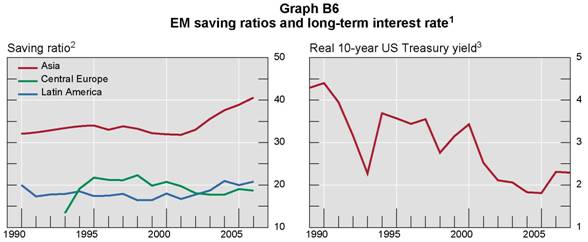 |
1 In per cent. 2 Savings as a percentage of GDP; GDP-weighted. 3 Up to 2002, 10-year nominal Treasury yield minus 10-year inflation expectations from survey data; from 2002, 10-year inflation-indexed Treasury yield.
Sources: Federal Reserve Bank of Philadelphia; Federal Reserve Board; IMF, International Financial Statistics.
|
| |
A related external factor is the business cycle in industrial countries. International business cycles can have both positive and negative impacts on capital flows to EMEs. For example, the economic downturns in most industrial countries during the early 1990s made investment opportunities in EMEs more profitable and encouraged flows into them (Calvo, Leiderman and Reinhart (1996)). When economic conditions in the industrial economies started to improve in the mid-1990s, this factor became less important in driving capital flows to EMEs. However, it is also noted that stronger growth in industrial countries may boost profitability of local firms, which will in turn increase their gains abroad (Ferrucci et al (2004)).
While the external macroeconomic factors discussed above could contribute to the cyclical behaviour of international capital movements, a microeconomic factor – global investors’ portfolio diversification – could lead to a more stable trend growth in capital flows to EMEs (see CGFS (2007a)). In particular, the aggregate financial assets of pension funds and insurance companies in the euro area, Japan, the United Kingdom and the United States reached $34 trillion at end-2007. A small percentage increase in their portfolio allocations to EM assets could potentially generate substantial capital flows to the EMEs. Data on institutional investors’ asset allocation to emerging market assets are not readily available, but the IMF Coordinated Portfolio Investment Surveys show that the holdings of emerging market equities and debt securities by developed countries and emerging market economies have increased steadily since 2001 (Graph B7)
30 Hannoun (2008) argues that the global credit excesses that led to the current financial market turmoil had their
origins in: first, accommodative monetary policies; second, large global imbalances and forex reserve
accumulation; and third, rapid financial innovation. He analyses the multidimensional linkages between these
three powerful forces.
31 Following Jones and Obstfeld (2001), the saving ratio is calculated implicitly, via the current account identity,
as the sum of investment rate and the ratio of current account to GDP. The investment rate is calculated as
the ratio of gross domestic capital formation (gross fixed investment plus changes in stocks/inventories) as a
percentage of GDP. Note that the saving ratio defined as such incorporates all measurement error from both
investment and the current account. |
| |
|
1 In billions of US dollars. 2 Australia, Canada, Sweden, Switzerland, the United Kingdom and the United States.
Sources: IMF Coordinated Portfolio Investment Survey.
|
| |
Domestic factors
A major element that “pulls” international capital to the EMEs is higher expected risk-adjusted returns. Better growth performance and a more stable macroeconomic outlook are thus important external factors. Graph B8 shows that the pace of net private capital flows into EMEs tends to pick up whenever the growth in the emerging markets surpasses that in the advanced economies.
Equally, the volatility of growth and inflation has come down sharply from the 1990s, when so many countries went through very disruptive crises, and is now close to that prevailing in industrial countries (Table B6). Reforms of macroeconomic policies played a key part. For example, the successful disinflation programmes implemented in many Latin American economies during the late 1980s and early 1990s, which were accompanied by fiscal adjustment, helped reduce perceived risk on real domestic investment and stimulate capital inflows.
As discussed more fully in Chapter G, institutional reforms and policies that ease the access of foreign investors to domestic financial markets, such as the removal of capital controls and the liberalisation on foreign direct investment, have also facilitated international capital movements.
In sum, the accommodative monetary stance and low interest rates in major industrial countries have played some part in encouraging both equity and debt flows to EMEs, particular in the early stage. At the same time, the strong economic outlook and sound domestic policies might appear to be important factors in attracting foreign capital into these countries. The fact that capital continues to flow into EMEs after monetary policies were tightened in the past few years up to August 2007 might suggest that improved fundamentals could outweigh other factors in international investors’ investment decisions (this is discussed further in Chapter G). Furthermore, emerging economies which have surplus domestic savings over investment export their surpluses officially via foreign exchange reserve accumulation or through private channels. The domestic financial implications of these official outflows will be discussed in the next chapter while the intermediation of private capital outflows will be examined in Chapter G. |
| |
Table B6 |
Volatility1 |
|
Output2 |
Prices3 |
Exchange rate4 |
|
1990-99 |
2000-Q2 2006 |
1990-99 |
2000-Q2 2006 |
1990-99 |
2000-Q2 2006 |
Mexico |
3.9 |
2.6 |
10.5 |
2.0 |
26.0 |
6.4 |
Korea |
4.9 |
2.4 |
2.3 |
0.8 |
19.0 |
8.1 |
Thailand |
7.5 |
1.7 |
2.2 |
1.7 |
19.3 |
6.6 |
Hungary |
1.8 |
1.0 |
7.2 |
2.6 |
6.7 |
12.3 |
South Africa |
2.3 |
1.0 |
3.6 |
3.1 |
9.1 |
21.2 |
Memo: |
|
|
|
|
|
|
United States |
1.5 |
1.3 |
1.1 |
0.8 |
1.0 |
1.0 |
1 Measured as the standard deviation of annual changes of quarterly averages; in per cent. 2 Real GDP. 3 Consumer prices. 4 National currency per US dollar.
Source: Updated version of Mohanty and Turner (2005). |
|
| |
|
1In per cent.2 Comprises 142 emerging markets and five small open industrial economies; in billions of US dollars.
Source: IMF, World Economic Outlook Database, October 2008.
|
C. Composition of capital flows and financial stability
Composition and risk exposures
The composition of capital flows matters for monetary policy, for the management of liquidity and for financial stability. It matters for monetary policy because some forms of capital flow are more sensitive to the central bank’s policy rates than others. At one end of the spectrum, short-term capital flows are typically very sensitive to domestic short-term rates (given exchange rate expectations). Because domestic short-term rates are regarded as a key policy device, restrictions on cross-border investments in short-term debt instruments have often been the last to be removed.32 It matters for the management of liquidity because the maturity or duration structure will influence the choice of instruments for sterilisation.
Capital flow composition matters for financial stability because it determines how risks are shared between provider and recipient (and so defines risk exposures), impacts domestic fixed capital formation, affects the cyclical sensitivity of aggregate flows and influences the future pattern of international adjustment.33
From the perspective of financial stability, four dimensions are of general importance:
a. Equity versus debt. Equity forms of investment serve to transfer risk to the supplier
of funds and away from the user of funds.Debt has to be serviced irrespective of the
returns earned on the investment financed by borrowing. The servicing of equity
liabilities, on the other hand, depends on the returns actually earned.
b.Short-term versus long-term. Borrowers reliant on long-term debt to finance long-
term projects are less vulnerable to interest rate and refinancing risks. A decline in
the market value of long-term debt paper – eg because of changed market
assessment of risk or higher interest rates – will be borne by the lender.
c. Investment versus consumption. Capital inflows to finance current public sector
spending allow governments to delay measures of fiscal consolidation. Equally,
inflows that in effect finance increased private consumption (eg thanks to exchange
rate overvaluation or the sale of domestic assets) can be less welcome than inflows
associated with increased real fixed capital formation.
d.Foreign versus domestic currency and tradables versus non-tradables. National
balance sheet considerations could suggest that foreign currency inflows should be
used to invest in foreign currency earning assets – that is, an expanding productive
capacity in tradables, rather than in non-tradables. Otherwise, the country faces
currency mismatches.
In addition, borrowing in foreign currency to finance investment in tradables increases productive capacity in the tradable sector and so, at constant terms of trade, tends to increase future trade surpluses to finance foreign currency debt obligations.
32 Attempts by industrial countries to maintain such controls in the 1960s and 1970s were, however, partly
frustrated by the growth of the eurodollar market (ie bank deposits denominated in currencies other than that
of the country in which the bank is domiciled). An excellent account of this issue is Chapter 24 of Caves and
Jones (1973). The recent growth of NDF markets offshore for many EME currencies has a similar effect of
undermining the effectiveness of capital controls (see Chapter E).
33 Williamson (2005) provides a careful analysis of stabilising properties of the different types of capital flows. He
argues that countries need to be as concerned about the form in which they borrow as with the aggregate
level of borrowing.
According to this – admittedly simple – perspective, foreign direct investment (FDI) is a “good” capital flow from the point of view of the potential vulnerability of the capital-importing country. It represents equity rather than debt, is long-term rather than short-term, and is associated with increased domestic capital formation rather than increased consumption (public or private).
Portfolio investment into equities also provides useful risk diversification. As noted in Chapter A, there is evidence that increased foreign investment in equities can lift the rate of domestic fixed capital formation for several years. At the other end of the spectrum, reliance on short-term foreign currency debt is the most risky strategy.
In practice, however, the hedging strategies of investors and borrowers can blur these sharp distinctions: an FDI investor, for instance, may simultaneously take on short-term hedges that can be liquidated very rapidly.
Macroeconomic policies (fiscal policies, exchange rate regime, etc) have often had a major influence on the composition of capital flows. Countries with poor fiscal discipline tend to become too dependent on short-term or volatile foreign finance (Rajan and Tokatlidis (2005)). Another example is the exchange rate regime. The combination of pegged exchange rates (or some equivalent) and high interest rates in inflation-prone countries creates attractive arbitrage opportunities and so induces large volumes of foreign investment funds into short-term debt instruments.
Mexico faced this problem in the early 1990s – but the adoption of a flexible exchange rate in 1995 led to a significant reduction in debt flows (Sidaoui (2005)). In short, an undesirable structure of foreign capital inflows often reflects poor macroeconomic policies.34 The sequencing of capital amount liberalisation measures (and the periodic re-imposition of controls) can also influence the composition of capital flows. There is evidence (eg De Gregorio et al (2000)) that capital controls on short-term debt instruments, but not on bonds, can lengthen the maturity of debt inflows.
Volatility
Another approach to gauge the stabilising (or destabilising) properties of particular forms of
capital movement is to examine historical volatilities. Most studies concur that FDI is
regularly the most stable form of capital flow: see, for instance, the recent study by Felices et
al (2008).35 Portfolio investment tends to be more volatile, and there is some evidence that
such flows are procyclical. Within the portfolio category, Felices et al report evidence that
flows into equities in EMEs over the period of 1980 to 2007 have been more stable than
flows into debt securities. Many have found that the most unstable source of finance is cross-border bank lending.
The volatility of flows is often a symptom of more fundamental causes. Box C1 summarises a
recent study by Broto et al (2008) of the determinants of volatility. The authors examine the
impact of a set of domestic macroeconomic and domestic financial factors and global factors
on the volatility of gross inflows (ie, net purchases by non-residents of domestic assets) of
FDI, portfolio investment and other investment (mostly bank credit). Particularly notable is
their finding that the development of the domestic financial system tends to reduce the
volatility of portfolio and banking flows.
34 And, it must be added, imprudent bank lenders – see Lamfalussy (2000).
35 Dobson and Hufbauer (2001) reach this conclusion in their survey of the literature. |
| |
Box C1 |
| |
Factors affecting the volatility of capital flows: some empirical evidence |
| |
Although the volatility of capital flows has long been a concern for policymakers in the EMEs, there
is only limited empirical evidence on the determinants of such volatility. Broto et al (2008) examine
the impact of a set of domestic macroeconomic and domestic financial factors and global factors on
the volatility of gross FDI, portfolio and other investment (mostly bank credit) flows. They use a
panel of 48 emerging economies, covering the period from 1980 to 2006. The key results are
highlighted below (Table C1.1).
First, global factors have become more important in determining the volatility of capital flows,
particularly in the case of FDI flows. Specifically, since 2000, movements in international equity
prices, as measured by the S&P 500, are correlated with the volatility of all three types of capital
flows. But global activity (measured in terms of world GDP growth) and global liquidity are both
negatively correlated with FDI volatility. This confirms the sensitivity of FDI to the global cycle
found by other studies.
Second, FDI is the flow whose volatility is more associated with macroeconomic soundness. Higher
GDP per capita, the ratio of reserves to imports (a measure of self-insurance) and lower inflation in
these countries all reduce the volatility of FDI.
Third, development of the domestic financial system is relevant for all types of flows but is
particularly important for portfolio and banking flows. This could help explain the volatility of all three
types of flows, especially in more recent periods. The size and competitiveness of the domestic
banking system (as measured by assets/GDP and interest rate spreads in the banking sector) are
negatively related to the volatility of FDI and banking flows. But these factors are related to higher
volatility of portfolio flows only in the recent years. The depth of the domestic stock markets (as
measured by the stock market capitalisation) is negatively associated with the volatility of portfolio
and other flows.
Despite the increasing importance of global factors in explaining the volatility of capital flows,
domestic policies can help reduce their volatility, particularly those aimed at reinforcing the depth
and soundness of the domestic financial system and, for the specific case of FDI flows, developing
policies to maintain macroeconomic soundness. |
| |
Table C1.1 |
|
|
FDI |
Portfolio |
Other flows |
|
|
1980-2006 |
2000 -06 |
1980-2006 |
2000 -06 |
1980-2006 |
2000 -06 |
Macro-economic factors
|
GDP per capita |
– |
– |
|
– |
– |
|
GDP growth |
|
|
- |
- |
|
|
Inflation |
+ |
+ |
+ |
|
|
+ |
Reserves/Imports |
- |
- |
|
|
|
- |
Financial developments
|
Bank assets/GDP |
– |
– |
|
|
|
– |
Interest rate differential |
|
- |
|
|
- |
- |
Stock market capitalisation |
- |
|
- |
- |
|
- |
US three-month interest rate |
|
- |
- |
- |
|
|
Global factors |
S&P 500 |
|
+ |
|
+ |
|
+ |
US inflation |
|
+ |
|
+ |
|
|
World growth |
- |
- |
|
|
|
|
Global liquidity |
|
- |
|
|
- |
|
|
| |
Finally, some studies have examined what might be termed the “crisis-resistance” of different
forms of capital flows. Levchenko and Mauro (2007), for instance, examine episodes of “sudden stops”, which they define as a year-to-year decline in total net financial flows of
more than 5 percentage points. They find that equity-like forms of financial flows (and FDI in particular) have proved to be very stable during such episodes. But bank-intermediated flows
fall sharply and often remain depressed for several years. Portfolio debt flows also drop but
tend to recover relatively quickly.
Changing composition
The composition of capital flows (in both directions) has changed significantly over the past
25 years. Graph C1 shows the evolution of gross private debt (portfolio debt and other
investment) and equity (direct and portfolio equity investment) flows since 1980 (see Box C2
for definitions of gross inflows and outflows). The volume of capital flows in the 1980s was
relatively small and comprised more of debt flows. Entering the 1990s, equity inflows started
to catch up with debt inflows. The onset of the Asian crisis in 1997 had led to a sharp
reversal in debt flows but a slight expansion in equity flows in the subsequent years. The
increase in equity flows partly reflected the sales of distressed EME assets to foreign
investors. Debt flows started to recover in the early 2000s, contributing to a more balanced
pattern of capital flows.
By finer composition, while FDI continues to be the dominant form of capital inflow, portfolio investment has also picked up (Graph C2, left-hand panel). Until 1998, portfolio inflows
mainly took the form of debt; since then, however, equity portfolio flows have been larger.
Investment through foreign banks returned in 2002 and has accelerated since (Graph C2,
right-hand panel). In the last few years, EMEs as a whole have become an important capital
exporter in the forms of direct investment and portfolio debt investment (Graph C3). The
following sections consider these flows in turn, paying particular attention to changing risk
exposures. |
| |
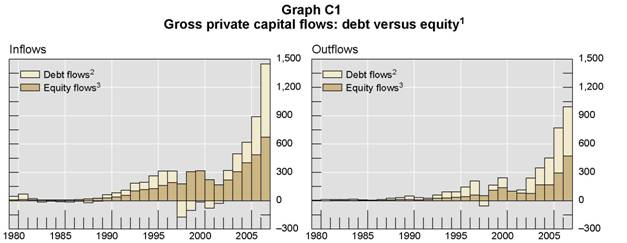 |
1 In billions of US dollars. Includes Argentina, Brazil, Chile, China, Colombia, the Czech Republic, Hungary, Hong Kong SAR, India, Indonesia, Korea, Malaysia, Mexico, Peru, the Philippines, Poland, Russia, Singapore, South Africa, Taiwan (China), Thailand, Turkey and Venezuela. 2 Includes portfolio debt investment and other investment. 3 Includes direct investment and portfolio equity investment.
Sources: IMF, Balance of Payments Statistics; Central Bank of China (Taiwan).
|
| |
Box C2 |
| |
Definition of gross private capital flows1 |
| |
Terms used for the different measures of international capital transactions are potentially
ambiguous. The conventions used for flow measures in this report are as follows:
Gross inflows refer to purchases by non-residents of domestic assets less their sales of such
assets. Similarly, gross outflow measures the purchases by residents of foreign assets less their
sales of such assets. Therefore, the gross flow measures are effectively consolidated magnitudes
which capture the balance of all increases and decreases of foreigners’ and residents’ holdings of
domestic and foreign assets respectively. Accordingly, there can be negative reported gross inflows
or outflows.
Net flows are defined as gross inflows less gross outflows.
Conceptually, private capital flows should equal total flows less all official components. But when
one side of transactions is an official entity, the deal may be recorded as official flows in one country
and private in another. For consistency, private capitalflows are defined with respect to the
reporting country by taking out the portfolio and other investment asset components that are
attributed to monetary authorities and general government.
1 The data are derived from the IMF Balance of Payments Statistics. There are two main groups of accounts: the current account, and the capital and financial account (previously known as capital account). Data on
private capital flows used in this report are derived from three standard components of the financial account: direct investment, portfolio investment and other investment. Another component – financial derivatives – is
not included in our compilation of flow measures as reported figures are largely negligible for most EMEs. Each of the three components separates the transactions between residents and non-residents. For direct
investment, there are directional distinctions (abroad or in the reporting country). The portfolio investment and
other investment components are divided into assets and liabilities. On this basis, gross inflows include items
recorded as direct investment in that country, and its portfolio and other investment liabilities, while the
outflow measures comprise direct investment abroad, portfolio and other investment assets. |
| |
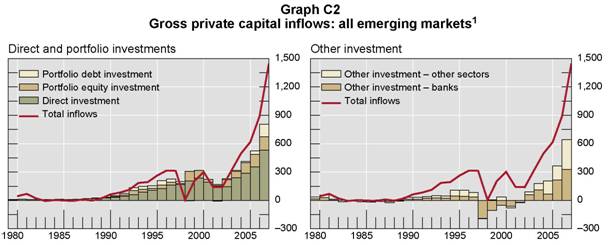 |
1 In billions of US dollars. Includes Argentina, Brazil, Chile, China, Colombia, the Czech Republic, Hungary, Hong Kong SAR, India, Indonesia, Korea, Malaysia, Mexico, Peru, the Philippines, Poland, Russia, Singapore, South Africa, Taiwan (China), Thailand, Turkey and Venezuela.
Sources: IMF, Balance of Payments Statistics; Central Bank of China (Taiwan).
|
| |
|
1 In billions of US dollars. Includes Argentina, Brazil, Chile, China, Colombia, the Czech Republic, Hungary, Hong Kong SAR, India, Indonesia, Korea, Malaysia, Mexico, Peru, the Philippines, Poland, Russia, Singapore, South Africa, Taiwan (China), Thailand, Turkey and Venezuela.
Sources: IMF, Balance of Payments Statistics; Central Bank of China (Taiwan).
|
| |
Foreign direct investment
Inflows
Foreign direct investment has been the major source of capital flows into EMEs since the 1980s. Throughout that decade, total FDI to the EMEs was stable at less than $50 billion. But entering the 1990s, FDI inflows accelerated, and by the end of the decade, total FDI flows reached $250 billion, or one third of the world total (Graph C4). The spate of financial crises in the late 1990s had slowed FDI flows into the EMEs, but they rebounded strongly in recent years to reach a record of $350 billion in 2006.
From the international investors’ perspective, the main criteria for investing in emerging market firms include competitive labour costs, growth prospects and the size of the host country. In this context, perhaps it was not surprising to see the rapid increase in FDI to EMEs in the early 1990s concentrated mostly in Asia, and China in particular. The 1997–98 financial crisis in Asia might have affected investor confidence in the region, but post-crisis market liberalisation such as granting foreign investors easier access to local firms, and the acquisition of distressed assets, have led to a strong expansion in merger and acquisition (M&A) activity in the 2000s. Furthermore, China, boosted by accession to the World Trade Organisation in 2001, continues to be the largest recipient of FDI among the EMEs, accounting for around 20% of the total inflows in 2006. Part of this, however, could be attributed to the “round-tripping” of Chinese savings for tax purposes (see World Bank (2002)). India, another fast-growing country in the region in recent years, has recorded FDI inflows which are modest when compared to those of China, but which have been observed to increase substantially in 2007 and 2008. |
| |
|
Sources: IMF, Balance of Payments Statistics; Central Bank of China (Taiwan).
|
| |
Privatisation has played an important role in the large FDI flows in Latin America and central Europe during the past two decades. In Latin America, an important part of the structural reforms which started in the 1980s was to privatise government-owned firms. These privatisation programmes gained force during the late 1980s. From 1980 to 1992, a total of more than 1,600 publicly owned firms were privatised in Argentina, Brazil, Chile, Mexico and Venezuela. But behind the regional trend were some country-specific characteristics. While the increase in FDI was largely driven by privatisation of state-owned assets in the service sectors (particularly telecommunications and banking) in Argentina, Brazil and Chile, investments in Colombia, Peru and Venezuela concentrated in the commodity-related sector.36 The signing of the North American Free Trade Agreement in 1992 boosted investments in Mexico. In the 2000s, the events in Argentina and the slowdown in the privatisation process in other countries contributed to a reduction in FDI flows to Latin America in recent years.
Apart from the privatisation-related FDI flows, central European countries have also attracted large amounts of FDI from the euro area during the expansion of the European Union. In Russia, rising oil prices and improved growth prospects have led to a significant increase in foreign investments, mostly into extractive activity in the country. As a result, FDI inflows rose sharply from 2000, reaching $32 billion in 2006. Turkey also recorded strong FDI flows in 2006, boosted by the sales of a domestic bank and an oil company to foreign investors.
36 CGFS (2005) provides an extensive analysis of financial FDI into EMEs.
Outflows
Following strong growth in recent years, many emerging market companies have expanded rapidly and started to engage in M&A activity in other developing and developed countries. As a result, gross FDI outflows from the EMEs rose from $43 billion in 2002 to $205 billion in 2006. Again, largely due to its special relationship with China, Hong Kong SAR accounted for around a quarter of that total. But the rest reflects largely genuine investments made by multinational corporations based in EMEs abroad. For example, Russian investors were involved in M&A deals in acquiring Ukrainian and Kazakhstan banks, while Chinese and Indian companies have bought major stakes in oil companies in Colombia, Kazakhstan and Syria. The World Bank (2007) reported that, since 2004, FDI flows from India into the United Kingdom have exceeded flows in the opposite direction, though a significant portion of FDI flows into India from different countries are routed through Mauritius due to tax benefits.
Private portfolio investment37
Inflows
Until the late 1980s, the volume of private portfolio investment flows into the EMEs was almost negligible. Since then, securities have become another major international funding source other than bank loans for EMEs. By 2006, the volume of gross portfolio investment in EMEs almost matched that of bank flows. However, there have been considerable differences in the developments across regions and in the nature of assets (equities versus bonds).
Portfolio debt investment started to rise in the early 1990s, driven largely by debt inflows to Latin America (Graph C5, top panel). This partly reflected the emergence of sovereign bond markets in the region. However, the trend was interrupted by the 1994 economic crisis in Mexico. Gross private portfolio debt inflows into the region have rebounded a little since, but the decision of several Latin American countries to buy back their sovereign bonds in the early 2000s resulted in “negative” gross portfolio debt investment. Elsewhere, the past few years witnessed an expansion of gross private portfolio debt inflows, partly reflecting the conscious nurturing of local currency debt markets in many countries to increase their resilience to external shocks. Government securities issuance in particular has shifted to local currency debt issued in domestic markets (see CGFS (2007b))
As reliance by most governments on international bond issuance has been scaled back, however, issuance of EME corporate bonds has greatly increased (Table C1).38 In less than 8 years, the international debt of EM corporations rose by more than $500 billion. Issuance by Russian, Korean and Brazilian corporates has been substantial – and this appears to have created significant forex exposures (see Chapter H for a further discussion).
A second remarkable development in recent years has been the sharp increase in equity investment in all regions, and Asia in particular (Graph C5, bottom panel). By 2007, more than half of the 23 major EMEs had stock markets with total market capitalisation exceeding their annual GDP, compared with only two economies a decade ago. More importantly, the size of equity markets is now larger than the size of domestic debt markets or total credit extended to the private sector in most EMEs (Table C2).
37 Private portfolio investment is obtained by taking out those asset flows that are due to monetary authorities
and central governments. However, it may still contain other official flow figures.
38 The increase in government bonds outstanding from $365 billion at the end of 2000 to $481 billion at end-
September 2008 is largely accounted for by increases in Poland (+$37.1 billion), Turkey (+$21.3 billion),
Hungary (+13.8 billion), the Philippines (+$12.4 billion) and Indonesia (+$10.5 billion) |
| |
|
1 In billions of US dollars.
Sources: IMF, Balance of Payments Statistics; Central Bank of China (Taiwan).
|
Rising portfolio capital inflows have reflected portfolio diversification by international institutional investors such as pension funds and insurance companies in industrial countries (see CGFS (2007a)). The fact that most EMEs liberalised their equity markets more than a decade ago made this possible (Bekaert et al (2005)).39 It is difficult to obtain information on institutional investors’ international asset allocation, but IMF data suggest that total portfolio investment assets held by major industrial countries rose from $574 billion in 2001 to almost $2 trillion in 2006; the share of equities increased from 60% to 74% over the same period.
The pattern of equity flows appears to have reflected relative economic performance between source and recipient countries. Funds tended to flow into countries where growth was accelerating. Accordingly, interest in emerging market equities strengthened considerably in recent years. Between 2002 and 2007, emerging stock markets have outperformed most mature markets by a great margin (Graph C6, left-hand panel).
39 Note that portfolio debt flows in some EMEs such as China and India are still not fully liberalised |
| |
Table C1 |
Amounts outstanding of international debt securities – developing countries |
In billions of US dollars |
| |
End-2000 |
End-2006 |
End-2007 |
Sep-2008 |
| |
Govt |
Corp |
Govt |
Corp |
Govt |
Corp |
Govt |
Corp |
Developing Countries |
365 |
223 |
455 |
542 |
482 |
702 |
481 |
753 |
Russia |
37 |
1 |
32 |
61 |
29 |
102 |
28 |
117 |
Korea |
5 |
44 |
8 |
89 |
7 |
103 |
4 |
111 |
Brazil |
58 |
30 |
54 |
57 |
55 |
65 |
52 |
69 |
United Arab Emirates |
0 |
0 |
1 |
31 |
2 |
50 |
4 |
61 |
Mexico |
61 |
33 |
43 |
49 |
42 |
54 |
40 |
53 |
India |
0 |
4 |
0 |
21 |
0 |
38 |
0 |
40 |
China |
5 |
12 |
6 |
24 |
6 |
33 |
6 |
39 |
Kazakhstan |
1 |
0 |
0 |
19 |
0 |
30 |
0 |
34 |
Malaysia |
3 |
13 |
4 |
28 |
4 |
29 |
4 |
30 |
Countries are ranked by outstanding corporate bonds in September 2008. Source: BIS International Financial Statistics. |
|
| |
|
1 1990–2005 = 100. 2 Includes both Chinese-owned (H shares) and affiliated companies (red chips), in billions of US dollars. Sources: Bloomberg; Hong Kong Stock Exchanges and Clearing Limited.
|
The large volume of equity flows was also driven by a significant increase in international placements by emerging market companies. In 2006, firms in China, Mexico, Russia and Thailand all recorded cross-border initial public offering (IPO) deals worth more than $1 billion. Chinese companies in particular have raised a cumulative $169 billion in the Hong Kong stock exchanges since 2000, of which $104 billion were through IPOs (Graph C6, right-hand panel). Apart from fund-raising, the listing of companies in major financial centres could help improve corporate governance because of the more established legal and accounting standards in these centres. |
| |
Table C2 |
Size of capital markets |
As a percentage of GDP |
| |
Stock market capitalisation |
Domestic debt securities |
Private domestic credit |
| |
1997 |
2007 |
1997 |
2007 |
1997 |
2007 |
Asia1 |
59 |
256 |
19 |
54 |
93 |
97 |
China |
22 |
138 |
9 |
47 |
94 |
116 |
India |
31 |
317 |
18 |
40 |
24 |
48 |
Indonesia |
12 |
49 |
2 |
21 |
61 |
25 |
Korea |
8 |
117 |
29 |
117 |
63 |
109 |
Malaysia |
92 |
174 |
56 |
83 |
158 |
105 |
Philippines |
37 |
71 |
20 |
35 |
56 |
24 |
Taiwan (China) |
96 |
173 |
34 |
51 |
138 |
136 |
Thailand |
15 |
80 |
7 |
53 |
166 |
84 |
Banking centres |
|
|
|
|
|
|
Hong Kong SAR |
234 |
1,284 |
23 |
25 |
170 |
140 |
Singapore |
111 |
334 |
25 |
58 |
101 |
96 |
Latin America1 |
31 |
70 |
25 |
52 |
32 |
28 |
Argentina |
20 |
22 |
12 |
31 |
22 |
14 |
Brazil |
29 |
104 |
40 |
69 |
75 |
72 |
Chile |
87 |
130 |
44 |
26 |
57 |
74 |
Colombia |
18 |
59 |
9 |
31 |
36 |
40 |
Mexico |
39 |
45 |
10 |
37 |
25 |
21 |
Peru |
26 |
64 |
4 |
17 |
24 |
20 |
Venezuela |
17 |
3 |
9 |
90 |
13 |
22 |
Central Europe1 |
12 |
49 |
21 |
41 |
32 |
39 |
Czech Republic |
25 |
58 |
19 |
51 |
70 |
48 |
Hungary |
33 |
33 |
31 |
49 |
24 |
62 |
Poland |
8 |
50 |
19 |
34 |
21 |
40 |
Others |
50 |
117 |
22 |
17 |
23 |
36 |
Russia |
32 |
117 |
16 |
3 |
11 |
38 |
Turkey |
23 |
44 |
12 |
33 |
26 |
28 |
South Africa |
85 |
125 |
55 |
41 |
64 |
83 |
1 Simple average.
Sources:IMF,International Financial Statistics and World Economic Outlook;World Bank,World Development Indicators; Prague Stock Exchange; World Federation of Exchanges; BIS. |
|
| |
Outflows
Despite the strong gross portfolio equity inflows, major EMEs on average recorded net private portfolio flows abroad between 2000 and 2006, suggesting even stronger gross flows in the opposite direction. The main component in driving these gross outflows was the acquisition of foreign debt securities by local residents, particularly in Asia. In 2006, the gross outflows almost doubled from the previous year to $264 billion, of which $109 billion was from China. Given that the capital account in China is not fully liberalised, a large part of these transactions might be sourced from other quasi-government entities such as state-owned commercial banks. This highlights a deficiency in measuring the true private sector flows using balance of payments data as they may contain flows related to other nongovernment and non-central bank official entities such as sovereign wealth funds.40
Bank flows
Banks act as agents in virtually all capital account transactions. Balance of payments statistics classify these transactions under other headings wherever possible (eg direct investment, portfolio investment or changes in reserves). Bank flows that are not captured in these categories are classified as other investment (which also includes other external transactions such as trade credits and accounts receivable and payable). Thus, the other investment category is essentially a residual item that covers capital transactions through banks, but the bank flows in this category are not included elsewhere in the balance of payments statistics.
To some extent, banks’ role is to “take up” the counterpart foreign exchange exposure desired by non-banks; their exposures are then passed on to others (eg central banks). The right-hand panel of Graph C2 shows that bank inflows into EMEs under the other investment category are large and volatile. A striking point was that gross inflows turned “negative” in the few years after the Asian financial crisis, implying that foreign banks sold more emerging market assets than they purchased during those years. Similarly, the negative outflows from EMEs over the same period meant that domestic banks’ sales of foreign assets have exceeded their purchases (Graph C3, right-hand panel). In sum, in the aftermath of the financial crisis, foreign banks withdrew large amounts of capital from Asia while Asian banks reduced their holdings of foreign assets.
It should be noted that substantial amounts of these banking flows were directed through the two banking centres in Asia – Hong Kong SAR and Singapore – during the early post-crisis years. As McCauley and Mo (1999, 2000) noted, a large part of these outflows reflected the reversal of the round-tripping of funds from Japanese banks in Japan to Hong Kong SAR and back to non-banks in Japan. Excluding the flows from the banking centres, the aggregate gross inflows and outflows of EMEs were less volatile (the red lines in Graph C7).41 |
| |
40 Under the current balance of payments framework, private portfolio flows are calculated by taking out those
related to monetary authorities and general governments from the total figures.
41 It should also be noted that Hong Kong SAR first reported balance of payments statistics in 1998, so the
banking centre total was just the capital flowing in and out of Singapore. |
| |
|
1Other investment flows that are related to banks; in billions of US dollars.2 Banking centres: Hong Kong SAR and Singapore.
Sources:IMF,Balance of Payments Statistics;Central Bank of China (Taiwan (China)).
|
In recent years, non-resident bank flows have returned to the EMEs. Emerging Asia, Hong Kong SAR and Singapore in particular accounted for more than half of the transactions; there was also strong growth in gross bank inflows into Russia and Turkey.
National balance of payments data, however, often fail to fully capture the transactions between residents and non-resident banks. The BIS banking statistics provide useful supplementary information. In particular, the BIS consolidated banking statistics, which are based on the nationality of the reporting bank and include the positions of their foreign subsidiaries, provide valuable insight into international banks’ changing strategies.
Until the mid-1990s, international bank lending to the EMEs primarily took the form of cross-border lending in dollars (or other foreign currency). Since then, however, international banks have greatly increased their local presence. The result has been a substantial increase in local currency lending through their local affiliates (Table C3).
Despite the recent rebound in US dollar terms, the BIS consolidated banking data reveal that the size of international banking claims relative to GDP in most EMEs has been lower than that in the 1990s (Table C4). Notable exceptions are Turkey and central Europe, where the size of international claims is much higher than the average in the early 1990s. While the current account in central Europe can be compared to the pre-crisis Asian experience, some commentators started to draw parallels between the recent expansion of international banking claims in central Europe and the Latin American experience in the 1980s, when some regional economies held substantial amounts of bank-intermediated external debt (see Box C3). However, unlike Latin America in the 1980s, the banking systems in central Europe are now largely foreign-owned with more advanced risk management. Furthermore, instead of using the external funds to finance the local import substitution industries, the increase in emerging market external borrowing is taking place against the background of rapid economic and financial integration with the euro area. |
| |
Table C3 |
Consolidated international and local claims of BIS reporting banks |
In billions of US dollars |
|
1990 |
1997 |
2002 |
2005 |
2006 |
2007 |
Local1 |
67 |
364 |
684 |
1,156 |
1,390 |
1,841 |
International2 |
644 |
1,239 |
747 |
1,127 |
1,453 |
1,953 |
1Claims of BIS reporting banks’ foreign offices denominated in local currency.2Sum of cross-border claims in all currencies and local claims of BIS reporting banks’ foreign offices denominated in foreign currency only.
Source: BIS. |
|
| |
Cross-border bank borrowing has played an important role in the emerging market financial crises in the 1990s. First, heavy short-term borrowing of domestic banks in the international interbank market creates a risk for large-scale sudden reversals of bank loans. Second, domestic banks which borrow in foreign currency and then onlend to finance domestic projects face a currency mismatch (or pass this mismatch on to their domestic customers). The BIS data show that the share of short-term international claims in total claims fell sharply in Asia after 1997, and like in other regions, the ratio has stabilised in recent years (Graph C8, left-hand panel). The ratio of international claims on banks in total also declined steadily between 1997 and 2002 and has since stabilised in all regions (Graph C8, right-hand panel). These developments add support to the perception that the nature of emerging market bank flows is less risky now than in the mid-1990s. |
| |
|
1 In per cent. 2 With remaining maturity up to and including one year.
Source: BIS.
|
| |
Table C4 |
International claims of BIS reporting banks vis-à-vis emerging markets1 |
As a percentage of GDP |
|
1990-962 |
1997-20012 |
2002-20072 |
2006 |
2007 |
Asia |
44 |
28 |
17 |
18 |
20 |
China |
6 |
6 |
4 |
5 |
7 |
India |
4 |
5 |
7 |
9 |
13 |
Indonesia |
19 |
28 |
12 |
11 |
12 |
Korea |
13 |
15 |
14 |
15 |
22 |
Malaysia |
18 |
25 |
24 |
24 |
25 |
Philippines |
15 |
23 |
20 |
18 |
16 |
Taiwan (China) |
13 |
17 |
21 |
19 |
18 |
Thailand |
15 |
13 |
6 |
6 |
5 |
Banking centres |
203 |
103 |
77 |
86 |
92 |
Hong Kong SAR |
167 |
80 |
65 |
75 |
77 |
Singapore |
274 |
147 |
96 |
101 |
112 |
Central Europe |
14 |
16 |
26 |
30 |
32 |
Czech Republic |
13 |
19 |
21 |
26 |
25 |
Hungary |
25 |
33 |
48 |
62 |
65 |
Poland |
11 |
11 |
20 |
21 |
24 |
Latin America |
14 |
14 |
10 |
9 |
9 |
Argentina |
15 |
22 |
14 |
9 |
8 |
Brazil |
10 |
10 |
9 |
8 |
8 |
Chile |
22 |
28 |
23 |
18 |
21 |
Colombia |
13 |
15 |
8 |
7 |
8 |
Mexico |
17 |
13 |
10 |
9 |
9 |
Peru |
9 |
20 |
16 |
14 |
16 |
Venezuela |
26 |
13 |
9 |
6 |
5 |
Others |
11 |
16 |
13 |
14 |
15 |
Russia |
14 |
19 |
12 |
12 |
14 |
South Africa |
11 |
15 |
11 |
11 |
12 |
Turkey |
8 |
15 |
15 |
18 |
18 |
All EMEs |
29 |
21 |
15 |
16 |
17 |
1 Consolidated cross-border claims of BIS reporting banks in all currencies and local claims in non-local currencies. 2 Simple average.
Sources: IMF, World Economic Outlook; BIS. |
|
| |
Box C3 |
| |
How similar is emerging Europe now to East Asia prior to the 1997–98 crisis? |
| |
There are clear similarities between the current economic and financial conditions in emerging Europe and East Asian economies prior to the 1997–98 crisis. The crisis was preceded by rapid growth in credit to the private sector, with a significant share of loans denominated in foreign currency. East Asian economies also recorded large current account deficits, mainly induced by the private sector. These deficits were financed by strong debt inflows, which reversed sharply following the crisis (Chart C3.1). A further similarity lies in exchange rate policies. Prior to the crisis, East Asian economies had fixed nominal exchange rates (in their case against the US dollar). Moreover, the economies relied heavily on a single foreign creditor – Japanese banks. Emerging European countries currently show a similar level of dependence on a few European banking system creditors. For example, claims by Austrian-owned banks are equivalent to 20% of annual GDP in the Czech Republic, Hungary and Slovakia, while claims of Swedish-owned banks on the Baltic states are equivalent to 90% of their combined GDP. An adverse shock to one or more of these foreign banks could result in them withdrawing funds from emerging European countries. |
| |
|
1The Czech Republic, Estonia, Hungary, Latvia, Lithuania, Poland, Slovakia and Turkey.2 Indonesia, Korea, Malaysia, the Philippines and Thailand.2 Also includes holdings of currency and deposits and trade credits. Source: IMF, International Financial Statistics.
|
But there are also clear differences. First, the strong growth in external and domestic credit in emerging Europe may anticipate a strengthening in GDP growth and policy frameworks due to closer EU integration. Second, the growth in domestic bank credit has been concentrated mainly in the household sector, partly through mortgage lending, rather than in the corporate sector as was the case in East Asia. Third, a large part of most emerging European banking systems is foreign-owned. These banking groups appear to be financially strong currently, as reflected in standard – albeit backward-looking – measures of financial strength such as capital adequacy ratios and profitability. The foreign subsidiaries should have better risk management techniques in place, more geographically dispersed assets and, in principle, good supervision (from the home country on the consolidated entity). In contrast, Japanese banks, the largest foreign creditor to east Asian economies prior to the crisis, were facing big losses on their domestic exposures at the time. Moreover, the increase in information on borrowers is higher than was the case in 1997 reducing the likelihood of an ill-informed liquidity run. These issues may now merit closer examination in the light of the current ongoing financial crisis.
Arguing in the other direction, the main supervisor of the consolidated entity for many emerging European countries is likely to be the foreign (home) one. They might be less concerned about any systemic risk that is felt in the host rather than home country (ie the risk to a European EME of borrowing from a foreign creditor is likely to be bigger than the risk to the creditor from lending to the EME). The banks – and possibly their supervisors – might also be encouraged by the strong profit margins they are making currently on business in the region without fully factoring in the probability of future losses should risks materialise.
D. Intervention, sterilisation and domestic financial intermediation
Introduction
Substantial inflows of foreign capital to the EMEs in the 2000s have not financed current account deficits. Instead, in contrast to earlier episodes, they have in almost all cases taken place against the background of widening current account surpluses. In effect, foreign currency inflows beginning in 2000 have resulted in a substantial increase in foreign exchange reserves (Table D1). |
| |
Table D1 |
Balance of payments in emerging and developing economies |
In billions of US dollars |
|
1990-961 |
1997-991 |
2000-031 |
2004-051 |
2006 |
2007 |
Current account balance |
-76 |
-27 |
142 |
413 |
710 |
745 |
Private capital flows, net |
137 |
119 |
97 |
243 |
223 |
633 |
Official capital flows, net |
11 |
18 |
–22 |
-90 |
-158 |
-141 |
Forex reserves2 |
-60 |
-74 |
-205 |
-552 |
-754 |
-1,256 |
1 Annual average. 2 A minus sign indicates an increse.
Source: IMF, World Economic Outlook, October 2008. |
|
| |
The unusual context for capital flows in this decade has implications for absorption in the macroeconomic sense of the term. That is, a rise in capital inflows achieves a real transfer of resources only to the extent that the current account deficit (present or future) increases.42 In that sense, the absorption of capital inflows into the domestic economy has, in aggregate and over this time period, been limited.
A second implication is that current account surpluses have probably driven up market expectations of long-run equilibrium exchange rates – whatever policies were being pursued in capital-importing countries. Unlike capital inflows – particularly portfolio inflows – which may be prone to sudden reversals, current account surpluses can endure and thereby can have persistent effects on the exchange rate. Therefore, investors and currency traders have had a tendency to associate persistent current account surpluses with an appreciation of the long-run equilibrium exchange rate.
The payments pattern in this decade has arisen in part because of policy choices in the EMEs. As noted in Chapter B, these policy choices have been conditioned by the accommodative monetary policies in the advanced economies. A series of crises in the 1990s made many governments in the EME world more wary of reliance on capital inflows, particularly when such inflows were attracted by the combination of excess demand and high nominal interest rates that often resulted from large budget deficits. Most governments became convinced that a much larger buffer of foreign exchange reserves was needed if their economies were to be able to withstand possible future difficulties in external financing.
42 This condition is analogous to the famous “transfer problem” that Keynes and others analysed in the 1920s. The effective transfer of resources by Germany to pay for reparations imposed after World War I required not only fiscal surpluses to raise local funds but also current account surpluses to effect the real transfer.
That desire for a buffer was the main motive for reserves accumulation in most EMEs during the early 2000s. Several EME central banks echoed the argument of Obstfeld et al (2008) that greater financial openness and the increased size of domestic financial liabilities that could be converted into foreign currency had lifted desired precautionary reserves holdings. As Reddy (2002) has stressed, the cost of holding reserves can be viewed as an insurance premium to maintain confidence.43Sharp turbulence in global financial markets during September and October 2008 – associated with difficult dollar funding conditions for banks worldwide – put substantial pressures on markets in EMEs. As discussed more fully in Chapter H, substantial foreign exchange reserves helped several EMEs cushion the effect of these disturbances on their financial systems.
Some EME central banks represented in the Working Group noted that, even when an objective of building reserves was in place, central bank purchases of foreign exchange were designed to manage undue volatility in the exchange rate so that undershooting or overshooting could be prevented. By the later 2000s, however, most of the larger EMEs had met or exceeded conventionally accepted thresholds for precautionary reserve holdings (Table D2), and thus limiting the pressures of currency appreciation associated with foreign currency inflows has gradually become the dominant objective. Such behaviour has also been influenced by the perception of volatility in capital flows arising from monetary and financial developments in the advanced economies (Chapter B, Graph B5). |
| |
Table D2 |
Balance of payments in emerging markets1 |
In billions of US dollars |
|
Current account balance |
Net capital inflows2 |
Reserves Change Stock |
|
1990-96 |
2000-07 |
1990-96 |
2000-07 |
1990-96 |
2000-07 |
Apr 083 |
Asia |
-58 |
1,768 |
392 |
407 |
306 |
2263 |
3,257 |
China |
36 |
970 |
146 |
388 |
88 |
1374 |
1,757 |
India |
-31 |
-18 |
46 |
237 |
17 |
235 |
303 |
Other Asia4 |
-64 |
816 |
199 |
-218 |
202 |
655 |
1,197 |
Latin America |
-200 |
61 |
288 |
199 |
114 |
263 |
428 |
Brazil |
-43 |
-10 |
74 |
159 |
51 |
145 |
195 |
Other Latin America5 |
-157 |
71 |
214 |
40 |
63 |
118 |
233 |
Central Europe6 |
-13 |
-149 |
32 |
216 |
36 |
74 |
143 |
Russia |
27 |
462 |
-91 |
65 |
5 |
456 |
521 |
Middle East7 |
-80 |
1036 |
146 |
-505 |
9 |
245 |
254 |
Total |
-325 |
3,178 |
767 |
381 |
470 |
3,300 |
3,886 |
1 Cumulative sum for the period. Aggregates are the sum of the economies.2 Financial account excluding exceptional financing.3 Or latest available.4 Hong Kong SAR, Indonesia, Korea, Malaysia, the Philippines, Singapore, Taiwan (China) and Thailand.5 Argentina, Chile, Colombia, Mexico, Peru and Venezuela. 6 The Czech Republic, Hungary and Poland. 7 Bahrain, Iran, Kuwait, Libya, Oman, Qatar, Saudi Arabia and the United Arab Emirates.
Sources: IMF; Datastream; national sources. |
|
| |
43 One measure of the social cost of holding reserves is the difference between the interest rate paid on externa borrowings (and that earned by the central bank on foreign currency assets.
The exchange rate, monetary policy and intervention
Some members of the Working Group noted that, viewed with full ex post hindsight, the scale of intervention over the past four to five years has been higher than desirable in normal circumstances. A currency cannot be permanently held below its real long-term equilibrium value. Most were concerned about the loss of monetary control that exchange rate targets could entail. Sooner or later inflation pressures from holding down the nominal exchange rate are likely to produce the real appreciation that the authorities wanted to avoid.44
Adjustment via inflation, which once unleashed is hard to control, has often proved to be much more disruptive than allowing the nominal exchange rate to absorb the pressures. Several central banks of the advanced economies represented in the Working Group reported that their efforts in the 1960s and the 1970s to maintain exchange rate pegs had failed – in large part because setting interest rates to support an exchange rate peg undermined monetary control. Flexible exchange rates had restored the effectiveness of monetary policy. That change in strategy is exemplified by the experience of Australia – a small, open economy buffeted by large swings of commodity prices. Its experience, summarised in Box D1, showed that repeated attempts to peg the exchange rate failed, that the advent of floating was facilitated by the growing expertise of Australian banks in foreign currency markets, and that a flexible exchange rate helped the management of policy responses to large shocks to capital flows. |
| |
|
| |
Australia’s experience with capital flows under different exchange rate regimes1 |
| |
After experimenting with a number of fixed and managed exchange rate regimes over many years, Australia eventually responded by floating the exchange rate and removing longstanding capital controls in 1983. Although the country has continued to face high and sometimes volatile capital flows, they are no longer the focus of, nor a constraint on, monetary policy.
Between 1931 and 1983, when the country went through four different fixed exchange rate regimes, volatile capital flows threatened on several occasions to destabilise domestic financial conditions so much that abrupt currency realignments were forced upon the authorities.
After pegging successively to sterling and the US dollar from 1931 until September 1974, the Australian dollar was pegged to a basket of trade-related currencies. The aim was to reduce the Australian dollar’s exposure to fluctuations in the US dollar. In an attempt to regain control of monetary conditions, Australia devalued its currency 17.5% against the basket in November 1976. With the aim of avoiding the need for such large adjustments in the future, the regime was then changed so that the exchange rate could be adjusted each day. The adjustments under the crawling peg became progressively larger and more frequent as it became obvious that they were insufficient to give the Reserve Bank control over monetary conditions in the face of sometimes volatile capital flows.
These crawling peg arrangements, however, failed to prevent heavy capital outflows in the run-up to the election in the first half of 1983. The new government devalued the currency 10% within days of taking office. The move left a perception in the market that speculators could precipitate a large exchange rate adjustment despite a regime designed to discourage exactly that outcome.
During the second half of 1983, the situation was reversed as exports grew strongly, the current account recovered, and Australia's high interest rates encouraged capital inflows, which again threatened to destabilise domestic monetary conditions. Some technical changes were made to the crawling peg system, but they had little effect.
In December 1983 the Australian dollar was finally floated, and controls on foreign exchange wereremoved. The Reserve Bank was no longer obliged to clear the foreign exchange market at a predetermined rate. Participants took positions against one another rather than the central bank |
| |
| 44 On this, see Reddy (2000a). |
| |
By the time the decision was made to float, the change had gained widespread political support. Another important factor was the fact that Australian banks had gained market experience by participating in the non-deliverable foreign currency hedge market (which effectively circumvented exchange controls but which the authorities had not sought to suppress) and in trading in third currencies.
Since 1983, Australia’s exchange rate has floated freely, and the Reserve Bank has been able to determine monetary conditions without the distraction of having to sterilise volatile capital flows. The Reserve Bank has intervened on occasion since the adoption of the floating currency, but at no time has it sought to effectively fix the exchange rate through its intervention. Pressures in the foreign exchange market that previously bore on domestic liquidity now bear on the exchange rate, and at times the exchange rate has changed by large amounts.
Swings in the exchange rate, whatever their source, have proved to be less destabilising than the volatility in domestic financial conditions that Australia experienced under earlier fixed rate regimes. The economy has coped relatively well with large movements in the exchange rate; indeed, those movements have been an important part of Australia’s adjustment to substantial changes in the terms of trade, both upwards and downwards. In addition, the pass-through from large currency depreciation into domestic prices has not been as great as was initially expected, partly because of more competitive product markets both in Australia and abroad and an increasingly more flexible industrial relations system in Australia.
These changed arrangements do not mean that capital flows have become unimportant to Australia – its current account deficit still averages around 4½% of GDP. But they do mean that even large shocks to capital flows do not pose the large problems for monetary policy that they did under capital controls, a pegged exchange rate and regulated financial prices. The 1997 Asian crisis is a case in point.
At the onset of the Asian crisis in mid-1997, monetary policy was guided by an inflation target. The Australian economy was growing at around trend rates, with domestic demand beginning to accelerate and underlying inflation running below 2%. Given the inflation performance, monetary policy had been eased over the previous year, as required by the 2–3% inflation target. Thus, the shock hit the Australian economy at a time when it was in reasonably good shape and its monetary policy stance already relatively expansionary. The brunt of the negative shock was mostly borne by the floating exchange rate, and the Australian dollar depreciated about 20%.
On some previous occasions, such a large currency depreciation of the currency had led to both a pickup in inflation and a rise in inflation expectations because of higher import prices. The rise in inflation expectations required an increase in interest rates to contain, and eventually reverse, the inflation impulse. In contemplating whether that policy response was appropriate on this occasion, the Reserve Bank came to the view that, even though inflation was forecast to rise above 3% in the short term as the depreciation was passed through to consumer prices, performance was likely to be consistent with the target thereafter. The forecasted rise in inflation was not expected to be persistent, partly because the contractionary impulse from the decline in export demand would dampen growth. But, in addition, the credibility of the inflation target served to keep inflation expectations in check. The flexibility of the monetary policy framework allowed the validity of this judgment to be reassessed as time passed. In the event, inflation rose less than was forecast. By the end of 1998, not only had the Reserve Bank not lifted interest rates, it had actually reduced them slightly.
So the flexible inflation target served as a useful framework within which to manage the effects of the Asian crisis and the policy response to capital flows. Allowing the exchange rate to move provided a part of the mechanism that helped the economy adapt to the crisis and the changes in capital flows that it had brought about. This mechanism limited the disruption to the domestic economy. Capital flows and exchange rate changes did not compromise the conduct of monetary policy, which remained relatively expansionary, given with the needs of the economy. In the world of fixed exchange rates, the Reserve Bank would not have been able to set policy in this way.
1 This box is a summary of Veale (2008), on the Working Group’s website. See also Stevens (2006).
With the exception of Hong Kong and Saudi Arabia (whose currencies are pegged to the dollar), most EMEs in principle maintain managed floating exchange rate regimes. In practice, however, the degree of exchange rate management varies appreciably across countries. How far EME currencies have been allowed to move can be measured in several ways. One is to examine historical volatilities. The volatility of daily exchange rates has a significant impact on short-term capital flows because interest rate arbitrage positions are safer the more stable are spot exchange rates. The volume of currency carry trades, for instance, tends to fall when volatility rises. The greater the degree of volatility, the greater the degree of monetary independence that is being maintained. Calculations of annualised volatilities of daily exchange rates are shown in Table D3. |
| |
Table D3 |
Exchange rate volatility1 |
|
1999-2000 |
2001-02 |
2003-04 |
2005-06 |
2007- 08 |
Latin America |
|
|
|
|
|
Argentine peso |
0.4 |
41.3 |
12.3 |
3.5 |
4.7 |
Brazilian real |
20.8 |
23.5 |
12.3 |
13.8 |
21.9 |
Chilean peso |
6.4 |
9.8 |
10.1 |
8.2 |
14.2 |
Colombian peso |
9.7 |
8.3 |
7.7 |
7.5 |
16.3 |
Mexican peso |
8.7 |
8.1 |
8.6 |
7.0 |
13.5 |
Peruvian nuevo sol |
4.9 |
3.6 |
2.0 |
4.0 |
7.6 |
Venezuelan bolívar fuerte |
2.0 |
28.7 |
21.4 |
8.4 |
0.7 |
Asia |
|
|
|
|
|
Chinese renminbi |
0.7 |
0.6 |
1.8 |
1.8 |
2.0 |
Hong Kong dollar |
0.2 |
0.2 |
0.8 |
0.8 |
0.7 |
Indian rupee |
2.1 |
1.3 |
3.7 |
3.9 |
7.2 |
Indonesian rupiah |
23.2 |
16.9 |
7.4 |
8.6 |
9.9 |
Korean won |
6.5 |
7.3 |
6.7 |
6.7 |
19.6 |
Malaysian ringgit |
0.4 |
0.3 |
0.4 |
4.7 |
6.3 |
Philippine peso |
8.2 |
10.3 |
3.5 |
4.6 |
7.4 |
Singapore dollar |
4.1 |
4.4 |
4.4 |
4.3 |
5.6 |
Thai baht |
7.8 |
5.0 |
4.2 |
5.5 |
4.4 |
Central Europe |
|
|
|
|
|
Czech koruna2 |
5.8 |
6.2 |
5.1 |
4.5 |
7.7 |
Hungarian forint2 |
3.8 |
6.5 |
8.5 |
7.3 |
11.1 |
Polish zloty2 |
11.9 |
11.4 |
8.1 |
8.7 |
9.5 |
Other emerging economies |
|
|
|
|
|
Russian rouble |
10.1 |
1.7 |
3.7 |
3.6 |
6.8 |
Saudi Arabian riyal |
0.1 |
0.1 |
0.1 |
0.3 |
1.1 |
South African rand |
9.2 |
20.5 |
21.6 |
14.9 |
24.8 |
Turkish new lira |
6.1 |
38.4 |
14.2 |
13.7 |
20.2 |
Memo: |
|
|
|
|
|
Euro |
11.6 |
10.3 |
9.8 |
8.2 |
9.7 |
Australian dollar |
10.9 |
11.4 |
12.0 |
8.4 |
19.2 |
Japanese yen |
11.0 |
9.4 |
8.8 |
8.4 |
12.6 |
1 Measured as the annualised standard deviation of daily percentage changes in national currency units per US dollar (or per euro where noted). 2 National currency unit per euro.
Sources: Datastream; national data. |
|
| |
Compared with the yen and the euro, most emerging Asian currencies have been significantly less volatile; whereas the Brazilian real, the Colombian peso, the Turkish lira and the South African rand have been much more volatile. But the latter have not been more volatile than the Australian dollar (which was affected, as discussed in Box D1, by commodity prices). It is also clear from Table D3 that some currencies that were unusually stable only a few years ago (eg India and Malaysia in 2003–04) have become more flexible. China’s exchange rate, however, has remained very stable.
A second approach is to examine the size of medium-term changes. The Brazilian real and Russian rouble have changed most, both against the dollar and in nominal effective terms. During the period 2004–07 Brazil and Russia both allowed their currencies to appreciate substantially in real terms and increased their reserves via large-scale intervention in foreign exchange markets.45 Thus the potential inflationary impact of intervention in both countries has been offset by substantially higher real exchange rates. The Indian rupee has risen but by much less,46 and the Chinese renminbi has been the most stable. The Indian context has differed from that of other Asian countries by exhibiting a consistent current account deficit and even larger and rising trade deficits. Moreover, the Indian rupee has made significant two-way movements in the medium term. Since 2000 the currencies of other Asian countries have risen about 20% against the dollar but have been broadly stable in nominal effective terms.
Members of the Working Group were also very aware that issuing local currency liabilities to finance foreign currency assets exposes the public sector to a currency mismatch. At the same time, several members stressed that ex ante policy choices given the information available to policymakers at the time looked rather different than this ex post characterisation might suggest. As potential growth rates in EMEs rise and capital inflows increase, one can expect that the equilibrium real exchange rate needs to rise as capital inflows increase, or growth prospects improve or the terms of trade rise. But policymakers will not know how far and how quickly the equilibrium real exchange rate has to rise in practice. In addition, the desirable policy response in the short term depends on three additional elements:
•
One is whether the positive shocks are temporary or permanent. If temporary, the authorities may want to intervene or resist changes to the exchange rate. Many view surges in capital inflows (especially in portfolio inflows) as temporary and unpredictable and therefore worth counteracting with short-run interventions. If intervention continues much longer than expected, however, central banks or governments will have to re-examine their initial assessment of the permanent versus temporary nature of flows. They will also need to design their intervention instruments in such a manner that ex post developments can be managed.
•
A second element concerns the formation of exchange rate expectations in the short term. Allowing the exchange rate to move towards its long-run equilibrium level should help to choke off speculative inflows. Short-run volatility in the daily spot rate may have a similar deterrent effect. The counterview is that the market may have only a very imprecise idea of the long-run equilibrium exchange rate – particularly for rapidly developing economies. Accordingly, some believe that an appreciation may merely increase expectations of further appreciation, attracting yet further capital inflows. Extrapolative expectations can create a major dilemma for policymakers.
45 The real effective value of the Brazilian real doubled between January 2003 and June 2008.
46 Between January 2006 and January 2008 the Indian rupee has appreciated 12.4% against the dollar and
0.8% in nominal effective terms. BIS real effective exchange rates (Chapter B, Graph B2), which use
consumer prices as the deflator, may not be very accurate measures of competitiveness of countries where
volatile food prices dominate the movement in consumer prices.
• A third element of relevance for policymakers is that the adjustment costs for the
domestic economy may be much lower when the exchange rate moves only gradually to a new equilibrium level. As forex reserves have risen and inflation pressures have emerged, several EME central banks have become more willing to accept currency appreciation. For almost all EME central banks represented in the Working Group, a market-determined exchange rate was their medium-term goal; and several said that prolonged intervention had to be accompanied by a willingness to accept currency appreciation. But few believed that a fully flexible exchange rate alone would be enough to “take care” of capital inflows at all times. Views diverged on the precise balance to strike between exchange rate flexibility and intervention in responding to strong currency inflows.47
A key policy dilemma
A major dilemma for policymakers arises when foreign exchange intervention to hold down the exchange rate leads to inflation. While generalisation is difficult (given the very diverse circumstances in the EMEs), the nature of the recent economic cycle had eased this dilemma and thus played a key role in allowing high levels of intervention to be sustained for several years. Until 2005 or so, many Asian countries accumulating reserves had faced few inflation pressures, given substantial excess capacity in their economies and growing manufacturing capacity in other countries, which was holding down world prices of tradables. Thus, easing policy rates in the face of upward pressure on the currency entailed only minimal inflation risks. As noted in Chapter B, policy rates in some EMEs were reduced more than in the major countries. In those circumstances, reserve accumulation did not always create the dilemma policymakers had faced in earlier episodes in which high inflation forced them to choose between their inflation targets and their exchange rate objectives. The steady rise in inflation rates since 2006, however, has brought this dilemma back.48
Capital controls for monetary policy purposes?
Large inflows of foreign capital can further complicate monetary policy. Several countries have used controls on capital inflows to give them somewhat greater independence in setting
monetary policy.49
As discussed in Chapter C, there are good grounds – in a phased liberalisation of capital controls – for freeing foreign direct investment and portfolio equity flows before allowing nonresidents to conduct debt-related transactions such as portfolio flows into domestic debt securities and international debt issuance by local firms. In addition, there are grounds for limiting short-term flows; hence restrictions on short-term instruments are frequently maintained longer than other restrictions. Such restrictions are often supported by the imposition on non-residents of minimum holding periods for domestic securities. In the 1990s several countries resorted to new market-based controls. They were generally able to drive a wedge between domestic and foreign interest rates. Nevertheless, most also had to intervene in foreign exchange markets. Box D2 outlines Chile’s experience. The Working Group did not conduct an analysis of the efficacy of capital controls. However, it was agreed that in certain circumstances controls on capital inflows could in principle, at least in the short run, help monetary policy by moderating the size or the volatility of inflows and by modifying their composition in favour of more stable flows. Temporary measures of control could be particularly appropriate when volatile capital movements reflect abrupt changes in financial market conditions in advanced economies and are unrelated to conditions in recipient countries.50
47 Another issue of relevance to EMEs is that many of their labour-intensive exports are much more sensitive to
exchange rate movements. Hence abrupt movements in the exchange rate can have a significant impact on
domestic industrial growth and employment, which is then difficult to reverse.
48 As Vargas and Varela (2008) put it, drawing on Colombian experience, “a negative output gap made it
possible for the central bank to engage in forex intervention at the same time that it was easing monetary
policy ... but as the output gap closed and inflation pressures began to emerge, sterilised intervention lost
effectiveness”.
49 For a useful taxonomy of policy choices that incorporate capital controls as well as fiscal and monetary
policies, see Ghosh et al (2008).
|
| |
|
| |
Controls on capital inflows for monetary policy purposes: the example of Chile |
| |
Heavy capital inflows in 1991 presented the Chilean authorities with a choice between lowering interest rates (in the face of strong demand) or allowing the currency to appreciate in real terms. In order to ease this dilemma, the authorities put in place market-based regulations designed to reduce the incentives for capital inflows while avoiding outright prohibition.
•
The cost of short-term external financing was raised by the imposition of an unremunerated reserve requirement (URR). This requirement evolved over the years to a dollar denominated one-year mandatory deposit on nearly all foreign capital inflows associated with foreign debt or with foreign portfolio investment. The effectiveness of the measure, which did not cover all flows, gradually declined over time as traders exploited loopholes in the requirement. In September 1998, after macroeconomic conditions had changed (capital inflows weakened in the wake of the Asian crisis), the URR rate was lowered to 0%.
•
A minimum holding period for direct and portfolio investment from abroad was aimed at limiting “in and out” financial operations performed by large institutional investors.
•
The international public offerings of Chilean securities were subjected to tighter regulation. Over time, these regulations have been gradually eased.
Summarising the many studies of Chile’s experiences, Desormeaux et al (2008) report that, on the empirical evidence, the URR had only limited effects on the home-foreign interest rate differential, on the appreciating trend and on total capital inflows. Several studies also suggest that the microeconomic costs were significant: the domestic financial services industry was held back, and the policy discriminated against small and medium-sized firms that could not access long-term financing to reduce the burden of the tax.
The use of sovereign wealth funds may also serve as a mechanism for keeping capital inflows out of the domestic banking system. A summary is provided in Annex 5.
50 On the wider issue of capital controls, which involves the question of financial stability as well as that of monetary policy, which is the focus of this chapter, the Working Group shared the conclusion of the FSF report in 2000: “The use of controls on capital inflows may be justified for a transitional period in the face of very strong inflows or as countries strengthen the institutional and regulatory environment in their domestic financial systems, especially if the process of liberalisation had not been carried out in a well-sequenced manner. In other words, some measures to discourage capital inflows may be used to reinforce or complement prudential requirements on financial institutions and other resident borrowers. But it is vital that controls should not be seen as providing a way of allowing countries to pursue unsound macroeconomic policies or to delay actions to strengthen the financial system”, see FSF (2000), page 35.
Intervention and sterilisation: the main elements51
The accumulation of foreign exchange reserves has significant implications for a central bank’s balance sheet. Table D4 presents a stylised version of a monetary authority’s balance sheet. Its assets consist of foreign currency and domestic assets; its liabilities comprise currency, bank reserves (taken together as monetary liabilities), its own securities, other liabilities (taken together as non-monetary liabilities) and equity capital. In most cases (but not all – see Box D3), foreign exchange reserve assets are financed by the liabilities within the domestic financial system. Of these, currency is largely determined by the public’s demand for cash balances. |
| |
Table D4 |
A central bank’s balance sheet |
Assets |
Liabilities |
Net foreign assets
Net domestic assets
|
Monetary liabilities |
• Currency |
• Bank reserves |
Non-monetary liabilities |
• Central bank securities |
• Others |
Equity capital |
|
| |
An injection of equity capital by the government to finance reserve accumulation would not result in monetary expansion, provided that the injection of capital did not come from deposits or an overdraft facility at the central bank. Without increased equity capital, and assuming other things (ie the demand for cash) equal, the accumulation of reserves requires financing in some form. One simple measure of such a financing need is the excess of foreign currency reserves over currency in circulation. Up until the late 1990s, such a financing gap was either small or negative in many developing countries. In other words, foreign exchange reserve assets and currency in circulation were of a similar order of
magnitude.52
In recent years, however, the gap has widened appreciably. In many emerging market economies, it has become very large in relation to the size of the domestic financial system (Graph D1). The large gap means that domestic financing operations of the central bank, which are the counterpart of the accumulation of foreign exchange reserves, are likely to have a significant impact on the operation of the local financial system.
51 This and the following sections draw on Mohanty and Turner (2006).
52 As the economy grows and the central bank is buying forex reserves, the rising demand for cash means that
interest-bearing paper issued needs to increase by less than the increase in forex reserves. Conversely, when
the central bank is selling reserves the volume of interest-bearing paper retired will have to exceed the decline
in reserves by the amount that the demand for cash rises. |
| |
Box D3 |
| |
Circumventing the domestic banking system |
| |
In some cases central banks acquire foreign assets by making transactions outside the banking system, sometimes circumventing the foreign exchange market (Moreno (2005)). Such transactions might serve to limit the impact of the accumulation on the banking system. In Chile, for instance, the foreign assets accumulated by the state-owned copper company appear to be held in accounts abroad that are managed by the central bank and that do not enter the domestic banking system. If government deposits arising from copper sales are matched by central bank foreign assets, accumulation of the latter would have no impact on domestic financial intermediation.
In other cases, however, such transactions still feed through to the local banking system. For example, in Mexico, foreign exchange transactions executed by the state-owned oil company (and also by the federal government) are intermediated directly by the central bank outside the foreign exchange market (Sidaoui (2005)). These transactions have been a primary source of foreign reserve accumulation by the central bank. However, as the oil company acquires pesos in exchange for the foreign assets that it deposits in the central bank, the result is an increase in the commercial banks’ balance sheets that closely resembles unsterilised intervention. Indeed, the costs of sterilising the monetary implications of reserve accumulation has been an issue in Mexico and in many other countries. |
| |
|
1 M1, also called narrow money, comprises transferable deposits and currency outside deposit money banks. 2 Weighted average of the economies listed, based on 2005 GDP and PPP exchange rates. 3 Hong Kong SAR, Indonesia, Korea,
Malaysia, Philippines, Singapore, Taiwan (China) and Thailand. 4 Argentina, Brazil, Chile, Colombia, Mexico, Peru and Venezuela. 5 Czech Republic, Hungary and Poland. 6 M2 is a broad measure of money which comprises, in addition to M1, time, savings, and
foreign currency deposits of resident sectors other than central government.
Sources: IMF; Datastream; national data; BIS.
As intervention takes place, the central bank can cover the financing gap by issuing domestic monetary liabilities (typically commercial bank monetary reserves). Should these increased monetary reserves be allowed to put downward pressure on the short-term interest rate (unsterilised intervention), bank credit would tend to expand, and inflationary pressures would eventually mount. If central banks have a target for the short-term rate (usually the policy rate), they would attempt to offset increases in bank reserves through changes in other balance sheet items (usually selling domestic assets or issuing their own securities) over which they have control (sterilised intervention).
What have been the monetary implications of intervention in practice? Most analyses based on changes in the balance sheet quantities in Table D3 suggest that changes in net domestic credit and non-monetary liabilities (ie not monetary expansion) have generally offset the greater part of changes in net foreign assets.53 In that narrow sense (focusing on base money), the bulk of intervention thus appears to have been sterilised in most countries. In some countries, however, the monetary base has expanded as central banks sought to ease monetary policy in the environment of low inflation and large excess capacity that prevailed before 2006. But an easy monetary stance has continued in several countries even as inflation has risen. As Graph D2 shows, real short-term interest rates have fallen during the past few years and are now very low (particularly compared with the potential growth rate).
But even if base money is kept constant, broad money and credit aggregates are still likely to rise because commercial bank deposits tend to rise with capital inflows.54 To counter an unwarranted rise in liquid commercial bank assets, central banks would have to withdraw excess liquidity. How they choose to do so is a matter of some importance.
Withdrawing excess liquidity: non-market versus market-based approaches
The growing size of foreign exchange reserves tends to increase the scale of central bank liquidity operations. Partly because the heavier use of a limited range of existing methods would become increasingly distortionary, many central banks have introduced new techniques to manage liquidity. Each method has its advantages and drawbacks: as Mohan (2008) notes, a key operational issue for central banks is “how much” each approach needs to be used. The choice of method depends not only on the intrinsic merits of particular techniques but also on the conjuncture of financial and economic factors (capital flows, market conditions and monetary developments). After briefly discussing the choice of non-market versus market-based approaches, this section outlines the non-market methods that have been used and some considerations regarding the selection of a specific market instrument.55
53 See Mohanty and Turner (2006) and Aizenman and Glick (2008). There are, however, some grounds for
doubting Aizenmann and Glick’s conclusion that sterilisation has been near perfect. In their regression
analysis, they control for nominal GDP growth to account for money demand. While that approach is standard,
the control they use would tend to obscure the fact that intervention and reserve money growth have boosted
aggregate demand and inflation.
54 Banks’ holdings of bonds and bank deposits (M2) both rise: see footnote 20 below.
55 For a country by country summary, see Table A4 of Mohanty and Turner (2005), from which the following
paragraphs draw. |
| |
|
1 Overnight interbank rate for Brazil and Chile, one–month interbank rate otherwise; deflated by consumer prices; in per cent.
2 Korea, Malaysia, Taiwan (China) and Thailand; weighted average of the econmies listed, based on 2005 GDP and PPP exchange
rates.
Sources: IMF; Datastream; national data; BIS
In principle the use of instruments that have a high degree of marketability is preferable to reliance on non-market techniques because market instruments have fewer distortionary effects and do not undermine the capacity of local financial institutions to intermediate credit.
In practice, however, an uncomfortably large price response on market instruments in illiquid or thin markets can make recourse to non-market methods attractive. Hence, the state of development of financial markets can be an important consideration: reliance on market instruments tends to increase as local securities markets become more developed and as local borrowers get greater access to foreign sources of finance. But it is also true that the greater official use of market instruments can itself serve to stimulate the development of debt markets.56
Non-market approaches
Three forms of non-market measures have been used: direct controls on bank lending; reserve requirements on commercial banks; and the shifting of deposits to the central bank.
56 BIS (2006) discusses difficulties of sterilisation in several African countries (Mozambique, Uganda and Tanzania) where financial markets are not very well developed.
a) Direct controls on bank lending
Since the mid-1980s, most direct controls on bank lending have been dismantled because they undermined the efficiency of financial intermediation. Nevertheless, several countries have used credit ceilings, eg Indonesia (see Goeltom (2008)), and China has used window guidance to curtail lending.57
b) Reserve requirements on commercial banks
Reserve requirements are less distortionary than direct controls on bank lending. The attractiveness of relying on increased reserve requirements – particularly great when nominal market rates are high – is their low cost to the authorities.58 Indeed, to the extent that compulsory deposits are remunerated at below market rates (or not remunerated at all), their imposition acts as a tax on commercial banks; thus it is the fragility of the domestic banking system that in practice is often the main impediment to a tightening of reserve requirements. Where the banks have a sufficient profit to absorb this tax, such a measure can serve as an effective macroprudential tool. Increasing reserve requirements in the expansion phase of a cycle (eg when capital inflows are boosting the liquidity of the banking system) can provide the authorities with a liquidity “cushion” that can be released when banks face greater funding difficulties (eg because of capital outflows). This proved to be unexpectedly useful during the period of extreme stress in October 2008 (see Chapter H).
One disadvantage of reserve requirements should be noted: their effectiveness tends to decline over time because they encourage the use of alternative mechanisms that circumvent banks. In some cases, firms can even be induced by higher bank intermediation spreads to borrow abroad, thus defeating the very purpose of sterilised intervention. For all these reasons, many central banks have, in normal times, gradually reduced the size of their reserve requirements.
In the episodes of capital inflows in the early 1990s, however, several countries in Latin America did increase reserve requirements, including Brazil, Chile and Colombia. 59 Indonesia, Malaysia and the Czech Republic sharply raised reserve requirements in the 1990s. In the recent episode, it is China that has placed most reliance on increased reserve requirements (Graph D3). As noted in Box D4, banks receive an interest rate of 1.89% on reserve deposits, compared with 4.06% on one-year central bank bonds. India, Korea and Taiwan (China) have also increased reserves requirements.
In the Working Group discussions, some central banks noted that because deposits made under reserve requirements do not specify a particular maturity, they represent an effective instrument to achieve a one-time withdrawal of liquidity that is not expected to be reversed in the very near term.
57 Peng (2008) argues that such measures, which have served to keep M2 largely in line with the growth of
nominal GDP despite increased bank liquidity, have led to credit rationing by banks, which tends to favour the
larger and state-owned enterprises at the expense of smaller enterprises.
58 In some cases (eg Mexico), however, reserve requirements are remunerated at market-related interest rates.
59 See Turner (1995) and references therein. This outlines the various ways that reserve requirements have
been tailored as desired: they can be based on average or marginal requirements (ie based on a change in
loans); they can differ according to foreign or local currency denomination; and they can apply differentially to
non-resident deposits. |
| |
|
| 1 In per cent. 2 Reserve requirement ratio of renminbi demand deposits.3 Cash reserve ratio.4Reserve requirement
ratio of won demand deposits.5 Required reserve ratio of New Taiwan dollar checking accounts. Sources: Bloomberg; central bank websites |
c) Shifting deposits to the central bank
A third non-market technique for absorbing liquidity is to shift the bank deposits of state or regulated institutions from commercial banks to the central bank.60 During the early 1990s episode of capital inflows, many East Asian economies transferred large amounts of provident fund deposits from the banking system to the central bank at below market interest rates.
Selecting specific instruments for market-based measures
Market-based measures fall into three broad categories: direct borrowing from banks at market rates, the issuance of short-term securities and long-term bonds and repurchase transactions. The choice of instrument has several implications. Sterilisation will be complete only if the paper issued in sterilised operations is long term and is ultimately held by households and non-bank firms. 61 In addition, the different instruments will impact the balance sheet of various sectors in a different way and will entail different costs to the government (Mohan (2008)).
60 See Reisen (1993) and Griffith-Jones and Bhattacharya (2001) for a discussion of the experiences in the
1990s.
61 This is because as non-banks purchase government bonds they reduce their deposit holding with banks, thus
lowering broad money. Ultimately capital inflows change the composition of non-bank balance sheets – higher
foreign holdings of domestic assets (purchased from the non-banks) by non-residents are offset by increased
domestic bond holding by non-banks. Such sterilisation bonds have to be sufficiently attractive for this
adjustment to occur. In other words, a liquid and long-term bond market is essential for complete market-
based sterilisation. |
| |
Box D4 |
| |
Sterilisation operations in China |
| |
In the face of large and continuing accumulation of foreign exchange reserves in recent years, the People’s Bank of China (PBC) has used a mixture of market-based and non-market based tools, described below, to actively implement sterilisation and flexibly adjust the liquidity in the banking system.
•Issuance of central bank bills. The PBC started to issue three-month, six-month, and one-year central bank bills in 2003. In 2007, the PBC re-initiated the issuance of three-year central bank bills with a view to deeply freezing liquidity in the banking system. At the same time, market-based issuance of central bank bills was combined with targeted issuance. Targeted central bank bills were issued to commercial banks that had rapid credit growth and relatively abundant liquidity. By end-March 2008, the outstanding balance of central bank bills stood at RMB 4 trillion.
•Open market operations of special government bonds. Starting in August 2007, the Ministry of Finance sold a cumulative total of RMB 1.55 trillion of special government bonds in three issues. The proceeds were used to purchase $200 billion of foreign exchange reserves, which was then used as capital for the China Investment Company. The PBC purchased RMB 1.35 trillion of special government bonds through market operations and used them to gradually strengthen repo operations.
•Increases in the required reserve ratio. Between January 2006 and July 2008, the PBC increased the required reserve ratio for financial institutions a total of 10 percentage points, to 17.5%. During the same period, the PBC implemented a higher required reserve ratio for banks with relatively lower capital adequacy ratios and higher non-performing loan ratios. As of mid-2008 the central bank paid 1.89% on reserve deposits, compared with 4.06% on one-year PBC bonds.
•Currency swaps with commercial banks. In November 2005, in an effort to absorb liquidity to a reasonable extent and keep money market interest rates stable, the PBC conducted currency swaps with some banks, exchanging a certain amount of US dollars for renminbi and getting back the original amount of US dollars at the same exchange rate. Accordingly, the PBC charged the interest rate differential between the US dollar and the renminbi.
•Strengthening of window guidance on bank lending. To cope with the rapid expansion of bank loans resulting from excess liquidity, the PBC uses moral suasion to alert banks to the risks arising from rapid increases in lending. The PBC guides banks to make appropriate lending, optimise their credit structures, and stick to the principle of different treatments for different borrowers.
The PBC estimated that these operations helped sterilise more than 80% of the increase in liquidity between 2003 and 2007. The growth rates both of broad money and of RMB loans fell during that period.
However, the effectiveness of sterilisation is facing more constraints with the continuing and rapid increases in foreign exchange reserves. The ratio of the money supply associated with reserve accumulation to total base money in each period keeps increasing. More and more central bank bills are issued to roll over previous bills. Sterilisation operations are also affected by the limitation of sterilisation instruments and rising sterilisation costs. Moreover, the effect of sterilisation operations on the soundness of the banking system, including increases in the required reserve ratio and holdings of central bank bills, also need to be closely monitored.
a) Direct borrowing from commercial banks
An instrument used extensively by many countries in this cycle is direct borrowing by the central bank from commercial banks through an overnight or similar deposit facility.62 In Malaysia, direct borrowing by the central bank remains the single most important instrument for sterilising excess liquidity, although the Bank of Malaysia is gradually shifting to the use of repo operations and central bank securities (Ooi (2008)). Another example of extensive use of such an instrument is Hungary.63 The speculative attack on the forint on the strong edge of the exchange rate band in January 2004 resulted in very large capital inflows over a span of few days (about €5 billion in two days). While intervening in the foreign exchange market, the central bank absorbed most of the excess liquidity through the overnight and two-week deposit facility offered to banks. At the same time, the central bank sharply cut the interest rate on overnight deposits to reduce the profitability of speculation. The central bank in the Philippines uses its tiering deposit system (interest rates varying with the amount of the deposit) as an instrument for sterilising intervention. Similarly, the central bank of Mexico offers a special deposit facility to banks at market interest rates to withdraw long-term liquidity from the banking system.
b) Sterilisation securities: maturity
Sterilisation securities have traditionally tended to be very short term – perhaps naturally so when capital inflows themselves are very short term and comparatively modest in size and when inflows in one month are reversed in the next. Although central banks might run up intervention-related debts during an inflow burst, they can run them down during periods of heavy outflow and of depreciation pressures on the exchange rate.
But it is much less natural for sterilisation securities to be very short term when inflows endure so that intervention continues in the same direction for many years. In some cases the issuance of short-term debt securities by the central bank or government – which are particularly attractive to foreign investors who wish to take a short-term position on the currency – may actually encourage additional capital inflows, partly undermining the main aim of intervention.
Several EME central banks noted in the workshops that the issuance of central bank sterilisation notes at somewhat longer maturities allowed them to develop a yield curve for their (nascent) money markets.64 In the case of Mexico, sterilisation nowadays involves the selling of securities with maturities of between three and five years. In China, the central bank began to issue three-year securities beginning in 2005 with a view to lengthening the maturity of sterilisation bonds. To the extent that such bonds replace the shorter-term central bank bills, they could have a longer-term impact on the excess liquidity in the banking system, thereby enhancing monetary control.
The operational choices made by the authorities on the maturity of their sterilisation note issuance will depend on several factors. One is their assessment of debt servicing costs – for instance, issuing long-term instruments when market conditions permit. Another is the impact on the interest rate structure and the risk of attracting additional inflows.
62 The treatment of such deposits, however, differs; some central banks have classified them as non-market
instruments and some have not.
63 See Érsek (2005).
64 Ooi (2008) notes, “given the magnitude of surplus liquidity to be sterilised relative to the size of the economy,
the advantages of issuing longer-term [central bank] notes is that it facilitates a more efficient longer-term
sterilisation and reduces the need for larger turnover of shorter-term sterilisation transactions”.
c) Government versus central bank securities
From the perspective of the consolidated budget of the public sector, the distinction between government and central bank securities would seem unimportant, as both are liabilities of the official sector. And approaches to the use of government versus central bank paper for sterilisation have differed considerably by country. A first approach is for the central bank to issue sterilisation securities. A majority of central banks issue their own securities rather than using government-issued paper.
A second approach has been to use both government and central bank paper. In Mexico, the market for both types of paper has grown simultaneously in the past few years. In Malaysia, the central bank has sparingly used its own securities for sterilisation operations – reserving them mostly for withdrawing longer-term liquidity – while the government issues its own bonds for financing deficits. Similar models are seen across a number of emerging market economies (eg the Czech Republic, Hungary, Turkey and South Africa).
Third, some central banks (eg the Philippines) used to depend exclusively on government issuance for sterilisation operations. The Reserve Bank of India offers a recent striking example of reliance on government issuance. Under a new market stabilisation scheme (MSS, outlined in Box D5) introduced in April 2004, the central government began to issue securities, over and above its own borrowing requirement, exclusively for sterilisation operations. On the grounds of good governance it would seem appropriate that interventions directed by the government should be borne in a transparent way by the government. Showing the costs of intervention – ultimately a claim on the taxpayer – in the budget would promote such transparency and facilitate parliamentary scrutiny.65 A further argument for issuance of government rather than central bank securities has a financial market angle. Given that local bond markets in EMEs are usually relatively small and illiquid, issuing large amounts of central bank securities in such EMEs could fragment the market and further reduce liquidity.
One suggestion in that regard has been that the central bank and the government might issue securities of different maturities, reducing the problem of multiple yield curves. Korea has adopted such a strategy. The Bank of Korea’s monetary stabilisation bond commonly stretches out to three years, whereas the government has issued primarily longer-term securities.
d) Repo transactions
In recent years, several central banks in countries with comparatively well-developed markets have introduced repurchase operations on government paper. In many cases (eg Korea and India), such operations are used primarily for the “fine tuning” of liquidity shortages or surpluses rather than for offsetting large or prolonged liquidity inbalances. The Central Bank of Brazil, however, has relied heavily over the past few years on repo operations. Such operations have been conducted in a wide range of maturities – up to seven months. The vast bulk of their repo operations now have a maturity exceeding one month; in 2003–05, by contrast, repo operations were primarily very short term. Singapore and South Africa have also developed longer-term repo transactions.
65 The Fiscal Responsibility Law of Brazil led the Central Bank of Brazil to cease issuing its own bonds in 2002. |
| |
Box D5 |
| |
Sterilisation operations in India |
| |
In India, a number of instruments have been used to sterilise the impact of the large capital inflows that have been witnessed since the mid-1990s. The liquidity impact of large capital inflows was initially (mid-1990s to 20003) managed mainly through outright open market operations (OMO), ie outright sales of government securities through repo and reverse repo auctions. The OMOs were supplemented by operations under the daily Liquidity Adjustment Facility (LAF). In addition to LAF and OMO, excess liquidity from the financial system was also absorbed through the building up of surplus balances of the government with the Reserve Bank, particularly by raising the notified amount of 91–day Treasury bill auctions, and through foreign exchange swaps. The Reserve Bank of India (RBI) also uses a cash reserve ratio (CRR) as an instrument of sterilisation. In the context of an increase in the CRR, the cost is borne by the banking sector, as CRR balances are no longer remunerated. Greater flexibility in exchange rate movements, further liberalization of capital outflows, encouragement of pre-payment of external debt obligations and modulation of interest rate ceilings on non-resident deposits have also been used to manage the capital account inflows.
In view of the sustained large volume of net capital inflows, the finite stock of government securities at the central bank and the absence of the option of issuing central bank securities under the RBI Act, an internal Working Group on Instruments of Sterilisation (2004) recommended that the government issue a special variety of bills and bonds for sterilisation purposes, called Market Stabilisation Bills/Bonds (MSBs). The MSBs could be used for mopping up enduring surplus liquidity from the system over and above the amount that could be absorbed under the day to day repo operations of the LAF.
On the basis of the 2004 working group recommendations, a new instrument, named the Market Stabilisation Scheme (MSS), was made operational in April 2004. Under MSS, which is meant exclusively for sterilisation purposes, the Reserve Bank has been empowered to issue government Treasury bills and medium-term dated securities for the purpose of liquidity absorption. The scheme works by impounding the proceeds of auctions of Treasury bills and government securities in a separate identifiable MSS cash account maintained and operated by the RBI. The amounts credited to the MSS cash account are appropriated only for the purpose of redemption or buyback of the Treasury bills or dated securities issued under the MSS. The MSS securities are indistinguishable from normal Treasury bills and government dated securities in the hands of the lender. The payments for interest and discount on MSS securities are not made from the MSS account but are instead shown transparently in the Union budget and other related documents as distinct components under separate subheads. The introduction of MSS has succeeded broadly in restoring the LAF to its intended function of daily liquidity management.
Since its introduction in April 2004, the MSS has served as a useful instrument for medium term monetary and liquidity management. It has been unwound at times of low capital flows and built up when excess capital flows could lead to excess domestic liquidity (Table D5.1; see also Mohan (2006a)). |
| |
Table D5.1 |
MSS operations |
In billions of rupees |
| |
2004-05 |
2005-06 |
2006-07 |
2007-08 |
Interest payments |
20.6 |
34.2 |
26.1 |
83.5 |
Outstanding amount |
642.1 |
290.6 |
629.7 |
1,683.9 |
MSS outstanding balance on 11 July 2008 was Rs 1,714.8 billion.
Source: Union Finance Accounts and budget documents. |
|
| |
The impact on commercial banks
The discussion in the previous section makes clear that the links between intervention and money or credit expansion are complex: many other determinants are also changing; there are lags between changes in central bank balance sheets and changes in commercial bank balance sheets; offsetting policies are being pursued; and central banks have a wide range of feasible instruments. The different structures of local financial systems make generalisations about intervention and credit expansion hazardous.
It is nevertheless clear that the sterilisation operations of central banks during this episode of heavy capital inflows have relied much more heavily on the issuance of market paper than on previous occasions. But it is also clear that the banks, not private non-banks, have been the primary counterparty in the expansion of central bank and government securities. Most sterilisation bonds were of short-term maturity (treasury bills, etc) and so highly liquid.
During a period when nominal long-term interest rates are declining (such as during 2000–06 in many EMEs), bonds can be particularly attractive investments. According to a survey from an earlier CGFS working group, commercial banks hold almost one-half of local-currency government paper outstanding in the emerging markets.66 Such paper can serve to restrain commercial lending because, in the short run, banks may find the risk-adjusted returns on government bonds more attractive at the margin than expanding credit to the private sector.
How commercial banks respond will, in addition, depend on the capital, reserves, liquidity or other balance sheet constraints they face. Currently such constraints do not seem to bind in most countries. Capital ratios in most EMEs are currently well above regulatory minima.67 Reserve requirements do not appear to have been binding in general, as reserve money has grown persistently. Indeed, this lack of constraint has led some central banks to increase reserve requirements, but the effect has often proved to be short-lived, with monetary conditions remaining very easy and intervention continuing at a heavy pace. As for liquidity, very large holdings of government bonds make the asset side of bank balance sheets highly liquid. To the extent that banks with liquid balance sheets and no capital constraints feel better placed to expand less liquid bank loans, the apparent restraining influence of sterilised intervention on monetary growth could prove temporary.68
These considerations suggest that the sizable expansion in central bank balance sheets as a result of forex intervention over many years has put upward pressure on the growth of bank credit to the private sector. The pace of such expansion has quickened in the past couple of years (Table D5).
66 See CGFS (2007b).
67 See, eg, IMF (2008).
68 See Kumhof (2004), who provides a formal model for examining the effectiveness of sterilisation using short-
term bonds. He shows that increases in short-term bonds with monetary characteristics do lead to increased
demand. |
| |
Table D5 |
Bank balance sheets and inflation1 |
Average annual changes, in per cent |
|
Bank deposits |
Credit to the private sector |
Inflation |
|
1995-2005 |
2006 |
2007 |
1995-2005 |
2006 |
2007 |
1995-2005 |
2006 |
2007 |
Asia |
16.8 |
14.4 |
13.8 |
13.9 |
15.2 |
17.4 |
3.6 |
3.5 |
5.1 |
China |
20.2 |
14.2 |
14.6 |
15.8 |
14.3 |
19.3 |
2.1 |
2.8 |
6.5 |
India |
16.4 |
22.6 |
23.2 |
17.2 |
26.4 |
21.1 |
5.1 |
5.7 |
3.6 |
Other Asia2 |
12.3 |
9.7 |
6.9 |
9.1 |
9.3 |
12.3 |
4.9 |
3.1 |
4.1 |
Latin America |
17.8 |
20.3 |
18.5 |
12.6 |
32.3 |
29.8 |
10.9 |
5.0 |
6.1 |
Brazil |
20.4 |
18.9 |
18.5 |
14.0 |
30.6 |
30.6 |
8.7 |
3.1 |
4.5 |
Other Latin America3 |
16.2 |
21.1 |
18.4 |
11.7 |
33.3 |
29.2 |
12.4 |
6.1 |
7.1 |
Central Europe4 |
14.9 |
12.9 |
12.2 |
16.2 |
21.6 |
26.4 |
7.9 |
2.5 |
4.9 |
Russia |
44.0 |
41.3 |
43.5 |
48.1 |
48.3 |
51.0 |
30.0 |
9.0 |
11.9 |
Turkey |
61.9 |
32.5 |
16.3 |
61.6 |
54.2 |
27.1 |
47.7 |
9.7 |
8.4 |
South Africa |
13.4 |
21.6 |
20.8 |
14.0 |
25.7 |
21.6 |
5.8 |
5.8 |
9.0 |
1 Regional aggregates are weighted averages of the economies listed and are based on 2005 GDP and PPP exchange rates. 2 Hong Kong (SAR), Indonesia, Korea,Malaysia,the Philippines,Singapore, Taiwan (China) and Thailand. 3 Argentina, Chile, Colombia, Mexico, Peru and Venezuela. 4 The Czech Republic, Hungary and Poland.
Source: IMF; CEIC; Datastream; national data. |
|
| |
The precise quantification of the impact of forex intervention on the growth of bank credit is impossible. Nevertheless, simple cross-country comparisons suggest that these links can be very important. The eventual effects of intervention on domestic credit expansion could be large.
Graph D4 illustrates, for a representative cross-section of countries, the correlation in this decade between growth in net foreign assets and growth in (a) reserve money, (b) M2 (approximately corresponding to growth in bank demand and other deposits), and (c) credit to the private sector. All correlations are positive and highly significant. Over the sample period, a 1% increase in central bank net foreign assets was associated with a 0.5% increase in commercial bank reserve money assets, a 0.4% increase in M2, and a nearly 0.5% increase in credit to the private sector. In contrast, there is no correlation between the increases in net foreign assets and equity prices (see Moreno (2008) for further analysis). |
| |
|
1 Average annual changes 2001–07, in per cent; horizontal axis: monetary authorities’ net foreign assets. Vertical axis: reserve money, M2, credit to the private sector and equity prices respectively. The dots represent Argentina, Bahrain, Brazil, Chile, China, Colombia, the Czech Republic, Hong Kong SAR, Hungary, India, Indonesia, Iran, Korea, Kuwait, Libya, Malaysia, Mexico, Oman, Peru, the Philippines, Poland, Qatar, Russia, Saudi Arabia, Singapore, South Africa, Taiwan (China), Thailand, Turkey, United Arab Emirates and Venezuela.
Sources: IMF; Datastream; national data. |
| |
Impact on the public finances and balance sheets
The increased size of central bank balance sheets associated with intervention has fiscal costs and creates exposures to exchange rate risk, interest rate risk and other risks for the public sector. First, the running costs of holding foreign exchange reserves while maintaining most liabilities in the local currency depend on the differential between the yield on foreign exchange assets and that on local currency liabilities issued to finance forex purchases.69 Before 2000, such running costs were large because local interest rates were well above international levels. In the past it was often these rising costs which weakened fiscal positions and led to policy reversals. During much of the 2000s, however, domestic rates fell more rapidly than international rates, and that served to curb running costs. Since mid-2007, sharp declines in US short-term rates have raised the running costs of a significant portion of foreign exchange reserves.
Second, duration mismatches arise (because central bank assets tend to have a longer duration than their liabilities) and create an exposure to a general increase in interest rates. The mismatch has been profitable in recent years: the steady decline in long-term yields in international markets from 2001 to 2007 generated capital gains for central banks with long-term (foreign currency) assets but domestic short-term liabilities.
Third, a currency mismatch arises: an appreciation of the local currency will reduce the local currency value of the foreign exchange reserves, while the value of local currency debt does not change. In addition, movements in cross-rates between major currencies have an impact on the local currency value of foreign exchange reserves, even if the exchange rate between the local currency and the US dollar remains unchanged. This valuation effect may focus public attention on the currency composition of reserves. On the other hand, a rapidly growing EME undergoing financial deepening needs monetary expansion in excess of nominal GDP growth. The monetary base also has to expand correspondingly so that only a part of the foreign exchange reserve accumulation needs to be financed by interest-bearing securities. This can in practice limit sterilisation costs.
Some central banks publicly report their calculations of these sterilisation costs and the accounting gains or losses: Box D6 illustrates the estimates of the Bank of Mexico and explains how these costs and accounting adjustments can result in fluctuation of the Bank of Mexico’s accounting capital.
Most central bank participants in the workshops agreed that the direct economic consequences of sterilisation costs and valuation effects on public sector balance sheets had so far been generally limited. Valuation losses do not reduce the central bank’s ability to sell local currency to limit further appreciation, nor do they reduce the purchasing power of its foreign currency reserves in terms of foreign goods. Nevertheless, in some circumstances large valuation losses may lead to a negative capital position for the central bank, which in turn may compromise its financial independence from the government and weaken its policy credibility. Another aspect is that weakness in (or uncertainty about) the balance sheet of the central bank may undermine the central bank’s credibility in markets, particularly in conditions of stress. Finally, how “losses” are reported may well influence the public debate on the pros and cons of foreign reserve accumulation. Against the various pecuniary and other costs incurred through sterilisation must be weighed the benefits of accumulating foreign exchange reserves. These benefits can include reduced volatility in financial markets and in the exchange rate as well as an increase in overall financial stability.
69 This is a simplification. As noted above (and illustrated in Graph D1), the issuance of currency also finances forex reserves. |
| |
Box D6 |
| |
Accounting for the costs of sterilisation |
| |
The Bank of Mexico produced the following calculation to illustrate accounting for the costs of sterilisation. First, the wide spread between domestic and international interest rates leads to significant running costs of sterilisation; but as that interest rate gap has narrowed over recent years, running costs have fallen. The table below calculates the cost of sterilisation assuming that the entire stock of sterilisation instruments is used to fund the stock of international reserves (which is, in fact, the case in Mexico). Under such circumstances the annual sterilisation cost is approximately equal to the interest rate spread (domestic-external) multiplied by the stock of sterilisation instruments.
Second, as the stock of international reserves represents a long position in foreign currency (surpassing by about one third of the stock of the monetary base) it involves a substantial exchange rate risk exposure. In the case of an appreciation (in 2005 the Mexican peso appreciated 4.7%), the international reserves stock is worth less in terms of the domestic currency, a decline reflected in the central bank’s accounting as a capital loss.
The impact of these two adjustments on the central bank’s accounting capital is shown in the last column of the table below: eg in 2005 a capital loss of MXP 35 billion came on top of a running cost of MXP 32 billion. These two factors can help explain a large part of the annual change in Bank of Mexico’s accounting capital. |
| |
Table D6.1 |
The Bank of Mexico’s sterilisation cost and net accounting capital gains |
In billions of Mexican pesos |
| |
Sterilisation instruments |
Interest rates |
Sterilisation costs |
Net capital gain |
Accounting capital |
| |
|
Domestic |
Foreign |
|
|
|
2002 |
410 |
7.1 |
1.8 |
-22 |
61 |
20 |
2005 |
539 |
9.3 |
3.4 |
-32 |
-35 |
-91 |
2007 |
460 |
7.2 |
5.2 |
-9 |
8 |
-71 |
|
| |
One potential challenge for the public sector as a whole is that a larger and larger stock of sterilisation securities and other forms of interest bearing non-monetary liabilities increases the interest payment liabilities of the public sector. Higher interest rates could then require a significant further issuance of securities just to finance such interest payments. One of the major factors that have facilitated the smooth absorption of sterilisation securities in recent years has been the strong demand for risk-free assets by banks. If that demand were to abate or reverse, sustaining sterilised intervention through large-scale debt issuance could become more difficult and more costly. Several observers (eg Bank of Korea (2005)) have expressed concerns about rising interest costs implied by the growing reliance on monetary stabilisation bonds. |
| |
| |
| E. Capital flows and domestic financial markets |
| |
Introduction
This chapter examines the links between rising capital inflows during the past decade and the functioning of domestic financial markets. As discussed in Chapter B, during the 1980s and 1990s, capital flows to EMEs contributed to vulnerabilities and often magnified crises because the volume of foreign inflows and the speed of subsequent reversals swamped local financial markets, which were often thin, illiquid and excessively volatile. As local financial markets have become deeper, however, the capacity of many EMEs to smoothly absorb even quite sharp capital movements has improved. Overall, this would reduce the risk of capital flows having negative effects on the real economy.
The links between the resilience of the financial system and capital inflows go in both directions. A sophisticated and diverse domestic investor base is essential for a resilient financial system. At the same time, the greater presence of foreign investors should in principle deepen local financial markets, enhance investor diversity and improve liquidity. As noted below, “real money” investors such as pension funds are likely to provide more resilient liquidity than leveraged investors.
A diversified investor base should help to reduce asset price volatility and market illiquidity resulting from portfolio shifts by one dominant group of investors. Moreover, demand from foreign investors encourages the development of new financial instruments and markets, which facilitates better management and allocation of financial risks, as long as there is also a relatively sophisticated domestic investor base.70 Deeper and more liquid markets and a broader range of investment opportunities in turn attract investors.
The chapter is organised as follows. The next section presents stylised facts on foreign participation in domestic financial markets and asset price patterns. The following one explores changes in the resilience of domestic markets by looking at trends in market depth and longer-term changes in market structures. The last section discusses some issues for financial stability.
Trends in foreign participation and asset price patterns
Private portfolio inflows have grown rapidly since the beginning of the current decade. Gross portfolio equity flows into EMEs amounted to $125 billion in 2006, significantly exceeding the previous record of $100 billion in 1999. Gross private debt inflows have also increased sharply in the past few years, to about $70 billion in 2006. While the size of bond investments is similar to that observed in the mid-1990s, its composition has shifted from foreign currency to local currency bonds (see CGFS 2007 (b)).
Along with rising capital inflows, foreign participation has grown in many EME financial markets (Table E1). This increase has been particularly pronounced in equity markets in China and India. Foreign presence in Latin American equity markets and in central and eastern Europe has remained high, growing in lockstep with rapidly rising market capitalisation. In a number of countries, foreign investors have also become more active in property markets. Foreign participation in domestic bonds has, on average, grown in line with the overall expansion of these markets. One important exception is reserve accumulating countries, where bond markets have expanded rapidly in response to the large-scale issuance of sterilisation bonds, which are predominantly held by domestic banks (see Chapter D). Growing portfolio inflows have gone hand in hand with much deeper domestic equity and debt securities markets. In particular, equity market capitalisation has risen sharply as a percentage of GDP.
|
| |
70 For an early discussion of these mechanisms, see Lessard and Williamson (1985). Mishkin (2006) provides such analysis in the support of the positive role of deeper financial markets in fostering development. The IMF’s (2007a) study of capital flows of a sample of 56 countries over the period 1975 to 2006 found that the quality of the domestic financial market lifts the level of capital inflows and reduces its volatility. |
| |
Table E1
Size of capital markets and foreign participation1 |
| |
Equities |
Domestic debt securities |
| |
Market
capitalisation
(% of GDP) |
Foreign share2
(% of market capitalisation) |
Amounts outstanding
(% of GDP) |
Foreign share2
(% of amounts
outstanding) |
| |
2001 |
2007 |
2001 |
2006 |
2001 |
2007 |
2001 |
2006 |
Asia3 |
63 |
195 |
12.8 |
17.3 |
37.3 |
57.4 |
7.6 |
6.9 |
China |
40 |
138 |
2.5 |
23.2 |
18.0 |
51.9 |
2.9 |
1.3 |
India |
43 |
317 |
6.6 |
10.0 |
27.5 |
41.7 |
1.5 |
6.2 |
Latin America4 |
24 |
70 |
19.4 |
20.5 |
33.7 |
52.3 |
22.8 |
15.0 |
Brazil |
34 |
104 |
18.2 |
21.6 |
58.0 |
72.5 |
14.8 |
10.8 |
Mexico |
20 |
45 |
32.1 |
32.3 |
27.0 |
39.8 |
26.5 |
19.0 |
Central Europe5 |
15 |
49 |
19.2 |
18.7 |
31.3 |
45.9 |
20.7 |
40.1 |
Others6 |
34 |
117 |
13.7 |
11.2 |
21.0 |
17.1 |
26.5 |
32.8 |
Russia |
25 |
117 |
14.4 |
11.1 |
1.7 |
3.1 |
288.2 |
123.5 |
South Africa |
71 |
293 |
15.4 |
9.4 |
33.6 |
42.7 |
16.5 |
16.1 |
1End of period. 2 Based on data from IMF, Coordinated Portfolio Investment Survey (CPIS). 3 Also includes Indonesia, Korea, Malaysia, the Philippines, Singapore, Taiwan (China) and Thailand.4 Also includes Argentina, Chile, Colombia, Peru and Venezuela.5 The Czech Republic, Hungary and Poland. 6 Also includes Turkey.
Sources: IMF; World Federation of Exchanges; national data; BIS statistics. |
|
| |
Large portfolio inflows since the beginning of the current decade have been associated with changing asset price patterns in EMEs. Correlations between asset price movements in EMEs and advanced economies have increased in many cases (Table E2). Price volatility of EME assets, in particular equities, has fallen since the late 1990s. Between 2004 and 2007, historical equity price volatility in local currency terms in Latin America and central Europe was about one third lower than during 1994–98, and slightly less in Asia. While lower volatility has also been seen in financial markets in advanced economies, the drop in EME equity market volatility has been even more pronounced. At the same time, however, volatility levels remain higher than in equity markets in advanced economies. |
| |
Table E2
EME financial asset returns, volatilities and correlations |
| |
In local currencies |
In US dollars |
| |
Latin America |
Asia |
Central Europe |
Latin America |
Asia |
Central Europe |
Returns |
Equities1 |
94 - 98 |
22.3 |
-11.3 |
21.9 |
... |
... |
... |
|
98 - 03 |
22.4 |
8.8 |
23.2 |
... |
... |
... |
|
03 - 07 |
35.8 |
25.3 |
34.3 |
... |
... |
... |
Bonds1,2 |
94 - 98 |
... |
... |
... |
... |
... |
... |
|
98 - 03 |
14.6 |
3.7 |
9.2 |
10.4 |
3.8 |
4.1 |
|
03 - 07 |
11.5 |
6.2 |
8.2 |
7.1 |
7.6 |
5.3 |
Correlations |
With world |
94 - 98 |
0.8 |
-0.7 |
0.9 |
|
|
... |
equity |
99 - 03 |
-0.2 |
0.6 |
0.1 |
|
|
|
markets |
04 - 07 |
1.0 |
0.9 |
1.0 |
|
... |
... |
With world |
94 - 98 |
... |
... |
... |
... |
... |
... |
bond |
99 - 03 |
0.8 |
1.0 |
1.0 |
0.7 |
0.9 |
0.9 |
markets2 |
04 - 07 |
0.9 |
0.9 |
1.0 |
0.9 |
0.9 |
1.0 |
Historical volatilities |
Equities3 |
94 - 98 |
30.6 |
22.4 |
31.4 |
... |
... |
... |
|
99 - 03 |
19.8 |
22.4 |
25.7 |
... |
... |
... |
|
04 - 07 |
19.3 |
16.9 |
21.8 |
... |
... |
... |
Bonds2,3 |
94 - 98 |
... |
... |
... |
... |
... |
... |
|
99 - 03 |
4.6 |
2.5 |
2.6 |
4.6 |
2.5 |
2.6 |
|
04 - 07 |
3.3 |
2.6 |
2.4 |
3.4 |
3.7 |
2.4 |
Volatility ratios between EMEs and advanced economies |
Equities3 |
94 - 98 |
2.25 |
1.65 |
2.31 |
|
… |
… |
|
99 - 03 |
1.23 |
1.39 |
1.59 |
|
… |
… |
|
04 - 07 |
1.79 |
1.74 |
2.05 |
|
… |
… |
Bonds2,3 |
94 - 98 |
… |
… |
… |
|
… |
… |
|
99 - 03 |
1.54 |
0.84 |
0.87 |
|
1.54 |
0.84 |
|
04 - 07 |
1.36 |
1.07 |
0.99 |
|
1.40 |
1.53 |
1 In per cent. 2 GBI-EM Global indices are available since the end of 2001. 3 Standard deviation of daily percentage changes of the return index; annualised. Source: JPMorgan Chase. |
|
| |
The pattern of bond market volatility is less clear. In local currency terms, volatility in domestic bond markets in EMEs has remained broadly unchanged since 1999. Relative to advanced bond markets, volatility was even somewhat higher in the 2003–07 period compared to 1999–2003. The notable exception is Latin America, where local bond market volatility has declined both in absolute terms and relative to advanced bond markets. This may reflect successful measures to nurture local currency bond markets in the past couple of years.
Capital inflows and the depth and liquidity of domestic capital markets
Equity markets
Equity markets in EMEs have grown rapidly during the global economic upswing since 2004. Increases in market capitalisation have exceeded GDP growth by wide margins in many countries, especially in Asia, but also in large economies in other regions such as Brazil, Russia and South Africa. This increase primarily reflects the sharp increase in EME equity prices against the backdrop of favourable global financing conditions and a reassessment of the growth potential of EMEs (see Chapters B and C). |
| |
Table E3
Indicators of equity market depth |
| |
Turnover/market cap |
Stock market cap/GDP |
| |
2001 |
2007 |
2001 |
2007 |
Asia |
142 |
110 |
47 |
158 |
China |
85 |
161 |
40 |
138 |
India |
122 |
28 |
43 |
317 |
Latin America |
27 |
31 |
24 |
70 |
Brazil |
35 |
38 |
34 |
104 |
Mexico |
32 |
27 |
20 |
45 |
Central Europe |
34 |
45 |
15 |
49 |
Others |
82 |
52 |
34 |
117 |
Russia |
30 |
45 |
25 |
117 |
South Africa |
83 |
48 |
71 |
293 |
Source: BIS calculations. |
|
| |
Rising equity market capitalisation seems to have been broadly associated with increasing market liquidity. Equity market turnover has, overall, risen in lockstep with market capitalisation. Notable exceptions are those markets that have experienced particularly sharp increases in equity prices, such as India and South Africa (Table E3).
Primary equity markets have also expanded rapidly. In 2007, equity issuance amounted to almost 30% of external funding, compared to only about 10% five years before (Table E4). This has contributed to market resilience in two ways. First, equity funding has supported the strengthening of corporate balance sheets. For instance, in those economies that were most severely hit by the Asian crisis, the median debt-to-equity ratio of non-financial corporations declined from more than 100% in 1997 to less than 40% in 2005.71 Second, equity issuance has broadened the range of tradable assets.
Notwithstanding buoyant primary market activity, supporting broad and liquid local equity markets poses challenges. The range of firms that have accessed equity markets for funding has in many cases remained concentrated in sectors such as telecommunications, commodity producers and finance, which have traditionally dominated EME equity issuance. Moreover, the migration of EME firms to international equity markets remains an issue. There has been a tendency for large EME companies to seek listings at stock exchanges in major financial centres. The aggregate effect of such internationalisation on equity market liquidity depends on factors that may work in different directions. On the one hand, cross-listing can help to transform a segmented equity market into an integrated market with higher liquidity if the portfolio of locally traded equities is sufficiently broad and diverse. On the other hand, there is some evidence that liquidity migrates to the international markets if firms cross-list (Levine and Schmukler (2006)). Moreover, stock exchanges in Latin America in particular have been affected by a delisting of companies as a consequence of foreign acquisitions. |
| |
| 71 See Khor and Kit (2007). |
| |
Table E4
Equity issuance in emerging market economies |
| |
In billions of US dollars |
As a % of total external financing |
| |
2002 |
2006 |
2007 |
2002 |
2006 |
2007 |
Asia |
12.6 |
77.5 |
84.6 |
15.2 |
33.3 |
31.0 |
Europe |
1.7 |
21.2 |
30.7 |
5.7 |
16.1 |
20.6 |
Latin America |
2.0 |
12.9 |
37.9 |
6.2 |
18.2 |
32.4 |
Total |
16.3 |
111.6 |
153.2 |
11.3 |
25.6 |
28.4 |
Sources: IMF; BIS calculations. |
|
| |
Foreigners have played an important part in the deepening of EME equity markets, particularly in countries where domestic market expansion and growth are taking place at the same time. Foreign participation in domestic equity markets has, as already mentioned, increased considerably, especially in EMEs in Asia and, to a lesser extent, Latin America (Table E1). Their impact on price formation may be even larger than the share of foreign ownership suggests. First, the share of foreigners in securities market turnover tends to be higher than the share in securities outstanding as foreigners – generally institutional investors – may trade stocks more actively. The fact that the free float of equities is only half to two thirds of market capitalisation in many EMEs accentuates this effect. Second, domestic prices may be affected through instruments traded abroad, such as ADRs and offshore derivatives. Finally, in some cases, foreign investors have tended to have a large influence on equity prices of firms in certain sectors, such as banking, energy and telecommunications.
Rising foreign participation has, in tendency, been associated with lower equity price volatility. Indeed, the relationship between changes in foreign participation and volatility seems to be closer than that between market capitalisation and volatility (Graph E1). Again, the links may work in both directions. Foreign participation may have helped to dampen volatility by adding liquidity to the domestic markets, especially against the backdrop of a relatively narrow domestic investor base in many countries. A more liquid market is also likely to attract foreign investors. In addition, a reversal of capital flows becomes less likely if investors become more confident that markets will remain liquid even under adverse conditions.72 However, even highly liquid markets do not insulate EME equity markets from a global retrenchment in risk appetite or a withdrawal of foreign investors because of macroeconomic risks in an economy. Thus foreign participation in domestic equity markets is most beneficial when it goes hand in hand with an expanding economy, a growing equity market and a growing domestic investor base. This is discussed in more detail below. |
| |
72 Consistent with this observation, panel estimates for a group of 41 EMEs show that more financial openness is associated with lower capital volatility (IMF (2007b)). |
| |
|
| |
Local currency bond markets
Of considerable significance in recent years has been the reduced dependence of EMEs on international bonds denominated in dollars or other foreign currencies.73 Dependence on local currency bond has increased, despite the appreciation of most emerging currencies. Several factors have supported the development of local currency bond markets. These include better domestic macroeconomic policies, the emergence of current account surpluses that reduced the need for external issuance, a favourable global economic environment, and interest rates in major currencies which prompted international investors to seek higher yields in emerging debt markets. This combination of domestic and international factors encouraged investors to purchase local securities and thus facilitated primary market issuance. Such favourable cyclical factors were reinforced by the secular process of integration between mature and emerging economies. |
| |
73 See CGFS (2007b). Gonzáles-Rozada and Levy-Yeyati (2008) provide evidence that global factors, rather than country-specific events, dominate the movement over time on EM international bonds spreads. Reliance on such bonds for financing makes countries move. |
| |
Table E5
Changes in stocks of domestic debt securities1 |
In billions of US dollars |
| |
2005 |
2006 |
2007 |
Stocks
2007 |
Latin America2 |
229.7 |
279.7 |
155.9 |
1711.8 |
Asia |
406.8 |
432.5 |
653.1 |
3908.9 |
Central Europe |
21.1 |
21.1 |
20.9 |
337.1 |
Other EMEs |
28.9 |
21.5 |
15.0 |
381.4 |
Total |
686.5 |
754.8 |
844.9 |
6,339.1 |
1Bonds, notes and money market instruments. Changes calculated in original currencies and converted into US dollar amounts at period average exchange rates. 2 2007 stock data for Venezuela carried forward from 2006. Averages exclude Venezuela.
Sources: National authorities; BIS. |
|
| |
As a result, EMEs’ domestic debt securities markets have grown substantially. The outstanding stock now exceeds $6 trillion, compared with only $1 trillion in the mid-1990s (Table E5). Equally important is the fact that the proportion of such bonds issued in open markets has increased. Before the 1990s, bonds were often not issued at market rates, but rather were forced on local banks in amounts that reflected the size of the fiscal deficit.
Bond issuance in EMEs is dominated by the government or covered by government guarantees. This has not led to higher net debt ratios for the public sector, because of sizeable accumulation of foreign exchange reserve assets. This evolution has had a major impact on the balance sheets of governments and of banks, and such large reserves could create distortions in the financial system. While a corporate bond market may be of less importance for financial and macroeconomic stability than government debt markets (because the market provides a limit on total issuance), a widening of debt market issuance may well require reforms that would themselves make local financial systems more healthy. The dispersal of risk outside the banking system via securitisation is still very limited. The development of mortgage-backed and asset-backed securities markets was nonetheless an objective of policy in several countries; and this seems likely to exert a growing influence on fixed income markets in EMEs in the future. However, the recent financial crisis in advanced economies suggests that the design and trading of securitised products require careful management and rigorous official oversight.
One key element in enhancing the resilience of local currency debt securities markets has been changes in the composition of debt. The extension of the maturity of central government domestic debt has continued, both through a shift away from floating to fixed rate bonds and through a general lengthening of the maturity of fixed rate bonds (Table E6). In Asia, the significant lengthening in the maturity of Indonesian debt is particularly notable. There has been a further extension in the average maturity in the case of Brazil and Mexico. However, the remaining maturity of the debt of Turkey has fallen to only two years. |
| |
Table E6
Maturity of domestic central government debt outstanding¹ |
Average original² and remaining maturity in years |
| |
2005 |
2006 |
2007 |
|
Original |
Remaining |
Original |
Remaining |
Original |
Remaining |
Latin America |
7.5 |
3.9 |
13.7 |
4.0 |
13.6 |
4.3 |
Of which: |
|
|
|
|
|
|
Brazil |
|
2.3 |
|
2.6 |
|
3.0 |
Mexico |
|
3.4 |
|
4.4 |
|
5.9 |
Asia, larger economies |
10.1 |
7.0 |
11.2 |
6.9 |
10.9 |
7.1 |
Of which: |
|
|
|
|
|
|
India |
14.0 |
10.0 |
16.9 |
10.0 |
14.7 |
10.0 |
Korea |
6.1 |
4.1 |
6.6 |
4.2 |
7.0 |
4.4 |
Other Asia |
8.0 |
5.5 |
9.1 |
5.6 |
10.1 |
7.0 |
Of which: |
|
|
|
|
|
|
Indonesia |
7.6 |
7.6 |
11.5 |
7.1 |
13.3 |
12.7 |
Malaysia |
8.6 |
5.0 |
8.4 |
5.2 |
10.0 |
5.4 |
Central Europe |
6.6 |
4.0 |
7.4 |
4.4 |
8.1 |
4.6 |
Of which: |
|
|
|
|
|
|
Hungary |
|
4.1 |
|
4.3 |
|
4.7 |
Poland |
6.2 |
3.6 |
6.9 |
3.9 |
8.0 |
4.3 |
Other |
7.9 |
4.4 |
8.3 |
4.4 |
8.2 |
4.0 |
Of which: |
|
|
|
|
|
|
Turkey |
4.3 |
2.1 |
4.7 |
2.4 |
4.9 |
2.0 |
South Africa |
16.0 |
8.1 |
16.8 |
8.3 |
17.3 |
8.3 |
Total |
8.8 |
5.0 |
10.1 |
5.1 |
10.1 |
5.3 |
¹ This table updates Table D4 in CGFS (2007b). It includes bonds, notes and money market instruments. Regional totals are based on the countries listed in Table D4 and weighted by the corresponding amounts outstanding. ² These estimates should be regarded as indicative and may not be strictly comparable across countries. The detailed country data are available on the BIS website (www.bis.org/statistics/secstats.htm).
Source: BIS. |
|
| |
There are signs that the structure of domestic bond markets (which deal in securities with a maturity of over one year) in EMEs is converging towards that of developed countries. The share of straight fixed rate debt has risen since 2000, especially in Latin America. At the same time, the share of floating rate debt has declined. For instance, EMEs in Asia have almost totally phased out floating rate debt, which in 2000 had still accounted for 8%. As a result, exposure to movements in short-term interest rates appears reduced in many countries (see CGFS (2007b)).
Moreover, currency-linked debt has been phased out in a number of countries in Latin America, especially Brazil, as part of macroeconomic policies aimed at reducing vulnerability to external shocks. Consequently, currency mismatches, an exacerbating factor in many earlier crises, have been substantially reduced. Even so, some countries maintain a significant share of currency-linked debt, including Peru (although the share has fallen, from a high of 42% in 2000 to 14% in 2007) and Argentina (where that form of debt has recently increased slightly to a share of 23%). In Venezuela, the share of currency-linked debt has gone up sharply. Inflation-linked bonds have, however, increased in Latin America, from 13% in 2000 to 25% in 2007.
One factor that may have limited the usefulness of local currency debt issuance is the narrowness of the investor base. In many countries, the domestic banks have become the dominant buyers of local currency bonds, which is quite unlike the situation that prevails nowadays in the main industrial countries (Table E7). One important reason for this is that the accumulation of substantial foreign exchange reserves has led to greatly increased issuance of short-term debt securities, notably by the central bank. Banks hold almost all of this sterilisation-related debt. But banks also hold substantial amounts of long-dated paper: supervisors therefore need to ensure that banks can manage the interest rate exposures that arise. The local non-bank institutional investor base is not always very well developed. |
| |
Table E7
Holders of domestic debt securities in 2005 |
In per cent |
| |
Banks |
Other financial firms |
Other residents |
Non-residents |
Advanced economies |
11 |
46 |
17 |
26 |
EMEs |
42 |
38 |
14 |
2 |
Source: CGFS (2007b). |
|
| |
Not least because of the lack of a liquid government bond yield curve that could serve as benchmark, the derivatives markets for hedging interest rate risk generally remain underdeveloped (Table E8). The market share of OTC interest rate contracts in EMEs is just 18%. There seem to be only two large economies among EMEs – Brazil and Korea – where exchange-traded derivatives, especially interest rate or government bond futures, have a dominant position in the derivatives markets (see also Saxena and Villar (2008)). Korea has successfully developed an exchange-traded 10-year government bond futures contract. More recently, a future on a short-maturity bond has recently started trading. India is currently in the process of developing a similar 10-year government bond contract. It is clear that the banking sector has been the main player in the government bond futures market and it has made use of its competitive advantage. It trades most swap contracts cross-border at maturities of less than one year.
Financial derivatives markets not only provide foreign and domestic investors with tools to manage financial risks, but they may also create new arbitrage opportunities across local financial markets and encourage new trading strategies (Box E1). Such strategies can undermine capital controls and create market linkages that may affect market dynamics in ways that are difficult to predict.74 Understanding investment strategies and arbitrage mechanisms poses a challenge for authorities. |
| |
74 Similar concerns have been raised with respect to foreign exchange derivatives. One argument is that speculators can take virtually unlimited positions in forward and swap markets and reduce the effectiveness of the central bank’s intervention (Dodd (2003)). Furthermore, as markets become one-sided, dynamic hedging in the derivatives market can amplify market movements. Authorities should bear these risks in mind, even while fostering the development of the derivatives market (Chan-Lau (2005)). |
| |
Table E8
Geographical distribution of OTC derivatives market activity1 |
Average daily turnover, in billions of US dollars |
| |
Total |
Foreign exchange2 |
Interest rate3 |
|
2001 |
2004 |
2007 |
2001 |
2004 |
2007 |
2001 |
2004 |
2007 |
Emerging Asia |
137 |
207 |
438 |
130 |
183 |
355 |
6 |
24 |
83 |
China |
… |
… |
1 |
… |
… |
1 |
… |
… |
... |
India |
2 |
4 |
27 |
2 |
3 |
24 |
0 |
1 |
3 |
Korea |
4 |
11 |
23 |
4 |
10 |
18 |
0 |
1 |
5 |
Latin America |
8 |
9 |
18 |
7 |
7 |
15 |
0 |
2 |
3 |
Brazil |
2 |
2 |
1 |
2 |
1 |
1 |
0 |
1 |
0 |
Mexico |
5 |
6 |
14 |
4 |
5 |
11 |
0 |
1 |
3 |
Central Europe |
5 |
10 |
19 |
4 |
8 |
16 |
1 |
2 |
5 |
Russia |
0 |
6 |
16 |
0 |
6 |
16 |
0 |
… |
... |
South Africa |
8 |
11 |
15 |
8 |
8 |
11 |
1 |
3 |
4 |
Turkey |
1 |
2 |
3 |
1 |
2 |
3 |
0 |
0 |
0 |
Total emerging |
160 |
248 |
516 |
151 |
217 |
423 |
8 |
31 |
95 |
1 Adjusted for local double-counting (“net-gross”). 2 Including outright forwards and foreign exchange swaps. 3 Single
currency contracts only.
Source: BIS, Triennial central bank survey of foreign exchange and derivatives market activity in 2007. |
|
| |
Table E9
Foreign exchange turnover in spot markets |
| |
Total reported transactions in all currencies1 |
Change in official reserves / foreign exchange turnover2 |
| |
1998 |
2001 |
2004 |
2007 |
1998 |
2001 |
2004 |
2007 |
Asia |
41.1 |
59.9 |
94.1 |
222.2 |
0.86 |
0.39 |
1.23 |
0.83 |
Chinese yuan renminbi |
0.2 |
0.1 |
1.7 |
14.6 |
45.90 |
80.79 |
26.67 |
9.10 |
Indian rupee |
1.3 |
2.8 |
6.1 |
21.1 |
1.01 |
0.64 |
2.42 |
0.78 |
Indonesian rupiah |
0.8 |
0.5 |
2.1 |
3.3 |
1.20 |
0.04 |
0.59 |
0.80 |
Korean won |
2.3 |
9.8 |
21.2 |
34.0 |
0.92 |
0.35 |
0.71 |
0.27 |
Latin America |
13.7 |
18.2 |
28.6 |
57.3 |
0.92 |
0.40 |
0.25 |
0.61 |
Argentine peso |
2.1 |
0.0 |
0.7 |
1.1 |
0.75 |
... |
2.30 |
5.46 |
Brazilian real |
3.4 |
5.2 |
4.3 |
11.1 |
2.11 |
0.49 |
0.78 |
2.22 |
Chilean peso |
1.2 |
2.3 |
2.3 |
3.5 |
0.10 |
0.00 |
0.02 |
0.01 |
Mexican peso |
7.0 |
10.1 |
20.3 |
39.2 |
0.45 |
0.24 |
0.09 |
0.01 |
Central Europe |
5.6 |
7.9 |
13.5 |
39.7 |
0.68 |
0.13 |
0.19 |
0.10 |
Other emerging |
10.6 |
16.0 |
27.9 |
58.0 |
0.56 |
0.44 |
0.44 |
0.99 |
Russian rouble |
4.5 |
4.3 |
12.2 |
24.8 |
0.26 |
1.28 |
0.71 |
2.17 |
South African rand |
6.1 |
11.3 |
13.7 |
28.5 |
0.20 |
0.01 |
0.07 |
0.03 |
Turkish lira |
0.0 |
0.4 |
2.0 |
4.7 |
... |
3.52 |
1.28 |
0.55 |
Total above currencies |
71.0 |
102.1 |
164.0 |
377.3 |
0.81 |
0.38 |
0.84 |
0.74 |
1 Transactions of each national currency against all other currencies, adjusted for local and cross-border double-counting. Daily averages during April; in billions of US dollars 2 Latest 12 months up to the month of April of the respective year; average, as a percentage.
Source: BIS, Triennial central bank survey of foreign exchange and derivatives market activity in 2007. |
|
| |
Box E1
International arbitrage using total return swaps and foreign exchange derivatives |
| |
In a typical total return swap (TRS), one party pays a predetermined rate (eg Libor plus a spread) while the other party pays the return of a reference asset (eg an equity index), which includes both the income it generates and any capital gains. By purchasing local equities and then entering into a TRS contract with a counterparty, foreign investors receive an income stream similar to holding debt securities. The counterparty, on the other hand, receives the total return (ie interim cash flows and capital appreciation or depreciation) of holding the reference assets (equities). In a country where foreign investors are only allowed to participate in the local equity but not debt markets, TRS thus allow foreign investors to gain some fixed income-like exposure indirectly by holding local equities. Market sources suggest that the trading activities of TRS in some EMEs expanded strongly between 2006 and 2007, exacerbating the strong demand for local equities.
The impact of increasing trading in foreign exchange derivatives on local currency assets can be illustrated by recent developments in Korea (see Chapter H and Box H2). |
| |
Foreign exchange markets
Capital flows have encouraged the development of foreign exchange (FX) markets by providing liquidity. Indeed, between April 2004 and April 2007, the share of EM currencies in total FX market turnover increased to almost 20% in April 2007 (Table E9). Trading in spot markets in several economies grew faster than the average growth for EMEs of about 30% in both countries with relatively deep spot markets (Brazil, Hong Kong, Hungary, India and Singapore) and those with shallower markets (China and the Philippines). Second, there was an increase in the share of currencies with lower turnover: for example, the Hong Kong dollar, the Polish zloty, the Chinese renminbi and the Indian rupee have all experienced a significant increase in their share of aggregate turnover at current exchange rates.
Central bank interventions are generally small relative to the size of their FX markets. This ratio has fallen on average for Asia and central and eastern Europe, while it has increased for Latin America and other EMEs. A market-determined exchange rate should encourage investors to improve FX risk management systems and the development of markets that facilitate the management of FX risk (see Box E2).
Indeed, FX derivatives have been growing very rapidly. According to the triennial survey, the notional amount outstanding of over-the-counter (OTC) derivatives reached $516.4 trillion in June 2007,75 growing at an annual rate of 33% since 2004.76 By this metric, the OTC derivatives market in EMEs is about 12% of the global market. FX derivatives markets are most developed in countries with deep and efficient spot markets (eg Hong Kong and Singapore have the lion’s share, about 60%). However, they have also developed in some other EMEs (namely India, Korea, Mexico, Russia and South Africa, with a combined share of 15%). The banking sector is the biggest user of OTC derivatives in EMEs.
An enhanced capacity to manage exchange rate risks through derivatives markets may, in turn, have implications for exchange rate policy. As position-taking in derivatives markets is generally cheaper than in spot markets, a market perception that exchange rate intervention leads to a deviation of actual from equilibrium exchange rates may trigger more forceful speculative activity than would otherwise be the case. |
| |
75 The outstanding amount of exchange-traded derivatives stood at $96 trillion.
76 Activity in FX derivatives rose by 78% between 2004 and 2007, slightly higher than the rate of increase
reported for the spot market (59%). More moderate growth was recorded in the interest rate segment, where
turnover went up by 64%. See BIS (2007) |
| |
Box E2
Exchange rate regime and development of the FX market: the case of Mexico1 |
| |
As mentioned above, a flexible exchange rate regime could foster the development of FX market, and Mexico provides an interesting example. After the float of the peso in 1995, the Bank of Mexico continued to intervene in the foreign exchange market to discourage sharp speculative positions against the peso, but soon realised that intervention per se was not sufficient to foster the development of the FX market. The central bank realised that it needed to strengthen the floating exchange rate regime to improve the operation of the market (in addition to establishing a stable and sound macroeconomic environment to reduce uncertainty and market turbulence). Hence, deregulation efforts focused on allowing new financial instruments. Specifically, in April 1995, the Bank of Mexico authorised (1) the operation of foreign exchange markets dealing in US dollar derivatives involving Mexican pesos, and (2) deposits in local currency with foreign financial institutions. The main rationale for this was that derivatives help to trade and hedge specific risk exposures, allowing the spread of risk among different players and hence mitigating the uncertainty regarding the exchange rate. Furthermore, exchange rate linked derivatives serve to complement the available money market instruments by providing a yield curve implicit in futures and forward contracts and therefore support a consistent alignment of prices in financial markets.
The authorisation to operate derivatives allowed the Chicago Mercantile Exchange (CME) to launch a Mexican peso futures contract, which was the first emerging market product of its kind to be traded on the Exchange. Once a solid volume for the Mexican peso futures was attained, the CME introduced options on futures contracts, thus widening the investment alternatives open to market participants. These choices were further expanded with the launching of the Mexican Market of Derivatives Products (Mexder), which in December 1998 began the operation of a futures contract involving the Mexican peso against the US dollar.
The Bank of Mexico also supported the development of foreign exchange derivatives through regulation and supervision of the OTC forward market. In this regard, the central bank allowed banks which complied with a set of specific requirements – financial strength, evaluation and control of market and credit risks, as well as proper systems to monitor such risks – to carry out foreign exchange transactions. In 1996, the central bank decided to modify the computation of the Fix exchange rate (a quote widely used as a reference) to better reflect actual market conditions. |
| |
| 1 This box draws on Sidaoui (2005). |
| |
Issues for financial stability
Observations from the current financial crisis
Conditions in global financial markets, including major EMEs, were still evolving rapidly at the time of writing (see Chapter H for a detailed discussion of recent developments). Hence, it would be premature to draw firm conclusions about the vulnerability of EME financial markets to changing external conditions.
That said, several developments support the view that EME financial markets have overall been more resilient than in the past. First, movements in EME equity prices appear to reflect primarily changes in economic fundamentals, rather than concerns about a sudden evaporation of liquidity in EME financial markets. From August to October 2007, emerging market equities outperformed developed market equities, possibly reflecting assessments that major EMEs would be able do decouple from an economic slowdown in the United States. Since July 2008, EME equity markets have underperformed developed market equities, against the backdrop of growing concerns that broad-based economic weakness in advanced economies would eventually hurt growth in EMEs. Moreover, equity prices have fallen the more, the larger the revision of growth forecasts in the year following the
international banking crisis (Graph E2, left-hand panel). Since August 2008, however, the withdrawal of foreign investors has led to sharp falls in equity prices (see Chapter H). |
| |
|
| |
Similarly, economic fundamentals seem to have been a key driver of bond market conditions over the past few years as a whole. Credit spreads tended to widen more in countries with lower credit ratings (Graph E2, right-hand panel). Rising yields in EME local government bond markets seem to reflect changes in expectations for domestic inflation (Graph E3, left-hand panel). At the same time, bond yields in major advanced economies fell as investors sought safe assets. As a consequence, the correlation between EME and advanced economy government bond yields turned negative in the second half of 2007 (Graph E3, right-hand panel). |
| |
|
| |
While these market developments can be interpreted as signs of greater resilience, they should not be taken as a signal that EME financial markets have become immune to external shocks.
Considerable scope remains for further strengthening the liquidity of domestic financial markets in EMEs and supporting an effective management of financial risks by broadening the scope of available hedging instruments. In many countries, liquidity has improved and the markets in countries with better fundamentals have proved to be more resilient than many had feared. Nevertheless, significant impediments persist. In many countries, local currency debt and interest rate derivatives markets are still in the early stages of development. This may mean that large capital inflows (often facilitated by earlier reforms) can lead to larger changes in financial asset prices than in deeper markets.77
Investor base and market liquidity
The current financial crisis has highlighted the risks that can arise from a sudden evaporation of market liquidity. The sudden illiquidity of many credit markets amplified the effect of a shock emanating from the US subprime market, a relatively small segment of global credit markets. Illiquidity led to unstable price expectations and triggered spillovers to other market segments. Uncertainty about how to value assets contributed to investor risk aversion and concerns about counterparty risk, adding to the funding pressures on banks.78
Liquidity is also essential for limiting the financial distortions that increase systemic vulnerability. If government bond markets become illiquid during periods of heightened political uncertainty, for example, the market may demand a large liquidity premium. In such circumstances, public debt issuance tends to become concentrated in short maturities. This has been demonstrated by several liquidity crises in EMEs (for example, Brazil in 2002).
Broadening the investor base appears of particular importance for enhancing financial market liquidity. Some have argued that a narrow investor base can make a market illiquid by increasing the markets’ vulnerability to “herding” investor behaviour. But even under normal market conditions, a more diverse investor base dampens asset price fluctuations (see Richards (2004)). Moreover, because foreign investors may hold local financial assets as part of a broadly diversified international portfolio, they may have a higher tolerance and appetite for country-specific risk than domestic investors. A broader range of market participants may also encourage financial institutions to devote more capital to market-making activities in EMEs. Overall, liquid markets with a diversified investor base are less likely to witness one-way price bets than markets that are relatively illiquid.
Broadening the investor base is a multi-faceted task. One dimension is investment regulation for domestic and foreign investors. Reforms of pension funds and other institutional investors can also help speed up the process. Updating and modernising the capital market infrastructure (including clearing and settlement systems) can also help attract investors by reducing transaction costs and operational risks. Finally, the way the central bank as fiscal agent designs bond issuance and trading can have an important impact on bond market liquidity (see Box E3). |
| |
77 Thailand, confronted with this dilemma, opted for capital controls in December 2006.
78For a discussion of the interplay of funding and market liquidity during the crisis, see Brunnermeier (2009). |
| |
Box E3
Promoting government bond market liquidity in India1 |
| |
With the withdrawal from the primary market for government bonds, the Reserve Bank of India (RBI) introduced various institutional changes, including revamping and widening the primary dealer system, short selling of government securities and active consolidation of government debt through buybacks.
The primary dealer system was essentially conceived for institutions whose basic interest is not to hold securities but to participate in the auctions of government bonds with the intention to act as market-makers. The primary dealer system supported primary and secondary market liquidity in particular in the first half of the current decade. More recently, the share of primary dealers in the primary market has declined as bids by other investors, such as insurance companies, increased.
Prior to the reforms, only a few of the large number of government securities were actively traded in the secondary market. The RBI has been following a policy of passive consolidation through reissuance of existing securities with a view to enhancing liquidity in the secondary segment of the government securities market. The share of reissues in total securities issued was 97.7% during 2005–06. Active consolidation of government securities has also been attempted under the debt buyback scheme introduced in July 2003, which has been pursued more actively in recent years.
To provide market participants with a tool to better manage their interest rate risk, intraday short selling in government securities was permitted among eligible participants (scheduled commercial banks and primary dealers) in February 2006. Subsequently, the short positions were permitted to be carried beyond intraday for a period of five trading days, effective on 31 January 2007. |
| |
| 1 This box draws heavily on Mohan (2006a). |
| |
Hedging opportunities and market completeness
Well-developed hedging markets enhance the capacity of financial investors and non-financial sectors to manage risks. This should improve market resilience through several mechanisms. Financial investors can better align positions with their preferred risk profile. Similarly, non-financial sectors can employ hedging instruments to avoid risks that are not related to their core business. This should reduce the vulnerability of the economy as a whole to shocks.
The development of hedging markets also poses challenges. For instance, foreign investors can use these instruments as an alternative route to gain access to segments of local markets which are closed to foreign participation. Foreign investors also take advantage of the demand-supply imbalance in these developing derivatives markets to exploit arbitrage opportunities (see Box E1).
Hedging opportunities in EMEs are concentrated in foreign exchange risk. That the need for hedging of FX risk is high in EMEs rests on good macroeconomic and financial grounds. Macroeconomic instability and external vulnerabilities led to balance of payments crises in the 1980s and 1990s in several EMEs. However, successful economic stabilisation and the reduction of vulnerabilities have recently lowered the probability of such crises. Second, structural reforms and trade liberalisation have contributed to trade and financial integration, and the volatility of the exchange rate has gained importance in determining market risk. Third, foreign exchange controls – and capital controls – have lost relative importance although they still remain in place in several economies. Fourth, governments have drifted away from fixed exchange rates, allowing for a more flexible exchange rate regime. Finally, the demand for hedging in the FX market is driven by large foreign institutional investors’ desire to invest in EM bonds and equities, hence the need for hedging.
During the past few years, credit default swaps (CDS) have gained importance as instruments for managing credit risk (see Dages et al (2005)). In part, this reflects a global trend in financial markets: the CDS market has been one of the fastest growing global financial markets in recent years. According to the Triennial Survey, CDS made up 88% of the credit derivatives in global positions of OTC markets as of June 2007, and had been the fastest growing segment of the credit derivatives market (BIS (2007)).
Nevertheless, private sector participants in the workshops organised by the Working Group viewed the lack of hedging vehicles especially for interest rate risk as an important restraint on foreign investors. For instance, CDS were poor hedging instruments in the long run as these instruments were priced according to the probability of default given an assumed recovery rate. Similarly, FX related hedging instruments were of only limited use for hedging cyclical risks if there was an expectation of a trend appreciation or depreciation of the EME currency.
The measures discussed above to enhance the liquidity of bond spot markets would also support the development of hedging markets. First, measures to promote liquid domestic fixed income markets are also supportive of the development of interest rate hedging instruments. Moreover, differences in the risk profile and preferences between foreign and domestic investors may create two-sided markets for certain hedging instruments (see Box G2 on the Chilean experience in Chapter G). Hence, steps to broaden the domestic and foreign investor base may help to exploit these complementarities. |
| |
F. Banks and capital flows |
| |
Introduction
The rapid growth in bank credit in the emerging world in recent years reflects not only the macroeconomic factors discussed in earlier chapters, but also a deepening of financial intermediation as the strength of domestic banking systems has improved. Steps taken to strengthen EM banking sectors have included: recapitalisation; the closure or consolidation of the weakest players; a more liberal attitude towards foreign bank entry; a tightening of prudential regulations; and improving supervisory oversight. But such reforms have been uneven: in some countries the still-developing nature of underlying controls, financial infrastructure and supervisory oversight require attention.
Another important trend has been the increased reliance in some EMEs on wholesale funding (foreign and domestic) rather than domestic deposits. This Chapter reviews the statistical evidence for this trend.79 The first observation is that, in most countries (especially in Asia), domestic deposits are still the main funding source. Second, reliance on domestic market funding has increased substantially in Korea and South Africa. Third, and perhaps of greatest significance in the light of current crisis in international interbank markets, foreign liabilities have been an important source of funding. This has been true in Korea, Mexico and emerging Europe. Balance sheet weaknesses may induce advanced country banks to reduce lending, and this may be a channel of contagion to emerging market operations.
Capital flows intermediated by banks have seen a remarkable rise in recent years. Although banks in the BRIC countries (Brazil, Russia, India and China) figure prominently as recipients of capital flows in absolute terms, banks from emerging Europe have seen very high flows relative to the size of local balance sheets and GDP. As explained in detail below, reliance on external bank funding for EM banks and corporates has been significant in emerging Europe;80 for this reason, the present chapter pays particular attention to this region. Rapid credit growth appears to be contributing to incipient asset quality deterioration for EM banks, which may give rise to more significant deterioration over the medium term. In emerging Europe, increased foreign capital inflows have also contributed to the rapid build-up in foreign currency lending, particularly to households and small and medium-sized enterprises that are thought to be mostly unhedged against foreign exchange risks – thus creating indirect currency mismatches for banks.81 While most stress tests carried out by national central banks indicate some resilience to potential local currency depreciations, overall vulnerabilities in some countries have led them to seek financial support from the IMF recently.
The turmoil in credit markets and large writedowns by some of the major international financial institutions in 2007/08 have raised questions about the level and stability of bank-intermediated flows to emerging markets. In particular, the onset of the credit turmoil in August 2007 triggered material liquidity pressures in some countries (notably in Kazakhstan and Russia), necessitating central bank measures to bolster liquidity. However, in contrast to the experience of the first half of the 1990s, the parent bank institutions generating such flows have made strategic, long-term commitments to the recipient countries in the form of substantial local operations, and may therefore react less to global credit problems. Up to the second quarter of 2008, the evidence was of a comparatively modest retrenchment by foreign-owned banks in the EMEs.82 |
| |
79 IMF summary data for selected countries in emerging Asia, Latin America, and central Europe and others are
shown in Graph F17 at the end of this Chapter.
80 For purposes of this chapter only, “emerging Europe” includes central Europe (the Czech Republic, Hungary
and Poland), the Baltic states (Estonia, Latvia and Lithuania), southeastern Europe (Bulgaria, Croatia,
Romania and Turkey) and two CIS states (Russia and Kazakhstan); the definition of EMEs is expanded
accordingly. Data principally come from central banks and bank supervisors, unless otherwise indicated.
Regional averages are GDP-weighted.
81 The banks being exposed to currency depreciation through the indirect channel of the lower credit quality of
borrowers with currency mismatches. |
| |
Monetary and prudential authorities have to varying degrees continued to take measures to moderate the pace of credit growth and the build-up of foreign currency liabilities. With only a few exceptions, however, such measures by themselves appear to have had limited impact in slowing the aggregate pace of new lending. Chapter H examines more fully the sharp tightening in external funding markets from September 2008 that led to a reversal in capital inflows to the EMEs, with clear risks of overshooting. The following discussion reviews the period up to 2007 in more detail.
External funding for EME banks
This section details changes in the pattern and composition of capital flows to EM banks over the past decade.83 Such flows into EM banks have risen sharply in recent years (and especially in 2007), marking a dramatic turnaround from the experience of a decade ago, when emerging market banks saw sharp capital outflows (Graph F1, left-hand panel). Much of these flows have been in the form of loans from BIS reporting banks, although external fund-raising through debt and equities securities issuance has also seen steady increases over time (Graph F1, right-hand panel). While flows to banks have risen strongly across the major emerging market regions, flows to banks in emerging Europe have seen particularly notable increases (Graph F2). |
| |
|
| |
82 Cetorelli and Goldberg (2008) found the intrabank borrowings of US global banks from their foreign affiliates in
the second half of 2007 financed more than 20% of their domestic asset growth – double the pre-crisis
average.
83 Data are derived as follows: loans (BIS locational statistics; bank flows data reflect residual of all flows less
flows to non-banks); debt securities (BIS); and equities securities (Dealogic). This section provides coverage
of flows to all emerging market banks. |
| |
|
| |
Non-FDI flows to banks in the EMEs totalled $1.2 trillion over the 2002–07 period, with bank lending flows accounting for 57% of total flows. Interbank flows showed a dramatic increase in 2007, representing 45% of total interbank flows for the 2002–07 period.
At the country level, flows to banks are relatively highly concentrated, with the top 10 borrowers accounting for 69% of flows during 2002–07, reflecting high borrowing in absolute terms by the BRIC countries, Hong Kong SAR and Singapore, but also relatively high flows to banks in emerging European countries (Table F1). Sources of funding show a similar level of concentration. Outside the major financial centres of the United Kingdom and the United States, European banks, particularly those headquartered in Austria, Belgium, Italy (for which separate data are not shown), France and Sweden, have large operations in emerging Europe.
Debt securities issuance is more concentrated by country than lending flows, and is dominated by the larger markets, although Kazakh banks also figure importantly. Equity issuance by EM banks is more concentrated still, and is dominated by Chinese banks’ cross-listings in Hong Kong, which have raised nearly $50 billion in new capital over the period under review. Indeed, in as many as 10 major EM banking systems, shares of banks accounting for more than 20% of system assets are cross-listed overseas (Graph F3). One benefit of this development is that it may help to support improvement in bank corporate governance and disclosure over the medium term. |
| |
Table F1
Cumulative BIS reporting bank flows to EM banks |
(2002–H1 2008, in billions of US dollars) |
Top recipient economies |
Top lending countries |
| |
Loans |
Debt securities |
Equities |
Total |
|
Loans |
Russia |
73.2 |
93.2 |
15.6 |
182.0 |
United Kingdom |
83.7 |
Singapore |
149.5 |
20.4 |
0.2 |
170.0 |
United States |
76.2 |
Korea |
89.5 |
64.1 |
10.2 |
163.7 |
Austria |
63.7 |
China |
80.4 |
20.2 |
47.2 |
147.7 |
Germany |
52.1 |
Hong Kong SAR |
54.4 |
34.1 |
6.2 |
94.7 |
France |
44.7 |
India |
58.7 |
14.5 |
15.7 |
88.9 |
Netherlands |
38.0 |
Brazil |
29.6 |
33.8 |
8.4 |
71.8 |
Belgium |
31.8 |
Poland |
46.4 |
-4.2 |
1.6 |
43.8 |
Sweden |
22.3 |
Taiwan, China |
35.0 |
2.9 |
4.3 |
42.2 |
Switzerland |
12.8 |
Turkey |
28.6 |
8.1 |
3.3 |
39.9 |
Finland |
10.9 |
Source: BIS. |
|
| |
|
| |
While not explored in this report, FDI flows into EM banking sectors have seen substantial increases over the past decade, frequently as a direct consequence of – and as a perceived solution to – financial crises.84 For transition countries, financial sector opening has been viewed as a means to accelerate financial sector reform and deepening. Investing in banks, in turn, has been motivated by the low penetration of banking services, typically associated with attractive profit opportunities.85 Trends in bank FDI over the past five years have remained generally positive, with particularly notable increases in ownership observed in Turkey and Asia reflecting residual recapitalisation needs after the recent crises. Some declines in foreign ownership levels have been seen in Latin America, in part reflecting crises and political concerns in individual countries. Overall, for a number of emerging European countries and Mexico, foreign ownership of the banking system is now greater than 75% of system assets (Graph F4). |
| |
84 See Hawkins and Mihaljek (2001) for an early account, and Mihaljek (2006a) and Turner (2008) for recent
summaries based on central bank and BIS statistics and estimates of M&A activity.
85 For a review of the related trends and issues, see CGFS (2004, 2005) and Mihaljek (2006b). |
|
|
| |
| Reflecting the dramatic increase in foreign ownership of EM banking sectors over the past decade, the share of local currency claims in total consolidated claims of BIS reporting banks increased significantly from the late 1990s to 2003. Since then, international claims (cross-border plus local foreign currency claims) and local currency claims have both been increasing at similarly robust rates (Graph F5). |
| |
|
| |
In the case of emerging Europe, it is thought that a substantial share of the flows to banks represents support by parent banks of their local operations, suggestive of greater stability in regional external funding. Although data limitations make this hard to confirm, it does appear that ownership levels of local banking system assets by nationality of the parent bank are highly correlated with the share of international claims on banks by lender nationality (Graph F6)86 |
| |
|
| |
While it is likely that a high share of interbank lending is short-term, BIS statistics do not permit a disaggregation of maturities by sector. To the extent that interbank flows reflect in part lending from parent banks to EM operations (which is thought to be significant in the case of emerging Europe), the stability in EM bank funding is greater than that suggested by the locational statistics.87 |
| |
86 It should be noted, however, that international claims on banks include local lending in foreign currency, which
is high in the region, and is also captured in local banking system assets, resulting in several cases (eg the
Baltic states, Croatia, Hungary and Poland) in considerable double-counting.
87 Consolidated claims data show a similar trend towards increased bank flows, albeit at a slower pace, and the
share of banks in overall flows is lower, at roughly one third, reflecting the netting out of inter-office claims,
which can be substantial. |
| |
Bank credit growth
Much of the robust credit growth across the emerging world in this decade has been to the household sector, marking a strategic reorientation among EM banks to better serve the historically underpenetrated retail segment (Table F2). In a number of banking systems, household lending is now nearly 50% or more of the loan book. This shift reflects a range of factors, including corporate deleveraging, increased capital market access for EM corporates, and the introduction of new products and credit risk management methodologies (eg credit scoring models), in part triggered by increased foreign bank entry. This transformation is generally welcome as it provides greater support for domestic demand in EM countries, and helps to diversify and further boost bank earnings. More recently, household loan growth has declined while corporate loan growth has increased, reflecting case-specific factors such as incipient asset quality deterioration in the household book, increased market saturation and prudential tightening (Graph F7). |
| |
Table F2
High credit growth countries |
(Real annual, in per cent) |
| |
Total credit |
Corporate |
Household |
| |
2006 |
2007 |
20081 |
2006 |
2007 |
20081 |
2006 |
2007 |
20081 |
Romania |
47 |
51 |
32 |
na |
na |
25 |
75 |
71 |
40 |
Bulgaria |
16 |
46 |
30 |
12 |
52 |
32 |
23 |
35 |
27 |
Venezuela |
39 |
36 |
-2 |
24 |
28 |
-9 |
103 |
57 |
12 |
Russia |
30 |
35 |
31 |
22 |
34 |
35 |
62 |
40 |
19 |
Lithuania |
35 |
32 |
13 |
35 |
26 |
11 |
62 |
46 |
14 |
Argentina |
28 |
31 |
22 |
26 |
25 |
17 |
30 |
40 |
28 |
Kazakhstan |
67 |
30 |
-12 |
51 |
25 |
-10 |
112 |
41 |
-15 |
Mexico |
29 |
25 |
14 |
19 |
30 |
22 |
40 |
21 |
6 |
Estonia |
53 |
21 |
2 |
51 |
20 |
1 |
55 |
22 |
3 |
Brazil |
16 |
21 |
19 |
16 |
24 |
26 |
21 |
27 |
22 |
Latvia |
52 |
21 |
1 |
43 |
19 |
5 |
64 |
22 |
-3 |
Turkey |
31 |
21 |
19 |
30 |
17 |
14 |
34 |
30 |
28 |
India |
23 |
17 |
16 |
28 |
20 |
na |
41 |
22 |
na |
Indonesia |
10 |
16 |
22 |
13 |
16 |
22 |
3 |
17 |
20 |
China |
12 |
9 |
10 |
13 |
9 |
na |
7 |
10 |
na |
1 As of September or October 2008; except Kazakhstan (July) and Mexico (August). Source: FRBNY, based on banking superintendency and central bank data. |
|
| |
|
| |
While many EM banking systems remain rather shallow, penetration has increased materially in recent years, particularly for emerging Europe (Graph F8). In the EU accession cases, concerns are mitigated somewhat by similar experiences in previous accession countries, although credit deepening has been much more rapid (eg credit/GDP has increased by 30– 50 percentage points in the Baltics in six years versus by one third over 10 years for Greece, Ireland and Spain).88 For further discussion of recent credit and funding trends in the Baltics and southeastern Europe, see Box F1.89 |
| |
|
| |
88 IMF (2005).
89 For a fuller discussion of trends in the region, see CGFS (2007); Backé et al (2007); Kiss et al (2006) and
Mihaljek (2006b). |
| |
Box F1
The Baltic states and southeastern Europe: credit and funding vulnerabilities |
| |
The Baltic states (Estonia, Latvia and Lithuania) and selected southeast European countries (Bulgaria, Croatia and Romania) have experienced strong economic growth in recent years, fuelled by prospective or, in the case of Bulgaria and Romania, actual EU accession and domestic credit growth well above EM averages, in large part funded by foreign banks both locally and offshore. The pace and degree of credit deepening has far exceeded prior EU accession experience, raising questions about credit risk and household debt management capabilities (Graph F1.1). This is reinforced by high levels of foreign currency lending to unhedged borrowers, which has its origins in the operation of euro-based currency boards in the Baltic states, and in historically high levels of euroisation of banking system liabilities in southeastern Europe. In recent years, foreign currency lending has been to a large extent funded externally, primarily from foreign bank head offices.
The credit cycle is most advanced in the Baltic states because of earlier EU accession (2004). Credit penetration in these countries has increased by 30–50 percentage points in just six years (unprecedented in EU accession experience), with credit now reaching 60–90% of GDP. The pace of new lending has slowed significantly over the past year and is now in the low single digits for 2 of the 3 countries (and the consumer book is not higher). Credit penetration is less advanced in Bulgaria and Romania (40–60% of GDP). While credit growth for the two countries remain among the highest in the emerging world (30–40% annual real rates); they are expected to slow. |
| |
|
| |
Across both regions, retail lending has been a key driver of credit growth, much of it tied to the local property markets and denominated in foreign currencies (primarily euros, but also Swiss francs). Regional central bank stress tests indicate relatively modest effects on debt service capacity from a significant depreciation. However, a reversal of recent sharp appreciation in property prices in the Baltic states and the delay in their EMU membership given high inflation remain key risks going forward.
Among EM peers, these banking systems report relatively tighter balance sheet liquidity (loan-to-deposit ratios breach 200% in the Baltics, for example) and high reliance on external borrowing (40– 60% of liabilities in the Baltics). However, much of this financing derives from well rated foreign parent banks which have demonstrated a strong commitment to these regions, manage well over half of local banking assets, and have been relatively less affected by current problems in global credit markets, as evidenced by funding and CDS spreads.
Across most countries in these regions, regulators have tightened prudential regulations to strengthen underwriting standards and risk management, but have had limited success curbing the rapid pace of new lending. Fixed exchange rates in the Baltic states and Bulgaria, and high levels of euroisation in Croatia, constrain monetary policy options.
A key issue in assessing the sustainability of credit growth is the health of the underlying financial infrastructure, including the legal and credit information regimes; in some cases recent credit growth may not be supported by infrastructure capacity (Graph F9). In addition, and as shown in the experience of some of the major advanced countries recently, new borrowers, particularly in the household sector, may have limited experience with debt management. In some EM countries, there is anecdotal evidence of saturation in the higher net worth segments of the population, suggesting that continued penetration downmarket may pose increased risks. |
| |
|
| |
Capital inflows and credit growth
As the pace of domestic credit growth has outstripped growth in domestic deposits, EM banks have borrowed in domestic and external markets. This is particularly true for emerging Europe given the pace of credit growth, reflected in the greatest reliance on domestic and external borrowings across the EM sample.
Real domestic deposit growth has been strong across EMs since 2002, reflecting high income growth and broader financial deepening, especially in Russia and Turkey (Graph F10, left-hand panel). Deposit growth has subsided in the last two years, however, and in the case of some of the deeper financial systems such as Korea and Taiwan (China), deposit growth has been relatively low over the period, reflecting broader disintermediation trends.
The rapid rate of credit growth continues to diminish balance sheet liquidity, as demonstrated by sharply rising loan-to-deposit ratios (excluding the Middle East and Africa; Graph F10, centre panel). As a result, borrowings (both domestic and external, but also including nonresident deposits in cases) have increased in a number of countries and are highest in the Baltic countries, Bahrain, Kazakhstan, Hungary and Korea, where they now account for more than 40% of bank liabilities. In most of these countries, banks rely importantly on external financing, particularly in emerging Europe and the CIS (Graph F10, right-hand panel).90 In some cases, however, banks are able to source market financing domestically, most notably in Korea and Brazil. The loan-to-deposit ratio in both India and China has been kept down by mandated reserve requirement ratios and, in the case of India, a prudential requirement to hold 25% of liabilities in the form of government securities. |
| |
90 As referenced above, these figures may overstate funding vulnerabilities in emerging Europe, given that parent bank lending makes up a sizeable share of external funding. |
| |
|
| |
| At the country level, and expressed in terms of 2007 GDP, flows to banks and changes in credit penetration ratios over the 2002–07 period are positively correlated (Graph F11). Emerging European banking systems show noticeably higher credit growth for a given level of capital flows. |
| |
|
| |
Similar trends can be seen in the share of lending that is funded by external liabilities, with a number of banking systems in emerging Europe showing large increases over time and relatively high current levels (Graph F12 and Table F3). |
| |
|
| |
Table F3
EM banks: reliance on borrowings |
(As a percentage of total liabilities) |
| |
Loans/deposits |
Total borrowings |
o/w: External liabilities |
| |
Latest |
2005 |
Latest |
2005 |
Latest |
2005 |
Latvia1 |
263 |
195 |
66 |
62 |
64 |
60 |
Bahrain1 |
68 |
67 |
62 |
27 |
50 |
19 |
Estonia1 |
212 |
154 |
57 |
50 |
38 |
31 |
Kazakhstan |
219 |
173 |
54 |
52 |
48 |
46 |
Lithuania1 |
174 |
120 |
47 |
38 |
45 |
35 |
Hungary |
157 |
128 |
46 |
39 |
29 |
22 |
Korea |
136 |
117 |
40 |
35 |
8 |
7 |
Hong Kong SAR |
55 |
57 |
35 |
35 |
|
|
Romania |
122 |
84 |
32 |
27 |
31 |
24 |
Qatar1 |
99 |
82 |
27 |
12 |
19 |
9 |
Peru |
96 |
81 |
26 |
23 |
10 |
4 |
Russia |
108 |
100 |
25 |
25 |
13 |
10 |
Poland |
108 |
87 |
25 |
20 |
17 |
9 |
Kuwait1 |
117 |
114 |
24 |
17 |
20 |
12 |
Brazil |
105 |
94 |
24 |
22 |
8 |
9 |
Croatia1 |
109 |
110 |
23 |
31 |
23 |
30 |
Czech Republic |
100 |
63 |
21 |
25 |
10 |
10 |
Turkey |
79 |
63 |
20 |
20 |
12 |
12 |
1 Borrowings and external liabilities include non-resident deposits.
Sources: FRBNY; local central bank and superintendency data; external liabilities from local central bank or superintendency, and where not available at local level, from the BIS. |
|
| |
Box F2
Brief review of EM banks’ condition and performance |
| |
Supported by robust credit growth, banks in emerging markets have shown generally strong performance in recent years (Graph F2.1), exemplified by sharply falling non-performing loan (NPL) ratios, increasing and robust profitability (outside of Asia), and stable and generally high capital ratios, notwithstanding rapid loan growth. It does appear that the improvement in profitability and asset quality, however, is beginning to level off. Indeed, in a number of cases reported NPL ratios have shown recent increases, and NPL stocks have risen sharply since end-2005 (Graph F2.2). It is also worth noting that NPLs are a lagging indicator, and as noted above, rapid credit growth may be a harbinger of future asset quality problems, particularly in a context of a potential slowing in EME growth.
The credit crisis has weighed on share prices of EM financial firms, which have seen comparable declines as those of major international banks. Emerging European bank stocks have seen the greatest underperformance. |
| |
|
| |
|
| |
While NPL ratios have been on a downward trajectory over recent years, during 2007 modest upticks were seen in a number of cases, most notably Kazakhstan and Romania. The stock of NPLs in some emerging European banking systems has increased by 100%, and in some cases well beyond, since 2005 (albeit from a low level), and there is broad evidence of similar trends in Latin America, most notably in Venezuela and Mexico. Retail delinquencies are rising in both regions where data are available, and especially in unsecured lending.
After rising sharply in recent years, EM bank profitability growth has begun to moderate, reflecting a levelling-off of credit growth rates, higher provisioning expenses corresponding with moves downmarket, and flat net interest margins (Graph F2.3, left-hand panel). Despite widespread efforts to build non-interest business lines, the relative contribution from non-interest income has stayed flat or declined in all regions recently. The tighter global liquidity environment is likely to contribute to higher funding costs and profitability deterioration for EM banks with a significant reliance on domestic and/or external borrowings.
Overall, EM bank capitalisation has remained generally robust and fairly stable (Graph F2.3 , right-hand panel), reflecting continued strength in underlying profitability and capital issuance in a number of countries, offset by sustained asset growth. |
| |
|
| |
Capital inflows and forex exposures
The rise in capital inflows through banks may lead to the build-up of significant foreign exchange, interest rate and credit risk exposures within the banking system or broader economy. It is important for central banks to assess and measure such risk exposures, monitoring carefully whether they have changed with the ebb and flow of capital movements. Table F4 provides one useful illustration of such assessment.
Any summary assessment of overall risk exposures in emerging markets is necessarily rather tentative. On the whole, bank net open forex positions are usually tightly circumscribed, typically limited to 15–30% of bank equity across the emerging world.91Rather than large direct exposures for EM banks, it is the large indirect exposures from forex borrowing by the household and corporate sectors that are the main cause of concern. While it is difficult to gauge the extent of hedging, in most countries the household sector, and in some cases small and medium-sized enterprises, are not hedged against forex risks. |
| |
| 91 Actual system net open forex positions are difficult to obtain for many EM countries as disclosures typically represent on-balance sheet disclosures only. For assessments of forex exposures in emerging Europe, see ECB (2006) and Bodnar (2007). |
| |
The rise in capital flows to EM banks has not generally led to an associated rise in the share of forex liabilities in total funding, with the exception of emerging Europe excluding Russia and Turkey (Graph F13). In the case of those two countries, the decline in the share of forex funding is mainly attributable to increasing dedollarisation of deposits encouraged by post-crisis stabilisation. More broadly, forex liabilities remain a small share of the balance sheet.92 |
| |
|
| |
A rising share of forex assets on the balance sheet is seen only in the case of emerging Europe, largely reflecting the rapid build-up in forex lending, motivated by the inflow of euro legacy currencies circulating in the region to the local banking systems in the run-up to the introduction of the euro in 2002, and EU accession, but also cheaper offshore funding. Forex lending now accounts for 80% of total loans in Latvia and Estonia, and between 40–55% of loans in Hungary, Lithuania, Romania, Bulgaria and Kazakhstan. Forex household loans, a sizeable share of which are mortgages at long tenors, typically represent roughly one half of forex loans for the above countries, and are often unhedged. Given large current account deficits and real exchange rate appreciation in recent years in the region, these indirect forex exposures represent a potential vulnerability for bank asset quality. Available stress tests carried out by national central banks indicate relatively modest effects on debt service capacity from a significant depreciation, however.
While it is difficult to accurately gauge the extent of related forex liquidity mismatches in emerging Europe, the level of forex loans as a share of forex deposits is well above that of other regions. Maturity mismatches might be heightened to the extent that a significant share of forex household lending represents mortgages with long tenors. |
| |
| 92 Africa and the Middle East are excluded from the top two charts, reflecting more limited disclosure. |
| |
Authorities in the region have adopted a number of measures in this area, including mandating full disclosure of the risks of forex borrowing to customers, increased risk weights on forex lending, higher reserve requirements on forex liabilities, issuance of guidance on risk management and advocating stress testing of unhedged portfolios. Based on current trends, these measures do not appear to be having the desired effect in most countries, although some success in redirecting household borrowing to local currency has been recorded in Poland.
Impact of tighter global liquidity on EM banking systems
The onset of global credit problems in summer 2007 led to diminished market access, higher spreads and shorter tenors. Diminished EM bank access is seen in a lower volume of syndicated loan, debt and equity issuance over the past year compared to the one before – when there was a sharp surge in flows – with bond issuance showing greater relative declines than syndicated loans. That said, the BIS locational statistics show that overall flows up to mid-2008 were comparable to prior periods, suggesting that bilateral lending has substituted for other flows (Graph F14). Total flows to emerging Europe through the first half equalled the prior year’s level, although overall figures mask important declines in flows to Kazakhstan and increases to Poland (Graph F15). |
| |
|
| |
|
| |
The less benign external environment led to higher credit default swap spreads for EM banks, most notably Kazakh ones, which are trading at elevated levels, but also for some banks from China, India, Korea, Russia and Taiwan (China) (Graph F16).93 The transmission of credit problems at the major international banks to their operations in EM countries – through higher funding costs and/or repatriation of liquidity and capital – has been an area of concern for some time, particularly for emerging European banks. Indeed, funding costs – proxied by CDS spreads – have moved significantly higher for parent banks with large operations in eastern Europe. |
| |
|
| |
| With the bankruptcy of Lehman in September 2008, bank funding markets became dysfunctional worldwide: as is discussed more fully in Chapter H, banks faced great difficulties in borrowing dollars (or other international currencies); currency swap markets ceased to function normally; and term money markets in most currencies dried up. |
| |
93 Limited coverage of and liquidity in EM bank CDS markets precludes a fuller review. |
| |
Challenges for supervisors and central banks in host countries
Several participants in the workshops stressed that the greater dependence on foreign banks increased the responsibilities for host supervisors in complementing the oversight by supervisors of global banks.94 One observation was that the interests of the shareholders of the parent bank are unlikely to maximise the value of the individual subsidiary for the host country (Graf and O’Dogherty (2006), Ortiz (2006)). Second, the management of the parent bank is unlikely to be well placed to avoid excessive procyclicality in their lending policies as economic cycles could diverge across the different countries in which they do business.
The management of the external liquidity of local banks represents a major challenge. Because governments almost invariably step in when a systemic crisis threatens, the case for supervisory oversight is stronger than for, eg, corporate borrowings.95 One major challenge is defining the liquidity stress scenarios that banks should be able to confront using their own resources (Kohn (2008)).
Participants in some workshops drew attention to inconsistencies between home and host supervisors. The difficulty of effective regulatory action on global banks by host supervisors was also raised.96 Several central banks in host countries do, however, carefully monitor the exposures arising from foreign bank intermediated flows (one example from Hungary is given in Table F4). The best way of monitoring exposures in a summary way will depend on individual country circumstances. The Working Group supports such monitoring exercises; it would encourage host supervisors to fully share such analysis with home supervisors. |
| |
Table F4 |
Assessing bank exposures: a checklist |
Forex lending against Hungarian forint deposits via forex swaps or from external forex sources |
→ |
• |
No exchange rate risk for banks |
Floating rate assets and liabilities |
→ |
• |
No interest rate risk |
Increasing maturity mismatch |
→ |
• |
Rollover risk (parent bank sources) |
Increasing forex open position of households |
} |
• |
Moderate credit risk |
Debt/disposable income is still low |
Debt service10–12% of disposable income |
Mortgage loans – loan to value is low |
High profitability |
→ |
• |
Buffer against losses |
This table was prepared by Judit Antal (see also Király et al in BIS (2008)). |
|
| |
94 This has been the subject of earlier CGFS reports: see CGFS (2004, 2005). Mihaljek (2006a, 2008b) provides
an overview of recent experiences, and Turner (2008) summarises recent proposals to strengthen host
country supervision.
95 For earlier analyses of regulatory/supervisory/prudential approaches used for bank liquidity risks in emerging
economies, see BIS (2000), pp 41–46, Chung (2000), Reddy (2000a) and Sidaoui (2000).
96 Mohan (2008) argues that “even relatively strong regulatory action against global banks has had a negligible
market or reputational impact on them”. |
| |
It is clearly understood that host country supervisors must coordinate carefully with home supervisors who are responsible (under the subsequent revisions of the 1975 Basel Concordat) for consolidated supervision for the whole banking group.97 As banking has become more global, much more effort has to be spent on nurturing effective coordination between home and host supervisors. Many countries have found that coordinated examinations have been effective tools to this end. The Basel Committee is actively working on this, notably through its Accord Implementation Group. It has to be recognised that there is no “one size fits all” template. The minimum responsibility of host country supervisors is to bring any concerns they have to the attention of home country supervisors. |
| |
| 97 The home-host issue has long been controversial, and thorny problems are usually dealt with by pragmatic cooperation. Jackson (2006) provides a useful summary of the issues, paying attention to industry as well as official views. |
| |
|
| |
| G. Intermediation of private outflows of portfolio capital98 |
| |
Introduction
As discussed in Chapter D, one notable feature of the current cycle of capital flows is a sharp increase in outflows from EME residents. Gross private capital outflows rose from an average of $15 billion in the 1980s to over $700 billion in 2007. While direct investment and banking flows remain the dominant form of these outflows, private portfolio investment flows have picked up in recent years.
To some extent, this probably reflects the easing of capital account restrictions and other limits on residents’ foreign investment in some EMEs. Against the background of improving fundamentals and strengthened institutional setup, many EM authorities have become more confident in easing such restrictions. Furthermore, in view of the challenges in intervening and sterilising the persistent inflows, some EM policymakers have adopted measures to encourage institutional capital outflows as a complementary policy tool to ease the pressure associated with capital inflows. How far such measures have served to ease appreciation pressures has varied. In some cases, the liberalisation of outflows has made countries more attractive as a destination for investment – and so has encouraged even greater inflows. This chapter discusses the role of EM institutional investors in the intermediation of private capital outflows.
Institutional investors and portfolio investment flows
Over the past two decades, institutional investors have become increasingly important participants in global financial markets. In many developed countries, with the notable exception of Japan, pension funds, insurance companies and investment funds together have overtaken banks to become the dominant saving medium for households (Graph G1). In Japan, where most household financial assets are still in bank deposits, institutional investors have gained importance as a saving medium.
The two key factors contributing to this trend – ageing populations and pension reforms – are also evident in most EMEs. As in many developed countries, emerging market populations are projected to age in the coming decades, implying a steady increase in the dependency ratio – the ratio of those who have retired to those still working (see Moreno (2008) and Mohan (2006c)). This will in turn impose significant fiscal pressure on the governments that run a large non-contributory pay-as-you-go (PAYG) pension scheme.99 Against this background, many EMEs have already introduced pension reforms that aim to supplement or replace entirely the traditional state pension provision by schemes that are at least partially funded. |
| |
98 This chapter focuses only on the outflows originated from the private sector of emerging markets. It does not
discuss the foreign investment by government and quasi-government entities such as sovereign wealth funds.
However, Annex 5 provides a brief overview.
99 A commonly used classification is the “three pillars” proposed in World Bank (1994). The first is a non-
contributory scheme which guarantees a minimum income in old age. The second is a forced saving pillar
under which retirement benefits are related to the contributions made by individuals. The third pillar is
voluntary and aims to supplement the retirement income provided by the first two pillars. |
| |
|
| |
Furthermore, the economic growth combined with high saving rates in many EMEs has boosted the wealth of many emerging market residents in recent years. This, together with greater financial literacy and the growing pension assets, has brought about an increasing demand for professional asset management, in the form of mutual funds, unit trusts and other types of collective investment vehicles. This chapter focuses on two types of institutional investors – pension funds and mutual funds – but also discusses the growing popularity of private banking in two banking centres, Hong Kong SAR and Singapore. The next section reviews recent developments in emerging market pension funds, highlighting the country differences in international diversification strategy. The final section focuses on investment funds.
Pension funds
The pension fund sector in EMEs is smaller than that in industrial countries. Notable exceptions are Chile, Malaysia and Singapore, where total assets held by pension funds are over 50% of GDP, compared to 63% in the United Kingdom. The larger pension fund sector reflects to a large extent the early introduction of contributory pension schemes in these three countries. While Malaysia and Singapore introduced mandatory government-run retirement schemes in the early 1950s, Chile adopted a fully funded defined contribution pension plan in 1981. Since the 1990s, many EMEs have either implemented pension reforms based on the Chilean model or introduced new mandatory fully funded pension schemes (Table G1). As a result, there has been a strong expansion in pension assets in a number of EMEs in recent years (Graph G2).
One feature of the recent development of EM pension funds is the increasing use of private managers to enhance risk management. This was partly a result of more and more countries adopting Chilean-style pension reforms where assets are managed by private firms. But it was also caused by public pension funds outsourcing to professional asset managers. For example, the Malaysian government amended the Employee Provident Fund Act in 1996 to allow participants to invest part of their contributions in capital markets via mutual funds. In 1999, the National Pension Corporation in Korea hired a group of professional managers from the private sector to run its in-house fund management unit, and separately granted contracts to private firms to manage part of the public funds. China appointed six fund management companies to manage the Social Security Fund in 2002, and allowed these firms to invest in domestic equities in 2003. Similar moves are under discussion in India. |
| |
Table G1 |
Pension reforms in selected EMEs |
Country |
Date |
Key measures |
Argentina |
1993 |
Replaced its PAYG system with a mixed model of both public and private systems, including a funded scheme with private companies to manage pension funds for a fee. |
Brazil |
1988 |
A private pension fund sector (the “closed private pension programmes” and “open private pension programmes) existed before the current state-run public pension system was written into the constitution in 1988. Subsequent reforms (1998–2000) focused largely on improving the efficiency of the old scheme. |
Chile |
1981 |
A funded defined contribution scheme managed by private pension firms was introduced to replace the PAYG system. |
China |
1992 |
Voluntary corporate pension plans – Enterprise Annuity – were introduced to supplement social security. In 1998, more than 800 PAYG pension schemes were ordered to merge into the unified Social Security Fund by 2000. |
Colombia |
1993 |
A fully funded privately administered pension system was introduced to replace all public pension schemes except those of the security services, teachers and the state oil company. |
Hong Kong SAR |
2000 |
The Mandatory Provident Fund, run by approved private organisations, was introduced. |
India |
2004 |
A new defined contribution pension was introduced for all new central government employees. |
Indonesia |
1992 |
Jamsostek, a mandatory savings scheme, was established to provide provident fund, life, work accident and health insurance for workers of private sector and state-owned enterprises. Workers can take out voluntary private pension schemes to supplement the mandatory public pension schemes. |
Korea |
2006 |
A mandatory corporate system was implemented, under which firms must opt for a defined benefit, defined contribution or lump-sum type retirement scheme. |
Malaysia |
1951 |
The Employees Provident Fund, the largest pension fund in the country, was established. Another large publicly run pension fund is the Social Security Organisation. Private pension funds remain small. |
Mexico |
1997 |
The PAYG system was abandoned and replaced by a DC scheme, managed by private pension fund managers. |
Peru |
1992 |
A fully funded DC system, managed by private pension managers, was introduced in 1992. However, due to opposition, the old public system was not terminated. |
Singapore |
1955 |
A mandatory, government-run retirement scheme – the Central Provident Fund – was established. |
Thailand |
1998 |
A compulsory “Old Aged Pension Fund”, which is a defined benefit scheme and managed by the Social Security Office, was introduced at end-1998. Meanwhile, the pension scheme for government employees is separately managed by the Government Pension Fund, which was established in 1997. |
Sources: OECD; national authorities. |
|
| |
|
| |
Improved risk management, together with the easing of investment limits in many EMEs, have enabled pension funds to invest in a wide range of assets. Traditionally, pension funds tended to hold large amounts of government securities, chiefly due to government restrictions on holding more risky assets such as equities and foreign securities. One main argument for these restrictions is that if substantial losses were incurred by investing in risky assets, especially during the funds’ early stage of development, that could severely affect the confidence of pension fund participants. However, as these pension funds continue to grow rapidly, authorities also recognise the benefits of diversification and increase the investment limits on various asset classes. It is the easing of limits on foreign assets which has enhanced the role of local pension funds in intermediating private capital outflows.
Limits on pension funds’ investment in foreign assets vary considerably across the EMEs (Table G2). Pension funds are not allowed to invest in foreign securities in a small number of EMEs, but many have shifted to ease the restrictions progressively in recent years. The experience of Chile and Mexico shows that once these restrictions were relaxed, pension fund managers soon brought their holdings of foreign assets to just within the legal limits, reflecting strong appetite for these securities (Graph G3). However, this was contrasted with the Thai experience where the amount of investment in foreign assets has increased only gradually during the early years of relaxation measures due to both cyclical and structural factors (see Box G1).
Allowing local pension funds to invest abroad helps them to diversify their assets and may help improve their returns. However, it can increase the risk of currency mismatches. In some industrial countries, eg Italy and Norway, regulators require pension funds to invest at least a certain proportion of their assets in the currency in which the benefits will be denominated. This type of restriction is not common in EMEs, but Chile and Hong Kong SAR do have regulations on currency exposure. In Hong Kong, there is no limit on a mandatory pension fund scheme’s foreign investments but the fund must restrict its foreign currency exposure to not more than 70% of its total assets. Similarly, Chile also imposes a limit on the maximum foreign currency exposure. In managing their foreign currency exposures, pension funds in these two economies could hedge their foreign currency assets into local currencies by forward currency contracts that are executed through banks. This can have a side effect in fostering the development of local derivatives markets as pension funds, which are required to hedge the currency risk of their foreign assets, would meet the demand of local corporates for forward currency contracts to hedge against their foreign currency liabilities (see Box G2 for the Chilean experience). |
| |
Table G2 |
Investment limits on foreign assets |
(As of June 2008, as a percentage of total assets) |
Country |
Max |
Country |
Max |
Country |
Max |
China |
a |
Argentina |
50 |
Czech Republic |
b |
Hong Kong SAR |
No limit |
Chile |
40 |
Hungary |
5 |
Malaysia |
c |
Colombia |
30 |
Poland |
30 |
Korea |
No limit |
Mexico1 |
20 |
|
|
Singapore |
PPR2,e |
Peru |
35 |
|
|
Thailand |
25d |
|
|
|
|
a The National Social Security Fund can invest abroad through the Qualified Domestic Institutional Investor Scheme. b Permitted to invest in bonds issued by OECD members. c The Employees Provident Fund can invest overseas only with the approval of the Ministry of Finance. d This is the limit set by the Government Pension Fund’s own investment guideline. Meanwhile, the current operational limit for the Old Aged Pension Fund is at 10%. e The Central Provident Fund is mainly invested in special issues of Singapore government securities, with no foreign assets currently.
1 Applies to pension funds’ portfolio administrators (Siefores). 2 Prudent person rule, which requires pension fund managers to make sensible investment decisions according to the best industrial practice.
Sources: Chan-Lau (2005); OECD; national authorities. |
|
| |
|
| |
Box G1
Promoting portfolio investment outflows: the Thai experience |
| |
Between 2003 and 2006, the Bank of Thailand (BoT) had gradually relaxed restrictions on portfolio investment outflows. Specifically, it allows qualified institutional investors – including the Government Pension Fund, Social Security Fund, provident funds, mutual funds (excluding private funds), securities houses, insurance companies and specialised financial institutions – to invest in securities abroad up to the pre-announced annual quota. Yet, by the end of 2006, only 18% of total annual quotas were actually utilised, with total outstanding foreign portfolio assets held by these qualified investors amounting to just over $2 billion.
A number of cyclical and structural factors might have contributed to the slow response to the regulatory relaxation. While cyclical factors such as favourable returns on domestic assets and the continued appreciation of the baht against the US dollar during that period made investing abroad a less profitable alternative, some structural hurdles are also thought to have been at work:
First, despite the easing of outflow restrictions, investing abroad continued to be impeded by relatively restricted investment guideline, limited investment channels and, to some extent, by unclear and unfavourable tax treatment.
Second, the capacity of most institutional investors in security selection and risk management with regards to foreign portfolio investment is not fully developed due to relatively short experience in investing abroad. This has limited their investment offering to relatively simple products which may not suit more advanced investment style by high net-worth individuals.
Third, many retail investors lack knowledge of the benefits and risks of international investment. They also may be unaware of offshore portfolio investment channels.
More recent portfolio outflow liberalisation
Since 2007, the authorities have announced a series of measures to further stimulate capital outflows. These included raising the quota granted to qualified institutional investors as well as opening up more options for general investors to start and expand offshore portfolios. For example, the BoT announced in January 2007 that for qualified institutional investors wishing to invest in securities abroad, investments of more than $50 million per fund require prior approval from the BoT. In August 2007, the BoT has agreed to grant an addition of up to $10 billion quota for overall outward portfolio investment to be allocated by the SEC to mutual funds, securities companies and pension funds. This quota has been subsequently lifted to $30 billion in March 2008. Meanwhile, the investment channels are also expanded for individual investors to invest through private funds as well as authorised securities brokers with an individual limit of $5 million. Furthermore, the Revenue Department has also clarified the tax treatment pertaining to dividend and capital gain income earned abroad by private funds. Moreover, individuals and corporations with no foreign currency earning from abroad are also allowed for the first time to open foreign currency deposit accounts (with a limit).
These new measures, which are meant to signal clearer policy direction and provide greater investment flexibility, together with accommodating economic conditions such as lower domestic interest rates and a relatively more stable baht, led to an increase in portfolio outflows by local investors. By the end of 2007, the stock of portfolio investment abroad through institutional investors had risen by more than 400% year-on-year to around $13 billion. Nevertheless, in terms of GDP, the amount outstanding is still significantly lower than the regional average.
So far majority of the outflows through institutional investors are invested in foreign high-rated fixed-income instruments with most of the FX exposure being hedged. This reflects relatively conservative investment strategy as savers try to seek yield pickup over the domestic deposits. As a result, the values of these portfolio outflows were not significantly affected by ongoing global financial turmoil. However, in the long run, the investment style of concentrating the investment in one asset class leave Thai investors far short from fully utilising the global financial markets in reaching optimal diversification. |
| |
Box G2
Pension funds and foreign exchange derivatives market developments: the Chilean experience1 |
| |
In pursuit of higher expected returns by diversifying abroad, pension funds take on foreign exchange risk that comes with the holdings of foreign securities. Pension funds normally hedge this risk using foreign exchange forward contracts. This box discusses how Chilean pension funds, in hedging their foreign currency exposure, indirectly foster the development of the local foreign exchange derivatives market.
Until the mid-1990s, Chilean pension funds held very few foreign assets. Following the floating of the peso from 1998 to 2001 and the subsequent relaxation of controls on capital flows, pension funds continued to expand their foreign asset holdings in line with the increasing regulatory limits between 2001 and 2007. The regulatory ceiling in 2007 was set at a little over 40%. Despite a law being introduced in 2002 that permits pension funds to hold up to 25% of their foreign currency exposure unhedged, it was estimated that pension funds do hedge up to 80% of their total foreign exchange exposure. Furthermore, under Chilean regulations, the hedging activity has to be conducted locally, and is mostly intermediated in the OTC market by banks.
In hedging their foreign exchange rate risk, pension funds normally sell long forward positions in foreign currencies to the local banking system. But local banks, which aim to keep their foreign currency exposures close to zero, will then sell long forward positions in foreign currency to their clients, such as domestic firms. These corporations, which have future foreign exchange commitments due either to their foreign currency denominated debts or to the supply of imported raw materials, are therefore ready counterparties to the hedging transactions. Graph G2.1 shows that as of June 2007, pension funds were large participants in the long forward foreign exchange positions vis-à-vis banks. Effectively, pension funds with net foreign asset positions are naturally positioned to satisfy the hedging needs of local firms that have foreign liabilities. Banks, in this case, act mostly as intermediaries. |
| |
|
| |
| Indeed, bank balance sheet data show that the notional size of derivatives held by banks rose sharply after 1999, the year when control measures were eased. But one striking feature was that “Treasury Banks”, which comprise mostly branches of large international investment banks, provided 37% of the total notional forward short position in foreign exchange contracts, even though they only accounted for 10% of total capital of the banking sector in 2007. |
| |
| 1 This box draws heavily on Desormeaux, Fernández and García (2008). |
| |
To summarise, demographic developments and pension reforms are expected to support further growth in emerging market pension fund assets, and they are thus likely to play an increasingly important role in financial intermediation. Diversification of pension fund investments abroad could improve the expected returns; in aggregate it also helps relieve pressure from excessive capital inflows. However, prudent asset-liability management also requires pension funds to match closely their assets with liabilities, in terms of both duration and currency exposure. In this context, it is important for pension regulators to keep a check on the risk of currency mismatches. Furthermore, as the Chilean experience has shown, international diversification and relaxation of regulations on currency exposure can indirectly benefit the development of domestic foreign exchange derivatives markets. This in turn could help moderate one of the often cited deterrents to international investors’ decision to invest in EMEs – the limited availability of local instruments to hedge risks.
Investment funds
The growing recognition of professional asset management has also led to a trend growth in investment funds in industrial countries in recent decades. In the United States, where total assets of mutual funds account for almost half of the world total, the amount of household financial assets held in investment funds surpassed banking deposits in 2006. The legal structure of mutual funds varies widely across countries, but essentially they are collective investment vehicles in which proceeds from share sales to both retail and institutional investors are placed in a wide range of assets. In most EMEs, the mutual fund sector remains small in relation to GDP, but the rapid accumulation of household wealth and the growing privately run defined contribution pension funds have contributed to a strong expansion in some EMEs in recent years (Graph G4).100 |
| |
|
| |
| Similar to pension funds, the role of mutual funds in intermediating private capital outflows is to a large extent constrained by regulations. The form of restrictions varies. In some countries, local funds are only allowed to invest up to a certain percentage of their total assets in foreign securities (eg 30% and 20% in Malaysia and the Philippines respectively). Others, like Thailand, allow mutual funds to request the amount they would like to invest abroad with no set limit for individual mutual fund companies as long as the aggregate amount for the industry does not exceed the total aggregate limit, which currently is set at $30 billion for mutual funds, securities companies and private pension funds. Very often, the funds also need to obtain prior approval from the authorities to invest offshore. In China, where the capital account is not fully liberalised, financial institutions, including commercial banks, insurance companies and funds, have to apply for a special status to invest overseas.101 In effect, only those dedicated funds formed under special licence are allowed to invest in foreign securities. Almost two years after its introduction, the total assets accumulated under the QDII scheme remain modest at $48 billion. Similarly, in India, where also the capital account is not fully open, mutual funds have been permitted to invest abroad but subject to an overall macro limit. Growth in this Indian scheme remains slow. The slow development could reflect the lower expected returns on foreign assets than local securities. |
| |
| 100 For pension funds, it is usually less expensive to invest in mutual funds than giving specific mandates to fund managers. |
| |
| The smaller size of EM mutual funds could also be a result of a lack of competition. The fact that there are no restrictions in Hong Kong SAR, Korea and Singapore on foreign fund management companies participating in the local markets may help explain the relatively large fund sectors. In Korea, after the government eased restrictions on overseas portfolio investment by investment funds in 2006, residents’ holdings of foreign assets almost doubled to $158 billion in 2007. In Hong Kong SAR and Singapore, including foreign-domiciled funds, total assets under management reached over 400% of GDP in 2006, of which around 60% was sourced from foreign entities.102 These funds were attracted to the two economies by the high concentration of international financial institutions and the robust regulatory regime, and use them as springboards for managing investment in the region, resulting in substantial amounts of the assets in the two economies being invested overseas and particularly in emerging Asia (Graph G5). This perhaps explains the relatively large holdings of EM portfolio assets by emerging Asia compared to other regions. However, Hong Kong and Singapore are exceptions: their own populations are small and they explicitly operate as international financial centres. |
| |
|
| |
101 In April 2006, the Chinese authorities established the Qualified Domestic Institutional Investor (QDII) scheme,
granting QDII status to financial institutions such as commercial banks and insurance companies to invest in
overseas fixed income securities and money market products. The QDII scheme was soon expanded to cover
foreign equities and structured equity products. In 2007, the QDII scheme was further expanded to allow fund
managers and brokerages to invest in securities abroad.
102 These data are not exclusively mutual fund assets, as they also include the mandatory provident fund assets
in the economies and other fee-based services such as private banking. |
| |
The growing demand for private banking services also contributes to the increasing presence of international funds in Hong Kong SAR and Singapore. Strong GDP growth, stock market returns and high saving rates in EMEs have led to a rapid accumulation of wealth and a rising number of high net worth individuals (HNWIs) – those with more than $1 million in financial assets (Graph G6). The fast growing populations of HNWIs in EMEs attracted international banks to compete to serve these emerging “private clients”. Capgemini and Merrill Lynch (2007) estimate that emerging markets’ HNWI wealth will increase by $7.5 trillion between 2006 and 2011, and McKinsey (2007) forecasts that these economies will account for over 50% of the overall growth in the private banking industry over the same period. |
| |
|
| |
| Hong Kong and Singapore are best equipped among the EMEs in serving these wealthy clients; because of their better developed financial infrastructure and tax-efficient and stable political regimes; almost every major international bank in the economies has a private banking division. Private banking activities in Hong Kong rose by 55% to $181 billion in 2006, of which half was sourced from investors outside Hong Kong. |
| |
H. Global financial crisis and capital flows in 2008: a preliminary assessment |
| |
Introduction
The crisis in the main financial centres that began in August 2007 had, at first, only a moderate impact on foreign investment in emerging market assets. The growth of international bank credit up to mid-2008 held up better in the face of stresses in mature interbank markets than in earlier similar episodes.103 But the worsening of the crisis beginning in mid-September 2008 led to unexpectedly sharp reversals of earlier inflows, putting local financial systems under considerable stress. How long markets will remain under stress is difficult to predict. Nevertheless, the recent episode illuminates several issues discussed in the present Report.
In most countries, the decline in equity prices and exchange rates had begun by early summer of 2008. International banks raised liquidity in some markets, and foreign financial firms had already begun reducing their exposures. But efforts by major international banks, hedge funds and other firms to deleverage and to liquefy balance sheets intensified with the failure of Lehman Brothers in mid-September. Credit markets around the globe became dysfunctional. Sales of EM financial assets, which were heavy and at times seemingly indiscriminate, put exchange rates under extreme pressure.
In many cases, currency depreciation served to ease earlier worries about uncompetitive exchange rates. Nevertheless, the scale and speed of the movements, associated with destabilising dynamics, was problematic. Both household and corporate borrowers with large forex exposures suffered heavy losses as their currencies fell against the dollar or the euro. Those with leveraged dollar exposures were forced to raise dollars by selling local currency assets at much-depreciated prices; they thus magnified the currency decline in very thin markets. Countries with large current account deficits and significant currency or maturity mismatches in their balance sheets found it more difficult to raise external financing: in Hungary, strong pressure on the currency and fears of the resulting impact on the banking system led the government to seek IMF and EU assistance (Box H1).104
A generalised flight from EM bonds led to much wider sovereign spreads on foreign currency bonds. Many local currency bond markets became illiquid and long-term interest rates increased to high levels.
Bank funding markets became illiquid almost everywhere. The operation of currency swap markets became impaired even for widely traded currency pairs. The authorities in several countries responded to these market difficulties by lending to their banks in dollars (euros and Swiss francs in the case of banks in emerging Europe); the Federal Reserve extended dollar swap arrangements to Brazil, Korea, Mexico and Singapore. The ECB also provided similar euro swap facilities to central banks of Hungary and Poland. Several central banks relaxed reserve requirements on banks and expanded liquidity facilities as liquidity in local currency funding markets deteriorated. To support public confidence in banks, a large number of countries were led to increase guarantees on bank deposits; some injected new capital. |
| |
103 For an economic analysis, see McGuire and Tarashev (2008). They find that (i) international bank credit
tends to fall when the health of international lending banks deteriorates and interbank markets are under
stress but (ii) locally extended credit is largely insensitive to such factors. Graph 4 in their paper shows the
out-of-sample prediction of their equations for the first half of 2008.
104 This was followed by Ukraine and Latvia, which also asked the IMF for financial support. |
| |
Box H1
The turmoil in Hungary |
| |
Given its large fiscal and current account deficits, low growth and indirect currency mismatches in the banking sector, Hungary exhibited notable vulnerabilties. The trigger for the latest turmoil was the absence of bidders at government bond auctions in mid-October 2008: spreads on international bonds, which had been about 170 basis points, rose to about 550 basis points; interbank rates increased a corresponding amount; and the forint depreciated 15% against the euro. Several commercial banks announced that they would stop providing foreign currency loans to retail customers in Hungary; the news temporarily damaged confidence in the largest domestic bank, OTP, the only major Hungarian bank without a foreign parent.
The central bank, Magyar Nemzeti Bank (MNB), responded by raising interest rates 300 basis points on 22 October and taking measures to improve liquidity in the interbank and foreign exchange swap markets. The liquidity measures included daily swap tenders to eliminate counterparty risk between those banks, often foreign, that were swapping euros for forints. The central bank also established a facility with the ECB that allows the MNB to borrow up to €5 billion to conduct its repurchase transactions. In addition, the government obtained from the IMF a €12.5 billion emergency stand-by loan. The EU will provide an additional €6.5 billion and the World Bank €1 billion.
Although interbank rates in Hungary remain high, the markets there for foreign exchange and bonds have stabilised, and confidence in the banking system has not been affected. The central bank and seven leading commercial banks issued a joint statement to ensure that lending – in particular, foreign currency lending – would not be curtailed. Since 25 November, the central bank has reduced its policy rate 100 basis points and shifted its focus to the growth outlook.
This Chapter begins by outlining developments in the markets for securities and foreign exchange. It then examines stresses in bank funding markets, especially those for global forex swaps. After considering the impact of these liquidity strains on EM banks, the Chapter summarises the nature of very recent policy responses to the crisis and concludes with a preliminary assessment in light of issues raised elsewhere in this Report.
Developments in the markets for securities and foreign exchange
Equity prices and exchange rates
Between August 2007 and end-November 2008, the prices of emerging market went through three phases. In the first phase (to October 2007), EM equities performed significantly better (Graph H1, left-hand panel). In the second phase, between November 2007 and mid-May 2008, prices in the emerging and developed markets performed essentially equally. In mid-May, however, as global economic prospects deteriorated and investors’ risk appetite fell, equity prices in developed markets and in all main emerging markets started to fall (Graph H1). In this third phase, which featured large non-resident sales of EM equities (Graph H2), the decline in prices was more marked in emerging than in developed markets.
From around mid-2007 until end-November 2008, the unwinding of certain carry trade positions as exchange rate volatility rose, as well as a global shortage of dollar liquidity, added downward pressure on high-yielding EM currencies (Graph H3). Several of them depreciated substantially despite heavy intervention by central banks.105 The Australian dollar and British pound also fell markedly against the dollar over the period. |
| |
|
| |
|
| |
| 105 Whether the recent outflows of portfolio equity from EMEs are a cause or a result of currency weakness remains unclear. Chai-Anant and Ho (2008) found that foreigners’ equity purchases in six emerging Asian markets had an influence on near-term changes in the exchange rate, but the authors found no such impact from foreigners’ equity sales. |
| |
|
| |
Sovereign bonds and local currency bond markets
Between early September and late October 2008, heightened risk premia also led to sharp increases in spreads for EM sovereign bonds and credit default swaps (Graph H4, left-hand panel); spreads eased somewhat in November but remained volatile. For countries with large current account deficits or greater external debt burdens, the increases up to end-November were much larger.
Local currency bond prices were also affected. In a few EMEs, bond yields actually fell (as they also did in the major advanced countries) as investors shifted from equities to bonds (Graph H5). In many other EMEs, however, yields rose dramatically, and markets became very volatile.
From 12 September (ie just before the Lehman failure) to end-October, foreign investors with unhedged exposures to the EM government bonds in JPMorgan Chase’s GBI-EM index lost 15.7% (Table H1) – in marked contrast to the large gains in the preceding two years. Currency depreciation was largely responsible for the substantial decline, as reflected in the large gap between hedged and unhedged returns. In contrast, hedged holdings of government bonds of the advanced economies (represented by the GBI-G index) produced a positive return of 1% over the same period. The flight from EM bonds intensified through most of October before moderating a little during the last week of the month and in November (Graph H4, right-hand panel). |
| |
|
| |
Table H1 |
Total returns on four classes of bonds |
In per cent |
| |
12 Sep 2008 to 30 Oct 2008 |
14 Sep 2007 to 12 Sep 2008 |
15 Sep 2006 to 14 Sep 2007 |
GBI-EM |
|
|
|
Unhedged |
-15.7 |
10.4 |
18.5 |
Hedged into US dollars |
-2.6 |
1.4 |
7.6 |
GBI-G |
|
|
|
Unhedged |
0.2 |
6.4 |
8.0 |
Hedged into US dollars |
1.5 |
4.6 |
5.1 |
EMBI-G in US dollars |
-21.3 |
4.1 |
6.9 |
High-yield corporates |
-22.5 |
-1.5 |
6.9 |
Source: JPMorgan Chase. |
|
| |
|
| |
During periods of currency depreciation and heightened exchange rate volatility, the yield on EM dollar-denominated bonds should be more stable than the yield on the corresponding local currency bonds. Yet the opposite was the case in the September–November 2008 period (see Graph H6 for the cases of Brazil, Hungary, Indonesia and Turkey). How can this pattern be explained? One possible explanation is that the investor base is more stable in domestic markets; another would point to official policies supporting local currency bond markets. |
| |
|
| |
Bank funding markets106
One key ingredient of the global financial crisis has been the structural mismatch in maturities of US dollar-denominated assets and liabilities in non-US financial institutions. Between 2000 and mid-2007, European banks – to cite one major instance – built up a large long position in US dollars (Graph H7). Although exchange-rate risks were typically hedged with foreign currency or cross-currency swaps, funding risks from maturity mismatches remained. Bank investments in non-banks were of varying maturities and comparatively illiquid, but the interbank borrowing to finance such investments tended to be short term. In the event, the build-up of European banks’ US dollar net interbank liabilities required a frequency of rollovers that became difficult to maintain as suppliers of dollars withdrew from uncollateralised deposits.
As counterparty credit concerns heightened, financial institutions outside the United States found it progressively harder to borrow dollars in the unsecured deposit (ie cash) market. Issuance of bonds and syndicated loans by emerging market banks fell sharply (Graph H8). They therefore shifted to the collateralised forex swap market. From the beginning of the financial turmoil in August 2007, a spread emerged between the forex swap-implied dollar rate (across major currencies) and the corresponding dollar Libor rates (Graph H9).107 In normal times, these forex swap spreads are efficiently arbitraged and close to zero. These differentials made the actual costs of dollar funding via the forex swap market significantly higher than the posted US dollar Libor benchmark. The dislocation in forex swap markets worsened following the failure of Lehman Brothers, and spreads involving the US dollar shot up. |
| |
106 Naohiko Baba, Robert McCauley, Patrick McGuire and Frank Packer contributed to this section.
107 The graph shows the cost differentials between borrowing in various (non-US dollar) funding currencies for
three months at Libor (Koribor in the case of the Korean won), swapping the currency into dollars at the
prevailing spot exchange rate and entering into a forward contract to reimburse the dollars in three months,
versus borrowing dollars at US dollar Libor. |
| |
|
1 Net positions are claims minus liabilities. These estimates are constructed by aggregating the on-balance sheet cross-border and local positions reported by European banks’ offices located in the BIS reporting area. Data through end-June 2008.2 Net local and cross-border US dollar positions reported by offices located outside the United States and cross-border positions reported by offices in the United States. 3 Local US dollar positions vis-à-vis US residents reported by European banks’ offices in the United States; no sectoral breakdown available for these positions.
Sources: BIS consolidated banking statistics on an immediate borrower basis; BIS locational banking statistics by nationality; BIS calculations. |
|
|
1 In billions of US dollars. Data through 9 December 2008, excluding Bank of Russia’s loans to Sberbank and Vnesheconombank. to boost liquidity in October 2008 ($35.5 billion).
Source: Dealogic. |
| |
|
1Difference between forex swap-implied US dollar rate and US dollar Libor; in per cent.
Sources: Bloomberg; BIS calculations. |
| |
As a result of this crisis, some global banks sought to safeguard their consolidated position by shrinking their local currency assets in emerging markets. In some cases, the lower credit standing of some foreign banks made it harder or more expensive for them to raise dollars for on-lending to local banks.
As analysed in some detail in Chapter F, the banking systems in many emerging markets – local firms as well as foreign – had financed part of their rapid lending expansion with offshore funds. Both local and foreign banks had funded local currency assets with short-term liabilities in dollars, or euros or both. The increased cost of borrowing dollars in global interbank markets would have presented local banks in the emerging markets with significant rollover problems even if the local economy had been stable. Matters were made worse in several countries because large corporate clients had, during the earlier period of dollar weakness, built up large short positions in dollars.108 A substantial rise in the dollar inflicted heavy losses on those borrowers, which had either to sell local currency to raise dollars (adding to downward pressure on the exchange rate) or to borrow dollars from local banks. Those activities added to the strain in dollar (or other foreign currency) markets and in the local currency interbank markets.
Liquidity stress on banks
An illustration: the case of Korea
Among the larger EM countries, Korea has one of the most developed financial markets, and its experiences serve to illustrate issues raised by the increased reliance of banks on wholesale funding. Beginning in 2003, the percentage of household financial assets held in bank deposits started to decline as Korean households shifted to investment funds (Graph H10, left-hand panel). At the same time, won-denominated loans extended by commercial banks almost doubled (Graph H10, centre panel). Consequently, by 2008, the average won-denominated loan-to-deposit ratio of all commercial banks rose to more than 120% in 2008 (Graph H10, right-hand panel).109 Banks thus relied increasingly on wholesale funding – both domestic and offshore. |
| |
108 In several countries in emerging Europe, households had short positions in euros and Swiss francs because
of mortgages denominated in those currencies.
109In recent years, Korean banks have turned to international capital markets to raise more funds. The amount of
outstanding external debt of Korean banks (including Korean branches of foreign banks) rose from $75 billion
at end-December 2004 to $210 billion at end-June 2008, when it accounted for about half of the country’s total
external debt. |
| |
|
| |
Offshore dollar funding became more difficult as the global crisis deepened. During the second half of 2007, the sales of large volumes of US dollar forwards by Korean exporters and asset managers contributed to a sharp rise in onshore dollar rates as implied by currency forwards (Graph H11, left-hand panel). This also pushed down cross-country swap (CCS) rates (Graph H11, right-hand panel).110 Following the Lehman failure, the spread of CCS over interest rate swaps widened significantly, and both banks and corporate borrowers faced a sharp increase in the cost of swapping borrowed dollars into local currency. Their costs of borrowings in the domestic financial markets also rose significantly (Graph H12). |
| |
|
| |
| 110 It also meant that foreign investors, including branches of foreign banks, could profit from borrowing dollars offshore, swapping them for won and investing the proceeds in higher-yielding government bonds (Box H2). Indeed, bond investment by Korean branches of foreign banks rose $34 billion between the second quarter of 2006 and the first quarter of 2007. However, when the won started to depreciate against the dollar in early 2008 and Korean exporters stopped borrowing dollars, the interest rate differential narrowed. |
| |
|
| |
Box H2
Cross-currency swaps in Korea |
| |
Over the past few years, cross-currency swaps (CCS) have become a popular risk management tool among Korean corporate borrowers and domestic branches of foreign banks for hedging their foreign currency exposures.1
Cross-currency swaps are contracts between two parties to exchange payments of principal (based on the spot rate at inception) and interest in different currencies. In Korea, a typical CCS agreement pairs the Korean won and the US dollar, with one party paying a fixed rate in Korean won and receiving a floating leg that is referenced to the six-month US Libor fixing. The CCS rate is quoted with the interest rate payable on the fixed side.
The exchange in different currencies means that CCS are useful tools to hedge against asset-liability mismatches. For example, the domestic branch of a foreign bank borrowing US dollars from the parent and investing in Korean assets could use CCS to hedge against the foreign exchange and interest rate risks in their liabilities. Likewise, Korean institutional investors that have diversified their portfolios by purchasing bonds denominated in US dollars could use CCS for the same
purpose.2 |
| |
1 According to Barclays Capital and JPMorgan Chase, the daily trading volume in the CCS market in Korea
was $300–500 million, compared with $2–7 billion in the foreign exchange forward market.
2 As of early 2006, the Korean authorities removed all restrictions on purchases on foreign securities by
residents; the limit on overseas investment funds was increased in March 2006. |
| |
Concerns over counterparty risks further increased the funding costs of Korean banks and corporations. Against the background of a sharp depreciation of the currency against the US dollar in recent months, Korean firms reportedly suffered considerable losses in their foreign exchange hedging activities, especially by subscribing to the so-called “knock-in, knock-out” (KIKO) contracts with local banks.111 Under a KIKO contract, a firm can sell its dollar holdings at a contracted rate to the local banks if the won remains within agreed boundaries. The knock-in option applies when the dollar strengthens beyond the upper boundary: in that event the firm must sell more than the contracted amount of US dollars to the banks at the prevailing exchange rates. But when the dollar weakens beyond the lower boundary, the knock out option contract applies and nullifies the contract. The Korean authorities estimated that as of August 2008, the KIKO exposures of more than 500 firms amounted to $7.9 billion, of which $2.3 billion were deemed “over hedged” (not backed by prospective foreign exchange revenues). |
| |
111 KIKO contracts came to public attention in September 2008, when Taesan LCD filed for bankruptcy after its KIKO contracts imposed more than $200 million in losses (equivalent to the company’s yearly operating profits). |
| |
Because of the forex exposures of their corporate clients, banks faced an indirect currency mismatch. To avoid holding such exchange rate risks on their balance sheets, banks had usually sold these derivatives contracts to foreign banks and hedge funds. In the event of a corporate default, however, the underwriting bank has to assume the liability of the outstanding notional contract, and with it, the potential losses. With the expectation that corporate default rates would increase as the economy slowed, banks became more cautious and tended to hoard liquidity, thereby seriously impairing these domestic funding markets.
Other emerging markets
Significant liquidity strains have been evident in many EM money markets (see Boxes H3 and H4 for the experience of Russia and Brazil, respectively). In some other EMEs, such as the Czech Republic, Poland and the Baltic states, where foreign bank parents reportedly exerted less financing pressure on their local subsidiaries, interbank rates were still materially pushed up by liquidity hoarding and by arbitrage with the rates prevailing in the euro area. In Hong Kong SAR, the failure of Lehman Brothers heightened concerns over counterparty risks. The difference between the three-month Hibor and the yield on three-month Exchange Fund bills, a gauge of liquidity, rose from 100 basis points in mid-September to 450 basis points in mid-October, before falling to around 150 basis points at end November (Graph H13, left-hand panel). In India, domestic funding conditions, which had already been affected by the tightening in monetary policy before mid-September, worsened further. The overnight call money rate had been trading much higher than the repo rate – the ceiling of the central bank’s Liquidity Adjustment Facility corridor for much of October. But since early November, the call rate has been trading below the reverse repo rate (Graph H13, right-hand panel). |
| |
|
| |
Box H3
Financial markets stress in Russia |
| |
Russian financial markets have been severely hit by the global financial crisis over the past few months. Sovereign bond spreads widened from less than 400 basis points at end-August to more than 1,000 basis points at the end of the November. Equity prices fell about 60% over that period, during which trading suffered major disruptions (the largest stock exchange in Moscow was closed 15 times in September and October). Due to the increase in counterparty risk, interbank rates were very volatile, spiking occasionally to 20% for top banks and beyond for second-tier banks. Many third-tier banks have had no access to interbank financing at all. Banks have also faced deposit withdrawals and large-scale conversion of rouble deposits to foreign currency, which has added to downward pressure on the currency and contributed to substantial reserve losses.
Several factors contributed to the turmoil. First, many foreign investors sold their Russian holdings to raise funds. Second, many Russian companies had borrowed heavily against their share holdings in recent years to fund their expansion at home and abroad. As equity prices fell sharply, lenders asked those companies to post more collateral or pay off the loans immediately. Third, the price of oil, a major export, fell sharply. Finally, many mid-sized banks found themselves excluded from both external sources of funds and the Russian interbank market.
The Russian authorities have responded with a range of liquidity support measures, including liquidity injections by the central bank (via reserve requirement cuts and repo operations), direct and indirect fiscal support and various tax measures. A common theme has been the use of the four wholly or partially state-owned banks – Sberbank, VTB, VEB and Gazprombank – to either channel aid to or acquire troubled institutions. Additional measures include potential compensation for losses on interbank loans for banks which meet certain ratings and capitalisation requirements and the provision of up to $50 billion through state lender VEB to assist qualifying banks and corporate borrowers in meeting external debt obligations. The authorities are also expected to issue up to $30–35 billion in subordinated debt to banks to boost capital levels, with state banks expected to get $20 billion, and $10–15 billion for large private banks. In an effort to strengthen depositor confidence, the authorities doubled the level of deposit insurance and undertook several step devaluations to relieve pressure on the currency. |
| |
Policy responses
The financial crisis elicited a variety of policy responses from both central banks and governments.
Central bank actions in bank funding markets
Central banks took several measures to provide funding for local banks. Central banks in effect lent both local and foreign currency. Striking the optimal balance between these two forms of finance day after day in the midst of considerable volatility in exchange rates and the money markets is never easy. Selling foreign exchange in large amounts at a time when banks are hoarding domestic funds puts severe pressure on local money markets. At the same time, attempting to ease such pressure by “too much” local currency lending on a particular day could serve to help the banks finance purchases of foreign exchange and accentuate downward pressure on the exchange rate. |
| |
Box H4
Stress in bank funding markets in Brazil |
| |
In Brazil, the sharp increase in global risk aversion had a major effect on local financial markets and trade credit lines shrank. The sharp rise in the dollar during September and October also brought to light significant corporate exchange rate exposures, often in the form of options or other derivative contracts. It was difficult for the authorities to track the risk positions as many of these agreements were signed with off-shore financial institutions. Some of these positions were non-linear, so exposures were magnified as the currency fell through successive trigger points.
Because the local banks were frequently the main immediate counterparties to the forex positions of corporations, the losses also led to a significant rise in the local currency value of dollar lending. In addition, some banks, uncertain about what they would be able to recover from clients that had suffered heavy losses from their derivative contracts, chose to further hedge dollar exposures. The combination of these elements made banks more cautious about lending to other banks. Banks with a smaller deposit or capital base found it harder to finance themselves. At the same time, the local mutual fund industry became more conservative, making bank funding more difficult.
As in many other countries, policy responses to the bank stresses in Brazil took several forms. The pros and cons of some of the measures illustrate issues of general interest.
- The exchange rate was allowed to fall sharply. The exchange rate is a natural shock absorber, and the earlier appreciation of the real had weakened the competitiveness of the tradable sector. But there was a risk that an extremely sharp decline would force the sudden unwinding of an increasing number of leveraged positions, which in turn can lead to exchange rate overshooting on a scale that would magnify financial distress. The central bank reacted by providing dollar liquidity, without seeking to prevent the real from adjusting to a new global environment.
- The central bank sold a limited amount of forex reserves to provide liquidity in the spot market. This intervention can be an attractive response to strong but temporary pressure when the level of reserves is very high. But these are disadvantages. One drawback is that a too-hasty use of ammunition in the early stages of the crisis can leave central banks more exposed at later stages. A second drawback is that selling forex reserves drains local currency from interbank markets (and so has to be supported by measure 4, below).
- The central bank used repos and swaps to lend dollars to banks (taking local currency paper as collateral). These transactions allowed banks (and their corporate customers) greater time to adjust their dollar exposures. The central bank was supported by an offer of a Federal Reserve swap facility in dollars; although this has not yet been drawn, its symbolic value was high.
- The central bank relaxed reserve requirements. This move is one way to help the local currency funding of banks. Brazil lowered its reserve requirements during the period of turbulence from about BRL 250 billion to BRL 195 billion.
Measures to provide foreign currency funding included the following operations:
- Spot sales of forex reserves. As banks faced with dollar shortages sold local currency, the sharp and sometimes disorderly currency depreciation was met in many cases by central bank intervention, which in effect provided dollars to the banks. Some central banks conducted spot dollar sales (Mexico) or the suspension of regular purchases of dollars (Chile, Turkey) to the financial turmoil. For Mexico, it was the first forex intervention since September 1998.
- Lending of forex reserves. Several central banks conducted dollar term repos (eg Brazil, the Philippines) or established dollar standing facilities for banks (eg Brazil). Some central banks designated part of their forex reserves for banks and corporations to repay liabilities in foreign currency (eg Korea, Russia). Another complementary method was to conduct dollar-providing forex swap transactions with counterparties. Several central banks modified existing forex swap facilities to make the distribution of foreign currency more effective (eg Korea, Indonesia). Yet others set up new swap facilities (eg Brazil, Chile, Poland) or announced a readiness to conduct swaps as needed (eg Hong Kong SAR). An important advantage of collateralised dollar lending is that the banks retain ownership of local currency assets pledged as collateral – so that offsetting liquidity injections (required in the case of outright forex sales) are not needed.
- Inter-central bank swap lending. Under an inter-central bank swap, the issuing
central bank provides its currency to the “domestic” central bank, which in turn distributes the foreign currency to its counterparties. The Federal Reserve authorised temporary liquidity swap facilities with the central banks of Brazil, Korea, Mexico and Singapore of up to $30 billion each to support the provision of US dollar liquidity. This form of lending can strengthen market confidence (it does not reduce the forex reserves of the domestic central bank) and can prevent local banks’ dollar liquidity needs from spilling over into the domestic currency money market.
To ease local currency liquidity strains in interbank markets, EME central banks took several steps, many of them similar to those adopted in industrial countries. The measures included broadening the range of eligible collateral accepted for central bank operations; increasing the tenors of central bank liquidity facilities; allowing a larger number of banks to have access to standing facilities or participate in central bank auctions; increasing public sector deposits in banks; and purchasing government bonds (or providing swap facilities to help the management of interest rate exposures).
Central banks also relaxed reserve requirements on banks. As discussed in Chapter D, during the period of strong capital inflows, many emerging markets had to a significant extent relied on raising reserve requirements to counter the increased liquidity in local banking systems arising from foreign exchange intervention purchases.112 Thus, when liquidity conditions facing banks were very favourable, banks had been forced to accumulate a substantial “cushion” of required reserves that could be drawn down as liquidity worsened.
Measures to reduce market volatility
Several countries (eg Indonesia, Mexico (see Box H5) and Russia) took steps to counter what was seen as extreme movements in local currency bond markets. Measures taken to support equity markets included widening access of foreign firms to local equity markets (China, India); reducing taxation on equity transactions; and government-sponsored purchases of local shares. Some EM authorities have banned short selling temporarily (Indonesia, Korea, Russia) or introduced a penalty for those traders who cannot deliver shares (Singapore). |
| |
| 112 Peru discouraged local bank deposits in foreign currencies by maintaining a 49% marginal reserve requirement on foreign currency deposits and a 25% requirement on local currency deposits. In late October, the requirements were reduced to 35% and zero, respectively, and foreign credit lines were exempted from any reserve requirements. |
| |
Box H5
Stabilising local currency bond markets in Mexico |
| |
Mexico’s public debt strategy in recent years has been to finance its debt in local currency instruments issued in local markets, favour the issuance of long-term fixed rate securities and decrease gradually the issuance of variable rate instruments.1 That strategy, however, is pragmatic in that it can be modified to take account of prevailing market conditions.
Given the flight from long-term peso paper in the wake of the mid-September fall of Lehman Brothers, the authorities took steps to stabilise the domestic bond market. In late October, the government announced an increase in the share of borrowing in foreign currency. It also shortened the duration of its new debt issuance in order to meet the strong demand for short-dated government paper and address the steepening of the local yield curve. In addition, the Central Bank of Mexico introduced an interest rate swap programme of 50 billion pesos. The facility allowed market participants to exchange their exposure to long-term fixed interest rates for short-term variable interest rates, thus reducing their interest rate sensitivity. Because the first of these swap operations was conducted only on 14 November, when the bond market had already begun to stabilise, not many intermediaries participated: only 4.4 billion Mexican pesos of nominal 10 year swaps were assigned. As a complementary action, the Federal Government announced a programme to buy up to 40 billion of Mexican pesos of long-term bonds which will be implemented in December.
The Central Bank of Mexico also implemented a programme to purchase debt instruments issued by the Bank Deposit Insurance Institute (IPAB) that experienced important capital losses as holders (mainly investment funds) tried to close their positions during the period of stress in the second half of October. These purchases also served to partially offset the withdrawal of Mexican peso liquidity induced by foreign exchange intervention. The Central Bank of Mexico offered to buy through auctions up to 150 billion of Mexican pesos of debt instruments issued by IPAB and the effective amount of instruments acquired amounted to 146.7 billion Mexican pesos. |
| |
| 1 This policy is described in CGFS (2007b), pp 11–12. |
| |
Measures to restore confidence in banks
Deposit guarantees were broadly expanded, in cases official guarantees were provided on interbank facilities (Hungary, United Arab Emirates) and foreign currency liabilities (Korea, Russia), recapitalisation facilities have been announced (Kazakhstan, Russia) and steps were taken to facilitate the takeover of weaker banks (Brazil, Russia).
A preliminary assessment
The September–November 2008 period of market turbulence provided an extreme test for a number of themes raised in the present report.
The recent events have certainly highlighted the complexity and multiplicity of linkages among financial markets. Responses to large external shocks – for instance, the sharp rebound of the US dollar – once again demonstrated that feedback mechanisms due to leverage, payoff nonlinearities in forex derivatives and so on can lead to great volatility in financial market prices, often involving overshooting on a major scale. In any event, some leveraged investors were forced to liquidate positions irrespective of the fundamentals.
The sensitivity of capital flows to conditions in financial market centres – noted in Chapter B – was again demonstrated. The stronger balance sheet positions of some countries, however, did help them cope with the extreme shock. For example, several countries now enjoy nationally a substantial net foreign currency asset position and, in that sense, benefit in aggregate from an exchange rate depreciation even if certain sectors are short foreign
currency. Equally, domestic macroeconomic conditions also played a role: countries with large actual or prospective current account or fiscal deficits (especially in central and eastern Europe) were affected more by the external shocks.
A flexible exchange rate in many cases served as a safety valve. But the size of some recent movements, not justified by the local economic situation, had the potential to be very disruptive. As already noted, leverage and nonlinearities in forex exposures led to some destabilising dynamics at least in the short run. The scale of forex intervention was unusually large; in several cases, however, intervention was designed to minimise the effect on the process of price formation in the forex market.113
As discussed in Chapter C, the volatility of portfolio flows (and market prices) was magnified by abrupt adjustments by banks and other financial firms in the main centres. One aspect of the adjustments was deleveraging (or attempted deleveraging) of major international banks, hedge funds and so on. Another was a reduction of resources devoted to market-making in often illiquid markets: because foreign institutional and retail investment in local bond and equity markets was typically channelled through major international banks willing to work continuously make markets in such instruments, the sharp cut-back of trading desks has major implications.
The two elements at the centre of Chapter D – increased foreign exchange reserves in EMEs and the associated excessive liquidity in local banking systems – have dramatically reversed. Whether they will return when markets recover is an open question. The crisis has also raised new questions about measures of reserves adequacy. Countries that, by conventional criteria, had more than ample reserves were hit very hard. Possible reasons include the accuracy of simple measurements of underlying forex exposures from short-term external debt (in particular, allowing for exposures through derivatives) and the flight of domestic
capital.114
One simple prescription that central banks should use foreign exchange reserves to address these pressures did not prove to be fully realistic. Explanations put forward for the impracticality of that prescription include the assertions that any too-rapid drawdown of reserves under exchange market pressure would risk sending a signal of vulnerability to the market; that a crisis heightens uncertainty about the future, so reserves should be husbanded assiduously; and that selling large volumes of reserves puts additional strain on the markets for local currency bank funding. More needs to be known about these issues. As for the liquidity of banking systems, the ability to reduce reserve requirements on banks provided many central banks with a valuable extra weapon.
How much did the greater development of local financial markets – analysed in Chapter E – help countries withstand the wave of non-resident selling pressure? The question is not easy to answer. On the one hand, declines in local equity and bond prices served as an adjustment mechanism that was absent when countries had been dependent on short-term foreign currency debt as they were in the 1980s and 1990s. A central issue is the degree of resilience of local currency bond markets. While the crisis drove global investors to government bonds issued in the industrial countries (“flight to quality”), it led to significant flight from many EM markets that had been regarded as well established. Nevertheless, there is evidence that a substantial presence of local institutional investors in some countries helped to stabilise markets. |
| |
113 For instance, in the interests of transparency, the Central Bank of Mexico announced the amount of dollars to
be sold before each auction, assigned sales at multiple competitive prices and published details of the
outcome.
114 To allow for capital flight, Obstfeld et al (2008) suggest that the size of M2 should be taken into account in
assessing the adequacy of reserves in an emerging market economy. |
| |
Chapter E also noted that the build-up of foreign exchange positions by local agents could well affect the onshore dollar liquidity of some EM money markets. In the current period of turmoil, however, stresses in dollar liquidity started to emerge in the currency forwards and cross-currency swaps markets much earlier than pressures in interbank markets. That difference was especially evident when local firms and institutional investors were very active in the forex derivatives markets. Box H6 at the end of this Chapter describes the case of Chile, where the spreads of forex-implied dollar rates over Libor started to widen in August 2007.
Banks – foreign and local – played a major role in the origination or in the transmission of this crisis. Weakness in major foreign banks, and their need to retrench, was certainly a factor. The presence of local banks funded by domestic deposits, by contrast, generally seems to have helped the diversification of risk and made banking systems more resilient to a foreign shock.
Direct or indirect exposure to currency mismatches was also a significant element – as it has been in practically every emerging market crisis since the 1980s. The combination of high domestic interest rates and stable exchange rates in the Baltics, southeast Europe, Hungary and the Commonwealth of Independent States encouraged households to assume sizeable currency mismatches, especially in the form of mortgages denominated in foreign currency. One open question is how far corporate forex exposures in other areas of the world were inadvertently encouraged by earlier exchange rate policies geared to leaning against the wind. On the one hand, resisting currency appreciation and building up large levels of forex reserves can give the private sector the impression of a one-way bet on future appreciation. On the other hand, both the Korean won and the Brazilian real exhibited considerable volatility well before this crisis – which throws some doubt on the view that too-stable exchange rates in the recent past were to blame for unwarranted private sector forex exposures.
But perhaps the greatest lesson of this crisis is that banks that rely heavily on wholesale funding are naturally more vulnerable to any shock to market liquidity. A crude indicator of such vulnerability is the ratio of loans to deposits. When loans are larger than deposits, banks may resort to funding from foreign parents or domestic and international wholesale markets to finance the gap. As Chapter F underlined, countries with loan-to-deposit ratios greater than 1 were more exposed to global interbank dislocations. Thus, it is not a surprise to see that in those emerging European countries where the stress has been more acute (eg Hungary, Romania and the Ukraine), loan-to-deposit ratios were all greater than 1; the ratio was also greater than 1 in Korea.
The activities of institutional investors also merit a closer look. In some cases, local pension funds are required to hedge the currency risk of their foreign asset holdings. Hence they do not benefit when the local currency depreciates in a crisis, and declines in foreign equity prices thus have little offset. |
| |
Box H6
Chilean financial markets and the crisis in the advanced economies |
| |
| Around the time of the onset of the crisis, in August 2007, the spread of onshore borrowing in US dollars over Libor widened (Graph H6.1, left-hand panel), whereas the prices of other financial assets appeared to be little affected for the whole second half of 2007. One factor was that local institutional investors increased their forex hedging activity by selling more US dollars forward, which in turn contributed to an increase in US dollar onshore rates as well as a marked appreciation of the peso over the US dollar and other currencies (Graph H6.1 right-hand panel). |
| |
|
| |
| To bolster the external liquidity of the domestic economy, the Central Bank of Chile announced in March 2008 a programme of reserve accumulation. Under the plan, the central bank would buy $50 million in the local forex market daily until the total reached $8 billion. The intervention would be fully sterilised by the issuance of peso and index-linked bonds. But these sterilisation operations put unexpectedly strong pressure on local bond yields. In addition, the announcement was followed by a deepening of the financial crisis. The cost of external financing for banks operating locally started to rise, and the peso depreciated markedly as investors sought dollars. The onshore-Libor spread for dollar borrowing rose sharply. As a result, in September, the central bank terminated its intervention and offered US dollar liquidity to banks through swaps contracts. Yet peso deposit rates continued to rise to levels significantly above the monetary policy rate and swap rates (Graph H6.2). |
| |
|
| |
| By early December 2008, measures adopted by the authorities (Central Bank and Ministry of Finance) had substantially eased the tensions in the local money markets and dollar liquidity, through the spot sales of dollars with repurchase agreements, depositing dollar liquidity in local banks and expanding the collateral base for monetary operations to include CD's, among others. Lending conditions however have remained tight. |
| |
I. Conclusion |
| |
The flow of capital between nations, in principle, brings benefits to both capital-importing and capital-exporting countries. But the historical evidence, reinforced by the current global financial crisis, clearly shows that it can also create new exposures and bring new risks. The failure to analyse and understand such risks, excessive haste in liberalising the capital account and inadequate prudential buffers to cope with the greater volatility in more market-based forms of capital allocation have at one time or another compromised financial or monetary stability in many emerging market economies. On the other hand, rigidities in capital account management can also lead to difficulties in macroeconomic and monetary management. This Report seeks to take stock of the policy lessons in this area over the past 20 years.
What this Report does not do is to examine the macroeconomic imbalances at the global level. This is beyond the mandate of this group received from the CGFS. Nevertheless, the co-existence of large-scale private capital flows to the emerging economies,115 taken as a group, with substantial current account surpluses is problematic. In many ways, the ideal for rapidly growing developing economies is to have current account deficits financed by stable forms of foreign investment. Swings in capital inflows without offsetting changes in current account balances can lead to large, and possibly disruptive, changes in real exchange rates. And they are frequently associated with more volatile or fragile forms of finance. The capacity to absorb capital inflows is more limited the less domestic financial intermediation is able to channel financial flows into real investment. However, given the large volume of net capital inflows experienced by many EMEs in the recent years – 10% of GDP or even more – it is not apparent that such a large volume of capital inflows could have been absorbed by the recipient economy, even in the presence of well-developed domestic financial markets. Past experience suggests that large capital inflows – whether absorbed or not - can drive up the prices of existing assets and may not lead to the creation of new assets. Asset market bubbles have been disruptive in some EMEs. Policymakers need to keep these risks in mind.
The Report begins by reviewing the empirical evidence of how far capital account liberalisation has actually improved economic performance. Most of the empirical studies find no simple or robust positive correlation between capital account liberalisation and economic growth, through there remains considerable debate about some of the indicators used in this work. There is evidence that equity flows, especially foreign direct investment, are beneficial because such flows disperse risk abroad and often bring in the valuable expertise of foreign firms.
The benefits from reliance on debt flows are more ambiguous. In this context, it is relevant to note that inflation in the EMEs, although it has come down substantially over the past decade, still remains somewhat above that prevailing in the major advanced economies. Accordingly, nominal interest rates are expected to remain higher in the EMEs. Thus, a liberal policy regime in regard to debt flows runs the risk of attracting a large volume of volatile short-term arbitrage funds, even in the presence of relatively flexible exchange rates. Greater caution in the liberalisation of short-term debt flows by EMEs may therefore be advisable until greater macroeconomic stability and convergence of inflation levels has been achieved. For this and other reasons, Chapter C suggests a “financial stability hierarchy” of capital inflows. Many crises have clearly demonstrated that reliance on short-term, foreign-currency denominated inflows can increase a country’s vulnerability. |
| |
| 115 Large capital inflows to EMEs in the recent years have reflected both pull factors (robust growth, higher returns and strong fundamentals) and push factors (accommodative monetary policies in advanced economies for a sustained period, low interest rates in advanced economies, extremely low risk premium, and search for yield). |
| |
Countries have often been led to rely on such flows because their long-term intermediation capacities in the local currency were limited. During periods of low rates and easy credit availability, with inadequate appreciation of currency and liquidity risks, foreign lenders have also been keen to do short-term foreign currency lending to these countries. The empirical work on the relationship between capital account liberalisation and growth does indeed appear to suggest that development of local financial markets is crucial. Some studies suggest that opening up capital accounts exerts a positive impact on the level of real income mainly through the stimulus provided to broadening and deepening domestic financial markets, the strengthening of local financial institutions and the improvement of macroeconomic policies. If these elements are absent, the liberalisation of capital flows can entail dangers.
The breadth of domestic financial intermediation is also important in achieving a more effective use of domestic investment in foreign assets. Chapter G outlines the important growth of pension funds and other investment funds in several EMEs. A wider menu of foreign assets for local investors – including investments in foreign equities – can reduce a country’s dependence on central bank or commercial bank holdings of foreign debt securities.
There is no doubt that closer international financial integration creates challenges for monetary policy. Long-term interest rates are increasingly subject to global rather than purely local influences. Monetary policy works via changes in short-term interest rates and short-term capital flows are very sensitive to domestic short-term rates, which explains why restrictions on short-term flows have often been the last to be removed.
The interrelations between monetary policy, exchange rate objectives, forex intervention and domestic financial balance sheets are complex. These linkages provoked much debate within the Working Group. Central bank intervention in some EMEs over the period 2002 to 2007 reached unprecedented levels – which hardly anyone in the early 2000s would have expected. Massive central bank interventions could be attributed to the unprecedented level of net capital inflows to the EMEs augmented by the surpluses in the current account of a number of EMEs on the one hand and limited exchange rate flexibility in some cases on the other hand. The accommodative monetary policy stance in advanced economies during much of this period also contributed to these capital flows.
Inflows of foreign currency on this scale have had major consequences for the liquidity of the domestic financial system. Chapter D examines the tools for managing such consequences. Central banks have both market (eg issuing sterilisation bonds) and non-market (eg direct controls on bank lending and reserve requirements) instruments. Each instrument has its advantages and its drawbacks. Choices between the different tools depend on the nature of the capital inflow shock, the macroeconomic background and the degree of development of the local financial system. In a number of EMEs, forex market intervention and its subsequent sterilisation is an important part of the package of the available tools. The quasi-fiscal and other costs of sterilisation are more likely to be outweighed by the benefits that may emanate from the maintenance of domestic macroeconomic and financial stability. Although not easily quantifiable, maintaining financial stability is of overriding importance as a policy objective, especially in a world with increasing financial globalisation.
The price-stability focus of monetary policy can be undermined by paying too much attention to exchange rate objectives. Over the past decade, however, a number of EMEs have permitted greater flexibility in their exchange rates. Inflation has also declined in many EMEs. Nevertheless, a prolonged period of large-scale intervention can create expectations of future exchange rate appreciation and runs the risk of creating distortions in the local and international financial system.
There are, however, good grounds for believing such dangers can be reduced when forex intervention is combined with a policy orientation that allows appropriate currency flexibility over a medium term perspective. A currency cannot permanently deviate from its real long-term equilibrium exchange rate: sooner or later, inflation differentials would bring about the adjustment in nominal exchange rates that are consistent with the sustainable real exchange rate. Changes in real exchange rates have a key role in a necessary process of international adjustment. A key issue for EMEs managing the day-to-day volatility in the nominal exchange rate would be to permit trend movements in line with the underlying fundamentals. Excessive volatility in exchange rates is particularly worrisome for low-income EMEs, which rely largely on labour-intensive exports, as it can have a large adverse impact on employment and output. Marked volatility in key financial prices such as the exchange rates can unsettle expectations, undermine macroeconomic instability and lead to financial instability. As domestic financial markets develop, it can be expected that such volatility could reduce and, moreover domestic market participants would become better equipped to cope with changes in such key financial prices.
The impact of the greater role of foreign banks is reviewed in Chapter F. The secular shift from cross-border, short-term dollar (or other foreign currency) lending to more sustained local currency lending through local subsidiaries has improved financial stability. However, if the source of funding for local subsidiaries continues to be borrowings in foreign currency from the international markets/the parent bank, rather than domestic currency deposits, risks to financial stability can remain. Such risks have, indeed, been witnessed in a few economies, especially emerging Europe, in the current financial crisis. “Borrowers beware” might be good advice to the authorities of vulnerable countries. They should avoid an uncritical reliance on the risk-management capabilities of bank lenders, on market signals and on credit ratings. A full and vigorous dialogue between home and host supervisors is necessary as part of effective prudential oversight.
How well domestic capital markets function has a major bearing on whether capital inflows enhance growth without exacerbating financial stability. The Report finds that the links between the resilience of the financial system and capital inflows go in both directions. The greater presence of foreign investors should, in principle, deepen local financial markets, enhance investor diversity and improve liquidity. But they can also exacerbate the domestic macroeconomic and liquidity crisis in the times of crisis through massive liquidation of their investments in the EMEs, as has been clearly evident in the current round of turmoil. A sophisticated and diverse domestic investor base is, therefore, also essential for enhancing the resilience of the financial system.
Once again, local supervisors need to be particularly vigilant with new and rapidly developing market instruments – particularly where they allow leveraged positions to be built-up in an opaque way. Governments and central banks also have a part to play in developing more complete financial markets in their countries. An earlier CGFS (2007b) report, for instance, considered in some detail how to extend the maturity profile of local currency bonds.
In September and October 2008, a further round of deleveraging by major international banks, hedge funds and other investors put very heavy downward pressure on almost all emerging market assets, even as the fundamentals of the major EMEs are widely believed to be robust. Volatility rose sharply across the board and policymakers in the EMEs faced very difficult dilemmas.
Although this shock appears to have reversed the focus of much of this report (which was on the problems of capital inflows), some lessons were reinforced. Countries with open capital accounts need to prepare for shocks from the financial systems abroad. Flexibility in exchange rates can be an effective buffer to such shocks and may help deter the build-up in the private sector of imprudent forex exposures. Countries with substantial forex reserves were better able to cushion the impact of downward pressure on the exchange rate brought about by sudden and large capital outflows. Not only could they intervene on a substantial scale to counter extreme movements in the exchange rate, but they were also able in the crisis to fund their banks in dollars or other foreign currencies. Some also bought back foreign currency debt when credit spreads widened. Similarly, countries that had taken measures to constrain the liquidity of these banks (eg by increasing reserve requirements) in the phase of heavy inflows were able to alleviate liquidity pressures by relaxing these restrictions. Hence countries that had put in place effective “prudential buffers” believe that they resisted the crisis better than others. It is interesting to note that the large build-up of forex reserves by most EMEs during 2004–2007 was at that point of time believed to be excessive. It seems that many EME authorities viewed the large capital inflows or commodity-related current account surpluses during 2004–2007 as potentially temporary, rather than permanent. Such flows were, therefore, absorbed into forex reserves. These reserves have turned out to be a first line of defence in the current episode of reversal of capital flows. This approach to capital flows, when combined with appropriate exchange rate flexibility, appears with hindsight to have been prudent. Coordinated action amongst major central banks, especially the provision of swap facilities, also has been helpful in containing, to an extent, contagion and volatility in financial markets.
It is increasingly clear that some of the vulnerabilities identified in this Report (especially those related to foreign currency exposures) materialised and some countries face a major crisis. Although selling pressure was heavy (as many investors had to liquidate positions), market commentary nevertheless suggested that foreign investors were taking a hard look at the underlying resilience of local banks and local markets in different countries. This crisis therefore puts renewed emphasis on the need to strengthen local financial systems.
Overall, it is a combination of sound macroeconomic policies, prudent debt management, exchange rate flexibility, the effective management of the capital account, the accumulation of appropriate levels of reserves as self-insurance and the development of resilient domestic financial markets that provides the optimal response to the large and volatile capital flows to the EMEs. How these elements are best combined will depend on the country and on the period: there is no “one size fits all”. |
| |
| References |
| |
Aizenman, J and R Glick (2008): “Sterilisation, monetary policy and global financial integration”, UC Santa Cruz Economics Department Working Paper, March.
Alfaro, L, S Kalemli-Ozcan and V Volosovych (2008): “Why doesn’t capital flow from rich to poor countries? An empirical investigation”, The Review of Economics and Statistics, no 90(2), pp 347–368, May.
Arteta, C, B Eichengreen, and C Wyplosz (2003): “When does capital account liberalisation help more than it hurts?”, in E Helpman and E Sadka (eds), Economic Policy in the International Economy: essays in Honour of Assaf Razin, Cambridge University Press.
Backé, P, B Égert and T Žumer (2007): “Credit growth in central and south-eastern Europe: emerging from financial repression to new (over)shooting stars?”, Comparative Economic Studies, vol 49, pp 201–231.
Bank for International Settlements (1995): “Capital flows and policy in the emerging markets”, 65th Annual Report, Basel.
——— (2000): “Managing foreign debt and liquidity risks”, BIS Policy Papers, no 8, September.
——— (2006): “Central banks and the challenge of development”, BIS, Basel.
——— (2007): The triennial survey, BIS.
——— (2008): “Financial globalisation and the emerging markets”, BIS Papers, no 44.
Bank of Korea (2005): Monetary Policy Report, September.
Bekaert G, C R Harvey and C Lundblad (2005): “Does financial liberalisation spur growth?”, Journal of Financial Economics, vol 77(1), pp 3–35.
Bernanke, B (2005): “The global saving glut and the US current account deficit”, Remarks at the Sandridge Lecture, Virginia Association of Economics, Richmond, Virginia.
Black, S W (1977): Floating exchange rates and national economic policy, Yale University Press.
Bodnar, K (2007): “Survey evidence on the exchange rate exposure of Hungarian SMEs”, Magyar Nemzeti Bank Working Paper.
Bordo, M (2008): “Growing up to financial stability”, Recent Developments in International Monetary and Financial, vol 2, 2008.
Bordo, M and C Meissner (2007): “Foreign capital and economic growth in the first era of globalisation”, NBER Working Paper, no 13577, November.
Brittan, S (1970): The price of economic freedom, Macmillan, London.
Broto, C, J Díaz-Cassou and A Erce-Domínguez (2008): “Measuring and explaining the volatility of capital flows towards emerging countries”, Banco de España Working Paper, no 0817.
Brunnermeier (2009): “Deciphering the liquidity and credit crunch 2007–08”, Journal of Economic Perspectives, no 23(1).
Calvo, G A (2008): “Systemic sudden stops: the relevance of balance-sheet effects and financial integration”, NBER Working Paper, no 14026.
Calvo, G A, M Goldstein and E Hochreiter (1996): Private capital flows to emerging markets after the Mexican crisis, Institute for International Economics.
Calvo, G A, L Leiderman and C M Reinhart (1996): “Inflows of capital to developing countries in the 1990s”, Journal of Economic Perspectives, vol 10, no 2, pp 123–39.
Capgemini and Merrill Lynch (2007): “World wealth report, 2007”.
Caves, R E and R W Jones (1973): World trade and payments, Little Brown and Company, Boston.
Cetorelli, N and L S Goldberg (2008): “Banking globalisation, monetary transmission and the
lending channel”, (http://www.newyorkfed.org/research/economists/cetorelli/Cetorelli_Goldberg_final.pdf), June.
Chai-Anant, C and C Ho (2008): “Understanding Asian equity flows, market returns and exchange rates”, BIS Working Papers, no 245, January.
Chan-Lau, J (2005): “Pension funds and emerging markets”, Financial Markets, Institutions & Instruments, vol 14, no 3, August.
Chung, B Y (2000): “Policy responses to strengthen liquidity risk management in Korea”, BIS Policy Papers, no 8.
Claessens, S and K J Forbes (2001): International financial contagion, Kluwer, Boston.
Committee on the Global Financial System (2004): “Foreign direct investment in the financial sector of emerging market economies”, CGFS Papers, no 22, March.
——— (2005): “Foreign direct investment in the financial sector – experiences in Asia, central and eastern Europe, and Latin America”, CGFS Papers, no 25, June.
——— (2007a): “Institutional investors, global savings and asset allocation”, CGFS Papers, no 27, February.
——— (2007b): “Financial stability and local currency bond markets”, CGFS Papers, no 28, June.
Coulibaly, B (2009): “Effects of financial autarky and integration: the case of the South Africa embargo”, Journal of International Money and Finance, forthcoming.
Dages, B G, L Golderg and D Kinney (2000): “Foreign and domestic bank participation in emerging markets: lessons from Mexico and Argentina”, Economic Policy Review, no 6(3), pp 17–36.
Dages, B G, D Palmer and S Turney (2005): “An overview of the emerging market credit derivatives market”, Federal Reserve Bank of New York, May.
Deane P and W A Cole (1966): British economic growth: 1688–1959, Cambridge University Press.
De Gregorio, J, S Edwards and R Valdés (2000): “Controls on capital inflows: do they work?”, Journal of Development Economics, vol 63, issue 1, pp 59–83.
Desormeaux, J, K Fernández and P García (2008): “Financial implications of capital outflows in Chile: 1998–2008”, in BIS (2008).
Dobson, W and G C Hufbauer (2001): World capital markets: challenge to the G10, Peterson Institute for International Economics, June.
Dodd, R (2003): “Derivatives, the shape of international capital flows, and the virtues of prudential regulation”, in R Ffrench-Davis and S Griffith-Jones (eds), From capital surges to drought, Palgrave Macmillan Publishers, New York.
Edison, H J, R Levine, L Ricci and T Sløk (2004): “Capital account liberalisation, and economic performance: synthesis and survey”, IMF Staff Papers, vol 51(2), pp 220–256.
Edwards, S (2001): “Capital mobility and economic performance: are emerging economies different?”, NBER Working Paper, no 8076.
Eichengreen, B (2001): “Capital account liberalisation: what do cross-country studies tell us?”, The World Bank Economic Review, vol 16(3), pp 341–365.
Eichengreen, B (2003): Capital flows and crisis, MIT Press, Cambridge, MA.
Eichengreen, B and A Mody (1998): “Interest rates in the North and capital flows to the South: is there a missing link?”, International Finance, vol 1(1), pp 35–57.
Érsek, Z (2005): “Defending the strong side of the band – the Hungarian experience”, BIS Papers, no 24.
European Central Bank (2006): “Risks of foreign currency lending by European banks”, Chapter 5, EU Banking sector stability, November.
Felices, G, G Hoggarth and V Madouros (2008): “Capital inflows into EMEs since the millennium: risks and the potential impact of a reversal”, Bank of England Quarterly Bulletin, Q1.
Fernández-Arias, E (1996): “The new wave of private capital inflows: push or pull?”, Journal of Development Economics, vol 48, pp 389–418.
Ferrucci G, V Herzberg, F Soussa, A Taylor (2004): “Understanding capital flows to emerging market economies within a push/pull framework?”, Bank of England Financial Stability Review, June.
Ffrench-Davis, F and H Reisen (1998): Capital flows and investment performance: lessons from Latin America, OECD Development Centre.
Financial Stability Forum (2000): Report of the Working Group on capital flows, Basel, April.
Goeltom, M (2008): “Capital flows in Indonesia: challenges and policy responses”, in BIS (2008).
Goldstein, M and N R Lardy (2008): Debating China’s exchange rate policy, Peterson Institute for International Economics, Washington DC.
Ghosh, A, M Goretti, B Joshi, U Ramakrishnan, A Thomas and J Zalduendo (2008): “Capital inflows and balance of payments pressures – tailoring policy responses in emerging market economies”, IMF Policy Discussion Paper, PDP/08/2.
Gonzáles-Rozada, M and E Levy-Yeyati (2008): “Global factors and emerging market spreads”, Economic Journal, no 118, pp 1917–1936, November.
Graf, J P and P O’Dogherty (2006): “Cross-border banking, market discipline and the ability to stand alone”, in G Caprio, Evanoff D and G Kaufman (eds), Cross-border banking: regulating challenges, World Scientific Studies in International Economics, vol 1.
Greenwald, B and J Stiglitz (2008): “A modest proposal for international monetary reform”, International Economic Association Meeting, Istanbul, June.
Griffith-Jones, S and A Bhaltacharya (2001): Developing countries and the global financial system, Commonwealth Secretariat, London.
Griffith-Jones, S and J A Ocampo (2008): “Sovereign wealth funds: a developing country perspective”, Columbia University, mimeo, February.
Guillermo, C (2008): “Systemic sudden stops: the relevance of balance-sheet effects and financial integration”, NBER Working Paper, no 14026, May.
Hannoun, H (2008): “Policy lessons from the recent financial market turmoil”, Speech delivered at the XLV Meeting of Central Bank Governors of the American Continent, Ottawa, 8–9 May.
Hawkins, J and D Mihaljek (2001): “The banking industry in the emerging market economies: competition, consolidation and systemic stability: an overview”, BIS Papers, no 4, pp 1–44, August.
Henry, P B (2003): “Capital account liberalisation, the cost of capital, and economic growth”, American Economic Review, vol 93(2), pp 91–96.
——— (2007): “Capital account liberalisation: theory, evidence, and speculation”, Journal of Economic Literature, no 45, pp 887–935.
Hilbers P, I Otker-Robe, C Pazarbasioglu and G Johnsen (2005): “Assessing and managing rapid credit growth and the role of supervisory and prudential policies”, International Monetary Fund Working Paper, no WP/151/05, July.
International Monetary Fund (2005): World economic outlook, September.
——— (2007a): “The quality of domestic financial markets and capital inflows”, Global Financial Stability Report, September.
——— (2007b): World economic outlook: globalisation and inequality, IMF Washington DC, www.imf.org/external/pubs/ft/weo/2007/02/index.htm, October.
——— (2008): Global Financial Stability Report, September.
International Working Group of Sovereign Wealth Funds (2008): Sovereign wealth funds – Generally accepted principles and practices – Santiago principles, www.iwg-swf.org/pubs/eng/santiagoprinciples.pdf , October.
Imlah, A H (1958): Economic elements in the pax Britannica, Harvard University Press.
Jackson, P (2006): “Basel II home-host issues”, in G Caprio, Jr, D D Evanoff and G G Kaufman (eds), Cross-border banking regulatory challenges, World Scientific Publishing.
Jones, M T and M Obstfeld (2001): “Saving, investment, and gold: a reassessment of historical current account data”, in G A Calvo, R Dornbusch and M Obstfeld (eds), Money, capital mobility and trade: essays in honour of Robert A Mundell, MIT Press.
Khor, H E and W Z Kit (2007): “Ten years from the financial crisis: managing the challenges posed by capital flows”, Monetary Authority of Singapore Staff Paper, no 48.
Kim, E H and V Singal (2000): “Stock market openings: experience of emerging economies”, Journal of Business, no 73, pp 25–66.
Kindleberger (1973): The world in depression 1929–1939, University of California Press, Berkeley, California.
Kiss, G, M Nagy and B Vonnák (2006): “Credit growth in central and eastern Europe: trend, cycle or boom?”, Magyar Nemzeti Bank, October.
Klein, M W (2005): “Capital account liberalisation, institutional quality and economic growth: theory and evidence”, NBER Working Paper, no 11112.
Kohn, D L (2008): “Money markets and financial stability”, speech at the Federal Reserve Board of New York and Columbia Business School, Conference on the role of money markets, 29 May.
Korinek, A (2008): “Regulating capital flows to emerging markets: an externality view”, University of Maryland, mimeo, September.
Kraay, A (1998): “In search of the macroeconomic effects of capital account liberalisation”, World Bank Working Paper.
Kumhof, M (2004): “Sterilisation of short-term capital inflows – through lower interest rates?”, Journal of International Money and Finance, vol 23(7–8), pp 1209–1221.
Lamfalussy, A (1981): “Changing attitudes towards capital movements”, in Changing perceptions of economic policy, F Carincross (ed), London, Methuen.
——— (2000): “Financial crises in emerging markets: an essay on financial globalisation and fragility”, Yale University Press, New Haven, CT.
Lane P R and G M Milesi-Ferretti (2008): “The drivers of financial globalisation”, American Economic Review, vol 98(2), pp 327–32, May.
Lardy, N R (2008): “Financial repression in China”, Peterson Institute for International Economics, Policy Brief PB08–8.
Lessard, D R and J Williamson (1985): Financial intermediation beyond the debt crisis, Policy Analysis in International Economics, no 12.
Levchenko, A and P Mauro (2007): “Do some form of financial flows help protect against “sudden stops”?”, World Bank Economic Review, vol 21, no 3.
Levine, R and S Schmukler (2006): “Internationalisation and stock market liquidity”, Review of Finance, no 10, pp 153–187.
Lucas, R E (1990): “Why doesn’t capital flow from rich to poor countries”, American Economic Review, vol 80, pp 92–96, May.
Martell, R and R M Stulz (2003): “Equity market liberalisation as country IPOs”, American Economic Review, vol 93(2), pp 97–101.
McCauley, R and Y K Mo (1999): “Recent developments in the international banking business of Hong Kong”, BIS Quarterly Review, pp 13–14, June.
——— (2000): “An update on developments in Hong Kong’s international banking business”, BIS Quarterly Review, pp 19–20, February.
McGuire P and N Tarashev (2008): “Bank health and lending to emerging markets”, BIS Quaterly Review, December.
McKinnon, R (1993): The order of economic liberalisation, Johns Hopkins University Press, London.
McKinsey (2007): Private banking economic survey, McKinsey & Company.
Mihaljek, D (2004): “Banking industry in central and eastern Europe: the unexpected leader in the transition and integration with the EU”, in D Masciandaro (ed), Financial intermediation in the new Europe: banks, markets and regulation in EU accession countries, Cheltenham: Palgrave, pp 3–27.
——— (2006a): “Privatisation, consolidation and the increased role of foreign banks”, BIS Papers, no 28, August.
——— (2006b): “Rapid growth of bank credit in central and eastern Europe: the role of housing markets and foreign-owned banks”, Paper presented at the 12th Dubrovnik Economic Conference, pp 29–30, June.
——— (2008a): “Sovereign wealth funds: implications for monetary policy and capital flows”, 27th SUERF Colloquium, New trends in asset management: exploring the implications, Munich.
——— (2008b): “The financial stability implications of increased capital flows for emerging market economies”, in BIS (2008).
Mishkin, F (2006): The next great globalisation: how disadvantaged nations can harness their financial systems to get rich, Princeton University Press, Princeton NJ.
Mohan, R (2006a): “Coping with liquidity management in India: a practitioner’s view”, Reserve Bank of India Bulletin, April.
——— (2006b): “Monetary management in emerging market economies: concerns and dilemmas”, comments made at policy panel at the NBER conference on International Dimensions of Monetary Policy at S’Aaro, Catalino, Spain, 12 June.
——— (2006c): “New economic geography and monetary policy in a flattening world”, Reserve Bank of India Bulletin, October.
——— (2008): “Capital flows to India”, in BIS (2008).
Mohanty M and P Turner (2005): “Foreign exchange market intervention in emerging markets: motives, techniques and implications”, BIS Papers, no 24.
——— (2006): “Foreign exchange reserve accumulation in emerging markets: what are the domestic implications?”, BIS Quarterly Review, September.
Moreno, R (2005): “Motives for intervention”, BIS Papers, no 24.
——— (2008): “Reserve accumulation, sterilisation and bank balance sheets”, BIS, mimeo.
Moreno R and M Santos (2008): “Pension systems in EMEs: implications for capital flows and financial markets”, in BIS (2008).
Morgan Stanley Research Global (2007): “How big could sovereign wealth funds be by 2015?”, 3 May.
Newbery, D M and J E Stiglitz (1984): “Pareto inferior trade”, Review of Economic Studies, vol 51, pp 1–12, January.
Obstfeld M, J C Shambaugh and A M Taylor (2008): “Financial stability, the trilemma and international reserves”, NBER Working Paper, no 14217.
Ocampo, J A (2005): “A bond view of macroeconomic stability”, DESA Working Paper, no 1.
Ocampo, J A, S Spiegel and J E Stiglitz (2008): “Capital market liberalisation and development”, in Ocampo and Stiglitz (2008), pp 1–47.
Ocampo, J A and J E Stiglitz (2008): Capital market liberalisation and development, Oxford University Press.
Ooi, S K (2008): “Capital flows and financial assets in emerging markets: determinants, consequences and challenges for central banks: the Malaysian experience”, in BIS (2008).
Ortiz, G (2006): “The participation of international banks in emerging economies”, keynote address at the 14th International Conference of Banking Supervisors, Mérida, Mexico, 5 October.
Peng, W (2008): “China: limits to FX reserve accumulation? A domestic monetary control perspective”, Barclays Capital Emerging Markets Research, 11 July.
Prasad, E, K Rogoff, S-J Wei and M A Kose (2003): “Effects of financial globalisation on developing countries: some empirical evidence”, IMF Occasional Paper, no 220.
——— (2006): “Financial globalisation: a reappraisal”, IMF Working Paper, WP/06/189.
Prasad, E, A M Kose and M E Terrones (2008): “Does openness to international financial flows contribute to productivity growth?”, Institute for the Study of Labour, Discussion Paper Series, no 3634.
Prasad, E and R G Rajan (2008): “A pragmatic approach to capital account liberalisation”, Journal of Economic Perspectives, vol 22, no 3, pp 149–172, Summer.
Quinn, D (1997) “The correlates of change in international financial regulation”, American Political Science Review, vol 91(3), pp 531–551.
Rajan R G and I Tokatlidis (2005): “Dollar shortages and crises”, International Journal of Central Banking, vol 1, no 2, pp 177–220.
Reddy, Y V (2000a): “Exchange rate management: dilemmas”, in Monetary and financial sector reforms in India, UBS Publishers’ Distribution Ltd, New Dehli.
——— (2000b): “Managing foreign debt and liquidity in India”, in BIS (2000).
——— (2002): “India’s foreign exchange reserves – policy, status and issues”, Special Lecture delivered at the National Council of Applied Economic Research, New Delhi, 10 May.
Reinhart, C M and V R Reinhart (2008): “Capital flow bonanzas: an encompassing view of the past and present”, in J Frankel and F Giavazzi (eds), NBER International Seminar in Macroeconomics, 2008, Chicago: Chicago University Press for NBER, forthcoming.
Reisen, H (1993): “Macroeconomic policies towards capital account convertibility”, Financial Opening, OECD Development Centre.
Reserve Bank of India (2004): Report of the Working Group on instruments of sterilisation, chaired by Smt Usha Thorat.
Richards, A (2004): “Big fish in small ponds: the trading behaviour and price impact of foreign investors in Asian emerging equity markets”, Reserve Bank of Australia Research Discussion Paper 2004–05, June.
Rodrick, D (1998): “Who needs capital account convertibility?”, Princeton Essays in International Finance, no 207, pp 55–65.
Rodrik, D and A Subramanian (2009): “Why did financial globalisation disappoint?”, IMF Staff Papers, vol 56, no 1, March, forthcoming.
Saxena, S and A Villar (2008): “Hedging instruments in emerging market economies”, in BIS (2008).
Santiso, J (2003): The political economy of emerging markets, Palgrave Macmillan.
Sidaoui, J J (2000): “Macroeconomic aspects of the management of external debt and liquidity: reflections on the Mexican experience”, in BIS (2000).
——— (2005): “Central banking intervention under a floating exchange rate regime: ten years of Mexican experience”, BIS Papers, no 24.
Stevens, G R (2006): “Capital flows and monetary policy”, Reserve Bank of Australia Bulletin, October.
Stiglitz, J E (2008): “Capital market liberalisation, globalisation and the IMF”, in Ocampo and Stiglitz (2008), pp 76–100.
Taylor, A M (1996): “International capital mobility in history: the saving-investment relationship”, NBER Working Paper, no 5743, September.
Truman, E M (2007): “Sovereign wealth funds: the need for greater transparency and accountability”, Peterson Institute for International Economics, Policy Brief.
——— (2008): “The management of China’s international reserves: China and a SWF scoreboard”, Peterson Institute of International Economics, October.
Turner, P (1991): “Capital flows in the 1980s: a survey of major trends”, BIS Economic Papers, no 30.
——— (1995): “Capital flows in Latin America: a new phase”, BIS Economic Papers, no 44.
——— (2008): “Banking consolidation in the emerging market economies: foreign and domestic”, Competition in the financial sector: proceedings of a G20 workshop, Bank of Indonesia, pp 113–144, February.
Vargas, H and C Varela (2008): “Capital flows and financial assets in Colombia: recent behaviour, consequences and challenges for the central bank”, in BIS (2008).
Veale, J (2008): “Australia’s experience with capital flows under difficult exchange rate regimes”, Paper written in connection with the Working Group (on the CGFS website).
Walter, I and E Sisli (2007): “The asset management industry in Asia: dynamics of growth, structure, and performance”, Financial Markets, Institutions and Instruments, vol 16, no 1, February.
The World Bank (1994): Averting the old age crisis, Oxford University Press.
——— (2002): Global development finance – financing the poorest countries, Washington DC.
——— (2007): Global development finance – the globalisation of corporate Finance in developing countries, Washington DC.
Williamson, J (2005): “Curbing the boom-bust cycle: stabilising capital flows to emerging markets”, Policy Analyses in International Economics, no 75, July. |
| |
|
| |
| A significant rise in capital flows to EMEs has taken place in recent years against a background of strong growth in the emerging markets. The global macroeconomic context (saving/investment balances, the stance of monetary policy in the major centres and low long-term interest rates) has also been an important influence. The purpose of the Working Group would be to explore the consequences of capital flows for EMEs: both the macroeconomic effects and the impact on the domestic financial system. An outline of the main issues to address follows. |
1.
The composition of gross capital inflows and their risk characteristics for the receiving EMEs.
2.
The sectoral destination of some components of gross inflows.
3.
The size and composition of capital outflows, with particular emphasis on financial asset investment abroad intermediated by financial institutions.
4.
Consequences of inflows for domestic asset markets: equity price developments, bank balance sheets, land price developments, non-financial corporate balance sheets and domestic currency interest rates.
5.
Implications for the conduct of monetary policy: exchange rate developments, international reserve accumulation, sterilisation, control over short-term interest rates, and long-term interest rates.
6.
Macroeconomic consequences: inflation, current account positions, wealth effects and government budget balances.
7.
Implications for domestic financial infrastructure development: local capital markets, domestic financial institutions, the activities of foreign financial institutions and the development of new financial instruments.
8.
Challenges posed to regulation of the domestic financial sector.
|
| |
Annex 2: |
Members of the Working Group |
Chairman |
Rakesh Mohan |
|
Reserve Bank of India |
Reserve Bank of Australia |
John Veale |
National Bank of Belgium |
Evelien Vincent |
Central Bank of Brazil |
Katherine Hennings |
Bank of Canada |
Michael King |
|
Eric Santor |
Central Bank of Chile |
Pablo Garcia |
People’s Bank of China |
Cailing Wang |
|
Guan Tao |
European Central Bank |
Ettore Dorrucci |
Bank of France |
Xavier Denis |
|
Philippe Troussard |
Deutsche Bundesbank |
Andreas Günnewich |
Hong Kong Monetary Authority |
Yik Ko Mo |
Reserve Bank of India |
Anand Sinha |
|
Ranjit Kumar Pattnaik |
Bank of Italy |
Paola Caselli |
Bank of Japan |
Shigeto Nagai |
Bank of Korea |
Seok Jun Yang |
Bank Negara Malaysia |
Sukhdave Singh |
Bank of Mexico |
Samuel Alfaro |
Netherlands Bank |
Raquel Cano Blazquez |
Monetary Authority of Singapore |
Felicia Kok |
|
Aloysius Ju Meng Lim |
South African Reserve Bank |
Linda Motsumi |
Bank of Spain |
Carmen Broto |
Sveriges Riksbank |
Lena Strömberg |
Swiss National Bank |
Maria C Rueda Maurer |
|
Pinar Ayse Yesin |
Bank of Thailand |
Titanun Mallikamas |
Central Bank of the Republic of Turkey |
Çigdem Tungtürk Köse |
Bank of England |
Glenn Hoggarth |
Board of Governors of the Federal Reserve |
Carlos Arteta |
System |
Brahima Coulibaly |
Federal Reserve Bank of New York |
B Gerard Dages |
Bank for International Settlements |
Michael Chui (Secretary) |
|
Philip Turner |
|
| |
Annex 3:
Acknowledgements |
| |
| The Working Group is grateful for the contribution made by many experts in central banks, in other official institutions and in the private sector. Particular thanks are due to: |
| |
Antal, Judit |
Central Bank of Hungary, Budapest |
Acevedo, Eugene |
Citigroup, Hong Kong |
Beers, David |
Standard & Poors, London |
Brown, Ernest |
Santander Investment Securities Inc, New York |
Bunda, Irina |
European Central Bank, Frankfurt |
Cassidy, Natasha |
Reserve Bank of Australia, Sydney |
Cintura, Antonio |
Bangko Sentral ng Pilipinas, Manila |
Clark, John |
Federal Reserve Bank of New York, New York |
Dadush, Uri |
International Bank for Reconstruction and Development, Washington DC |
Das, Arnab |
Dresdner Kleinwort, London |
Dattels, Peter |
International Monetary Fund, New York |
Estrella, Jorge A |
Central Reserve Bank of Peru, Lima |
Evans, Philip |
Bank of England, London |
Farhi, Emmanuel |
Harvard University, Cambridge |
Faure, François |
BNP Paribas, Paris |
Feldstein, Martin |
Harvard University, Cambridge |
Fernandez, David |
JP Morgan, Singapore |
Forbes, Kristin |
Massachusetts Institute of Technology, Cambridge |
Frankel, Jeffrey |
Harvard University, Cambridge |
Frieda, Gene |
Moore Europe Capital Management LLP, London |
Gavin, Michael |
Citadel Investment Group LLC, New York |
Genberg, Hans |
Hong Kong Monetary Authority, Hong Kong |
Giacomelli, Drausio |
Deutsche Bank Securities Inc, New York |
Gopinah, Gita |
Harvard University, Cambridge |
Griffith-Jones, Stephany |
Columbia University, New York |
Guo, Kai |
Harvard University, Cambridge |
Hausmann, Ricardo |
Harvard University, Cambridge |
Higgins, Matthew |
Federal Reserve Bank of New York, New York |
Huang, Haizhou |
Barclays Capital, Hong Kong |
Iwami, Naoki |
Nomura Asset Management Co Ltd, Tokyo |
Katz, Sebastian |
Central Bank of Argentina, Buenos Aires |
Kapur, Muneesh |
Reserve Bank of India, Mumbai |
Malik, Hamza |
State Bank of Pakistan, Islamabad |
Mondino, Guillermo |
Lehman Brothers Inc, New York |
Mukherjee, Atri |
Reserve Bank of India, Mumbai |
Ng, Gerry |
Hong Kong Investment Funds Association, Hong Kong |
Nugée, John |
State Street Global Investors, London |
Oganes, Luis |
JP Morgan Chase International, New York |
Parker, Edward |
Fitch Ratings, London |
Petroulas, Pavlos |
Bank of Greece, Athens |
Podpiera, Jiri |
Czech National Bank, Prague |
Portes, Richard |
London Business School, London |
Rey, Hélène |
London Business School, London |
Rocha, Fernando |
Central Bank of Brazil, Brasilia |
Rogoff, Kenneth |
Harvard University, Cambridge |
Rzepkowski, Bronka |
European Central Bank, Frankfurt |
Salih, Alwabil |
Saudi Arabian Monetary Authority, Riyadh |
Scott, Andrew |
London Business School, London |
Shen, Jianguang |
International Capital Corporation, Hong Kong |
Sheng, Andrew L T |
China Banking Regulatory Commission, Beijing |
Shiba, Ken |
Nomura Asset Management Co Ltd, Tokyo |
Sturzenegger, Federico |
Harvard University, Cambridge |
Takagi, Shinji |
Osaka University, Osaka |
Tsyvinski, Aleh |
Yale University, New Haven |
Vansetti-Hutchins, Celina |
Moody’s Investors Service, New York |
Ventura, Jaume |
University of Pompeu Fabra, Barcelona |
Vines, David |
Oxford University, Oxford |
Whitelaw, James M |
Reserve Bank of Australia, Sydney |
Wizman, Thierry |
Bear, Stearns and Company, Inc, New York |
Wong, Gloria |
Hong Kong Monetary Authority, Hong Kong |
Wong, Sally |
Hong Kong Investment Funds Association, Hong Kong |
|
| |
In addition, Michael Loretan, Robert McCauley and Philip Wooldridge (BIS Representative Office in Asia), and Camilo Tovar (BIS Representative Office of the Americas) contributed to the regional workshops in their regions.
Dietrich Domanski, Dubravko Mihaljek and Ramon Moreno contributed in a major way to various parts of this Report.
Pablo Garcia-Luna, Marjorie Santos, Gert Schnabel and Jimmy Shek provided excellent research assistance. Thanks are also due to Clare Batts and Thekla Grimm for administrative support. |
| |
Annex 4:
Data on net private capital flows |
| |
Since 2002, private capital flows to emerging market economies have increased sharply. Three main measures are usually cited:
- According to the IMF World Economic Outlook (WEO), net private capital flows to emerging market economies rose from $90 billion in 2002 to $221 billion in 2006 (IMF (2007)).
- The World Bank Global Development Finance (GDF) reported considerably stronger net private capital flows to developing countries – from $169 billion to an estimated $571 billion over the same period (World Bank (2007)).
- Institute of International Finance (IIF) data reveal a similar scale of private capital flows to emerging markets to that recorded by the World Bank.
The red lines in Chart A4.1 show these three measures. |
| |
|
| |
This annex sets out to reconcile these differences.
Possible explanations
Compositional effects
One possible explanation is differences in the three series’ definitions of emerging markets:
- The IMF includes 143 emerging market and developing countries as well as five small advanced economies: Hong Kong SAR, Israel, Korea, Singapore and Taiwan (China).
- The World Bank’s definition of all developing economies covers a similar number of economies, but its main criterion for classifying economies is gross national income per capita. This means that many oil exporters in the Middle East with high per capita income, which are included in the IMF emerging market and developing countries, are excluded from the World Bank’s list of develo ping economies.
- The IIF database is the smallest, covering around 50 low-, middle- and high-income
emerging economies.
The stacked bars in Graph A4.1 show net private capital flows when the same set of major emerging market economies is used as a sample. While there are some differences, it is clear from the Graph A4.1 that composition does not explain the key difference: that the IMF series shows around half the level of net private equity flows to EMEs compared to the other two series. It is also interesting to note that the trend of this set of key emerging market economies very much resembles that of the organisations’ full samples.
Balance of payments items
The standard balance of payments identity requires that the sum of current, capital and financial account balances should equal the change in reserve assets. The financial account balance consists of total net official and private flows and net errors and omissions.116 Interestingly, some of the series reported by the three organisations which make up the balance of payments identity do not show such divergences. Graph A4.2 shows that the current account balances and increases in reserve assets in all three databases are almost identical. Two other items that can be directly comparable are net foreign direct investment (FDI) and official flows, which show broadly similar trends (Graph A4.3). The IIF data suggest slightly larger errors and omissions in absolute terms, but the differences are too small to be a key factor in the discrepancies between the net private capital flow measures reported
earlier.117 |
| |
|
| |
116 More precisely, net private capital flows = financial account balance (change in reserves – net errors and
omissions – current account balance – capital account balance) – all official components of portfolio
investment, equities and debt securities investment and other investment flows.
117World Bank data are obtained from the World Bank World Development Indicators (WDI) online as GDF online
does not provide data on changes in reserves and errors and omissions. |
| |
|
| |
Treatment of items within net private capital flows
The search for explanations for the divergence in net private capital flows must lie within the treatment of items within net private capital flows. The remaining items that are not readily comparable are grouped into two categories (Table A4.1). IMF WEO data, which follow strictly the balance of payments accounting framework, have two other private capital flow entries other than FDI: (i) private portfolio and (ii) other investment flows, and the capital account balance. While the first item includes net purchases of equity and debt securities by residents, the second is residents’ aggregate balance of trade credits, loans, currency, and deposits and other assets. |
| |
Table A4.1 |
Other capital flow and balancing items in the three databases |
|
IMF WEO |
IIF |
World Bank GDF |
Private capital flows |
Net portfolio (both equity and debt) flows
|
Net portfolio equity flows
|
Net portfolio equity flows
|
| |
Net other private capital flows |
Net other private creditor flows1 |
Net private debt flows3 |
| |
|
Net commercial bank flows |
|
Others |
Capital account balance |
Net resident lending
abroad2 |
Balancing items4 |
1 Net other private creditor flows are defined by the IIF as net external financing provided by suppliers (excluding credit guaranteed or insured under credit programmes of creditor governments), bond issues, identified private placements, and other financial securities issued in local or foreign currencies. It includes deposits in local banks by non-residents other than banks. 2 Net resident lending abroad, which includes other transactions in financial assets (other than equity) held abroad by residents, such as those arising from the extension of export trade loans.3 Private creditors include net short-, medium- and long-term debt flows.4 Balancing items represent the combination of errors and omissions and net acquisition of foreign assets (including FDI) by developing countries.
Sources: Institute of International Finance; IMF, World Economic Outlook; World Bank, Global Development Finance. |
|
| |
IIF and World Bank GDF data include three similar components: portfolio equity flows, portfolio debt flows and other private creditor flows which are recorded as net private capital flows. However, the two datasets also have balancing terms – net resident lending abroad in the IIF and balancing items in the World Bank GDF – which turn out to be equal to a large net capital outflow item (Chart A4.4), approximately equal to the differences shown in Graph A4.1.
It appears that net emerging market residents’ acquisitions of foreign assets are treated as net private capital flow components in the IMF WEO dataset. In other words, once these flows are netted off against the inflow data for the World Bank and IIF series, all three series show similar net private capital inflows. |
| |
|
| |
Annex 5:
Sovereign wealth funds: implications for capital flows118 |
| |
Classification and size
Over the past few years, many emerging market countries have established special government asset funds that are gradually becoming major institutional investors in global capital markets.119 One group of countries setting up such funds are resource-rich economies benefiting from the strong increase in prices of oil, metals and other commodities. Another group are the emerging market countries that decided to accumulate substantial foreign exchange reserves following the crises of the 1990s, and are now apparently willing to take more risk in their reserve management policies.
Sovereign wealth funds (SWFs) are a diverse group and can be classified according to several criteria, including their goals (or motives for their establishment), sources of funding and uses of their resources (see Mihaljek (2008a)). For instance, based on goals or motives for establishment, one can distinguish between stabilisation funds, savings or intergenerational transfer funds, and “pure” sovereign wealth funds. Based on sources of funding one can distinguish between “real wealth” (or “own wealth”) and “borrowed wealth” funds (eg funds carved out of official foreign exchange reserves, as is the case in China and Korea). Finally, one can also distinguish funds based on the uses of their resources: funds for macroeconomic stabilisation; financing funds (used to finance a part of government expenditure or contingent liabilities such as future pension obligations); development funds; and open-ended investment (aimed at generating a rate of return that exceeds a certain benchmark, subject to an agreed level of risk). The demarcation lines between these categories are in practice often blurred, as the fund’s purpose evolves over time and with the size of the fund. Funds may also perform different functions at the same time.
The combined size of known SWFs can be estimated at around $2.5–3.0 trillion (Table 1). It should be noted, however, that relatively little is known about some of the largest funds such as Abu Dhabi Investment Authority (ADIA).
Although SWFs exist in some 40 countries, their assets are highly concentrated: funds of seven economies – China, Hong Kong SAR, Kuwait, Norway, Russia, Singapore and the United Arab Emirates – account for 80% of the estimated total size of SWFs. More than 80% of SWF assets are managed by the funds located in emerging market countries, and less than 20% by the funds located in advanced industrial economies. The SWFs are also concentrated geographically: about 40% of their assets are managed by the funds from Middle Eastern countries, and 34% by the funds from emerging Asia. About two thirds of total SWF assets are funded by oil and other commodity revenue; the remaining SWFs derive revenue from other sources.
Regarding uses of fund resources, no clear-cut breakdown is possible, given the overlapping functions of many funds. One indication is, however, that about an equal number of countries use SWF resources for macroeconomic stabilisation as for open-ended investment (the two most important uses of SWF resources). In the remaining three major categories – financing, development and funding of contingent liabilities – the number of funds from different countries is roughly equal. |
| |
118 This Annex draws on Mihaljek (2008a).
119 SWFs are not entirely new and have a long history in some countries. See International Working Group of
Sovereign Wealth Funds (2008). |
| |
Implications for capital flows
As SWFs have become more prominent investors in financial markets of advanced economies and have started to follow more ambitious cross-border investment strategies, there has been growing interest in their role in international capital flows. The total assets of SWFs are small when compared with those of the global asset management industry, estimated at $59 trillion in 2007. SWFs also remain small compared to the funds managed by the private sector. Yet they are large compared to official foreign exchange reserves (around $5.7 trillion in 2007), and larger than hedge funds ($1.5 trillion) and private equity funds ($0.7 trillion), although hedge funds in particular are believed to manage much larger funds due to their high leverage. Furthermore, SWFs are growing rapidly – according to some estimates, their assets could reach around $12 trillion by 2015, and could exceed the total size of the world’s official reserves by end-2011.120 |
| |
Table A5.1 |
Sovereign wealth funds by size |
Country |
Fund name |
Assets managed1
USD billions |
Inception year |
Source of funds |
United Arab Emirates |
Abu Dhabi Investment Council |
650 |
1976 |
Oil |
Norway |
Government Pension Fund – Global |
373 |
1990 |
Oil |
Singapore |
Government Investment Corporation |
350 |
1981 |
Other |
China |
China Investment Corporation |
200 |
2003 |
Other |
Kuwait |
Future Generation Fund |
174 |
1976 |
Oil |
Singapore |
Temasek Holdings |
168 |
1974 |
Other |
Hong Kong SAR |
Investment Portfolio (HKMA) |
140 |
1998 |
Other |
Russia |
Reserve Fund |
130 |
2008/2004 |
Oil |
Qatar |
Qatar Investment Authority |
60 |
2005 |
Oil |
Australia |
Future Fund2 |
52 |
2006 |
Other |
Libya |
Libyan Arab Foreign Investment Co. |
50 |
1981 |
Oil |
Algeria |
Fonds de Régulation des Recettes |
43 |
2000 |
Oil, gas |
Kuwait |
General Reserve Fund |
39 |
1960 |
Oil |
Alaska, United States |
Permanent Reserve Fund2 |
38 |
1976 |
Oil |
Russia |
National Wealth Fund |
33 |
2008/2004 |
Oil |
Ireland |
National Pension Reserve Fund |
31 |
2001 |
Other |
Brunei |
Brunei Investment Authority |
30 |
1983 |
Oil |
Kazakhstan |
National Oil Fund2 |
25 |
2000 |
Oil, gas |
Korea |
Korea Investment Corporation |
20 |
2005 |
Other |
Other countries |
|
≈155 |
|
|
Total3 |
|
≈2,800 |
|
|
1 Estimates based on official sources or references cited below; end-2007 or the most recent date available (up to May 2008). 2 A portion of holdings is in domestic assets or is intended for domestic investment. 3 The total uses the midpoint of the range of estimates for the United Arab Emirates.
Sources: Mihaljek (2008a); IMF; Deutsche Bank; Morgan Stanley; Standard Chartered; SWF Institute; national data. |
|
| |
| 120 See eg Morgan Stanley Research Global (2007). One should caution that such projections are highly uncertain because they make tenuous assumptions about future commodity prices, the pace of foreign exchange reserves accumulation, and allocation of the increase in reserves between the SWFs and official reserves. |
| |
Of particular interest for the discussion of SWFs is the observation that the surge in capital outflows from emerging market economies, discussed in Chapter G, has been mostly due to purchases of foreign debt securities, which have increased by almost 1% of GDP per year on average since 2002. Private investors from Asia, and China in particular, accounted for about three quarters of these outflows, almost $100 billion in total. A large share of these “private” investors are actually state-controlled entities – in China, for instance, such investors include large commercial banks which, while classified as private investors in official statistics, remain majority state-owned.
Another class of notionally “private” investors from emerging markets who have contributed to capital outflows are the SWFs. As relatively little is known about the activities of most SWFs – especially the largest ones – their impact on capital outflows can only be guessed. One well documented figure is that on commitments made by SWFs from China, Singapore and several Middle East countries to recapitalise troubled financial institutions from Europe and the United States in late 2007 and early 2008. That figure – around $80 billion in total – would represent roughly 8% of estimated private sector capital outflows from emerging market countries in 2007.
One can gain further insight on the relative importance of SWFs for global capital flows from the size and composition of foreign assets held by emerging market countries. Based on the data on international investment positions, gross foreign assets of emerging market economies (including official foreign exchange reserves) were estimated at $7.6 trillion at end-2006, equivalent to about 72% of combined GDP of emerging market countries.
The fastest-growing foreign asset categories of EMEs were holdings of foreign equity and debt securities, which increased by $570 billion in 2005 and 2006 alone. Particularly striking has been the increase in portfolio investments of Asian emerging economies, which totalled $800 billion since 2001 (10% of the combined GDP of the region). As foreign reserves are also believed to be mainly invested in debt securities, particularly those of advanced economies, the combined private and official outflows from emerging markets into foreign debt securities probably account for three quarters of gross capital outflows from EMEs.
How large a part of these “reverse” flows from EMEs to mature market economies originates in SWFs, and thus the public sector of EMEs, cannot be determined on the basis of publicly available data. If all sovereign wealth fund assets from emerging markets – estimated at $2.3 trillion in 2007 – were invested abroad, they would account for 47% of the recorded foreign assets held by the private sector of emerging market countries in 2006 (or 30% of the foreign assets held by the public and private sectors).121 These estimates probably exaggerate the share of SWFs in foreign assets of EMEs, because data on international investment positions are not available for most Middle Eastern countries.
Among the many policy issues that have emerged in discussions about SWFs, perhaps the most prominent has been the challenge arising from an increase in cross-border corporate holdings by SWFs from emerging markets. The debate has drawn attention in particular to transparency and (foreign) government control of SWFs.
Advocates of transparency point out that SWFs should be free to invest in other countries so long as they disclose their broad portfolio and investment strategy. Few do so, Norway being a notable exception. In particular, as assets of most SWFs are not classified as foreign reserves, they are not covered by the mechanisms developed for reserves transparency.122 |
| |
121 Calculated as total SWF assets held by EMEs ($2.3 trillion), divided by gross foreign assets of EMEs
($7.6 trillion for the public and private sectors; or about $4.9 trillion for the private sector only).
122 The two principal such mechanisms (both voluntary) are the IMF’s aggregate quarterly Currency Composition
of Official Foreign Exchange Reserves (COFER) database and the Data Template on International Reserves and Foreign Currency Liquidity (Reserves Template), part of the IMF’s Special Data Dissemination Standard (SDDS). Currently, 119 countries participate in the COFER, and 64 countries subscribe to the SDDS. |
| |
Moreover, SWFs are typically not directly regulated by their domestic financial authorities, and the extent of indirect regulation may also be limited.
There has been much debate about internationally agreed standards to guide the management of SWFs in their cross-border investments.123 In October 2008 the International Working Group of Sovereign Wealth Funds (IWG) published the Generally Accepted Principles and Practices for Sovereign Wealth Funds (GAPP), which is a voluntary framework that would guide the appropriate governance and accountability arrangements. |
| |
123 See Truman (2007 and 2008). |
| |
Previous volumes in this series |
| |
No |
Title |
Issue date |
CGFS Papers No 32 |
Ratings in structured finance: what went wrong and what can be done to address shortcomings? |
July 2008 |
CGFS Papers No 31 |
Central bank operations in response to the financial turmoil |
July 2008 |
CGFS Papers No 30 |
Private equity and leveraged finance markets |
July 2008 |
CGFS Papers No 29 |
Research on global financial stability: the use of BIS international financial statistics |
December 2007 |
CGFS Papers No 28 |
Financial stability and local currency bond markets |
June 2007 |
CGFS Papers No 27 |
Institutional investors, global savings and asset allocation |
February 2007 |
CGFS Papers No 26 |
Housing finance in the global financial market |
January 2006 |
CGFS Papers No 25 |
Foreign direct investment in the financial sector – experiences in Asia, central and eastern Europe and Latin America |
June 2005 |
CGFS Papers No 24 |
Stress testing at major financial institutions: survey results and practice |
January 2005 |
CGFS Papers No 23 |
The role of ratings in structured finance: issues and implications |
January 2005 |
CGFS Papers No 22 |
Foreign direct investment in the financial sector of emerging market economies |
March 2004 |
CGFS Papers No 21 |
Incentive structures in institutional asset management and their implications for financial markets |
March 2003 |
CGFS Papers No 20 |
Credit risk transfer |
January 2003 |
CGFS Papers No 19 |
IT innovations and financing patterns: implications for the financial system |
February 2002 |
CGFS Papers No 18 |
A survey of stress tests and current practice at major financial institutions |
April 2001 |
CGFS Papers No 17 |
Collateral in wholesale financial markets: recent trends, risk management and market dynamics |
March 2001 |
CGFS Papers No 16 |
The implications of electronic trading in financial markets |
January 2001 |
CGFS Papers No 15 |
Report of the Working Group on the BIS International Banking Statistics |
September 2000 |
|
| |
| All volumes are available on request from the BIS and are also on our website www.bis.org. |















